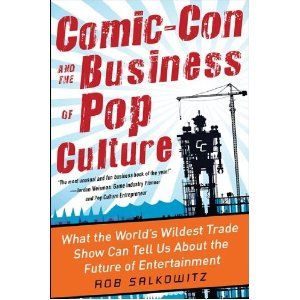
This past weekend, over 130,000 people descended on the San Diego Convention Center to take part in Comic-Con 2012. Each year, a growing amalgamation of costumed super heroes, comics geeks, sci-fi enthusiasts and die-hard fans of more mainstream entertainment pop culture mix together to celebrate and share the popular arts. Some are there to observe, some to find future employment and others to do business, as beautifully depicted in this year’s Morgan Spurlock documentary Comic-Con Episode IV: A Fan’s Hope. But Comic-Con San Diego is more than just a convention or a pop culture phenomenon. It is a symbol of the big business that comics and transmedia pop culture has become. It is a harbinger of future profits in the entertainment industry, which often uses Comic-Con to gauge buzz about releases and spot emerging trends. And it is also a cautionary tale for anyone working at the intersection of television, film, video games and publishing about the meteoric rise of an industry and the uncertainty of where it goes next. We review Rob Salkowitz’s new book Comic-Con and the Business of Pop Culture, an engaging insider perspective on the convergence of geekdom and big business.
Comic-Con wasn’t always the packed, “see and be seen” cultural juggernaut it’s become, as Salkowitz details in the early chapters of his book. In fact, 43 years ago, when the first Con was held at the US Grant hotel in San Diego, led by the efforts of comics superfan Shel Dorf, only 300 people came! In its early days, Comic-Con was a casual place where the titans of comics publishers such as DC and Marvel would gather with fans and other semi-professional artists to exchange ideas and critique one another’s work in an intimate setting. In fact, Salkowitz, a long-time Con attendee who has garnered quite a few insider perks along the way over the years, recalls that his early days of attendance were not quite so harried and frantic. The audience for Comic-Con steadily grew until about 2000, when attendance began skyrocketing, to the point that it now takes over an entire American city for a week each year. Why did this happen? Salkowitz argues that this time period is when a quantum leap shift occurred away from comic books and towards comics culture, a platform that transcends graphic novels and traditional comic books and usurps the entertainment and business matrices of television, film, video games and other “mainstream” art. Indeed, when ScriptPhD last covered Comic-Con in 2010, even their slogan changed to “celebrating the popular arts,” a seismic shift in focus and attention. (This year, Con organizers made explicit attempts to explore the history and heritage partially in order to assuage purists who argue that the event has lost sight of its roots.) In theory, this meteoric rise is wonderful, right? With all that money flowing, everyone wins! Not so fast.
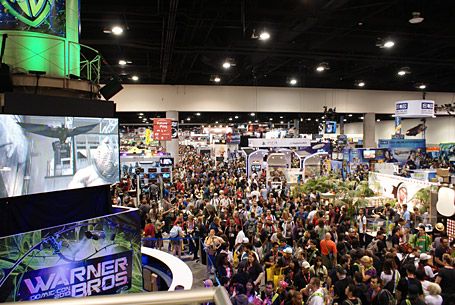
Lost amidst the pomp and circumstance of the yearly festivities is the fact that within this mixed array of cultural forces, there are cracks in the armor. For one thing, comics themselves are not doing well at all. For example, more than 70 million people bought a ticket to the 2008 movie The Dark Knight, but fewer than 70,000 people bought the July 2011 issue of Batman: The Dark Knight. Salkowitz postulates that we may be nearing the unimaginable: a “future of the comics industry that does not include comic books.” To unravel the backstory behind the upstaging of an industry at its own event, Salkowitz structures the book around the four days of the 2011 San Diego Comic-Con. In a rather clever bit of exposition, he weaves between four days of events, meetings, exclusive parties, panels of various size and one-on-one interactions to take the reader on a guided tour of Comic-Con, while in the process peeling back the layers of transmedia and business collaborations
that are the underbelly of the current “peak geek” saturation. A brief divergence to the downfall of the traditional publishing industry, including bookstores (the traditional sellers of comics), the reliance of comics on movie adaptations and the pitfalls of digital publication is a must-read primer for anyone wishing to work in the industry. Even more strapped are merchants that sell rare comics and collectibles on the convention floor. Often relegated to the side corners with famous comics artists so that entertainment conglomerates can occupy prime real estate on the floor, many dealers struggle just to break even. Among them are independent comics, self-published artists, and “alternative” comics, all hoping to cash in on the Comic-Con sweepstakes. Comics may be big business, but not for everyone. Forays into the world of grass-roots publishing, the microcosm of the yearly Eisner Awards for achievement in comics and the alternative con within a Con called Trickster (a more low-key networking event that harkens to the days of yore) all remind the reader of the tight-knit relationship that comics have with their fan base.
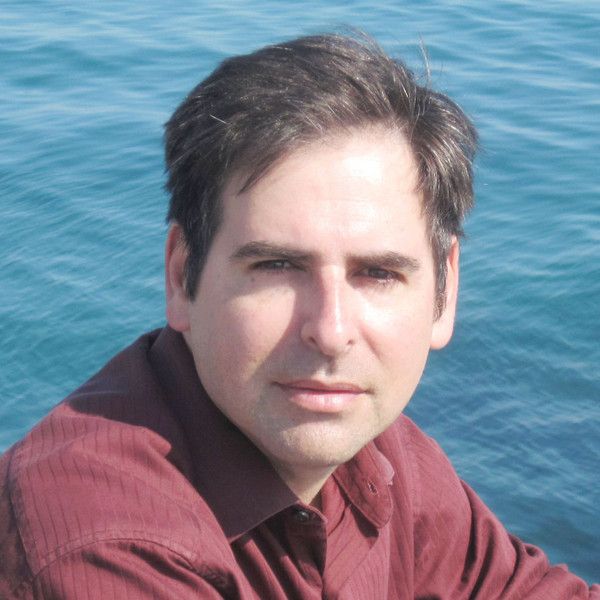
In many ways, the comics crisis that Salkowitz describes is not only very real, but difficult to resolve. The erosion of print media is unlikely to be reversed, nor is the penchant towards acquiring free content in the digital universe. Furthermore, video games, represent one of the biggest single-cause reasons for the erosion of comics in the last 20 years. Games such as Halo, Mass Effect, Grand Theft Auto and others, execute recurring linear storylines in a more cost-conscious three-dimensional interactive platform. On the other hand, there are also a myriad of reasons to be positive about the future of comics. The advent of tablets (notably the iPad) represents an unprecedented opportunity to re-establish comics’ popularity and distribution profits. Traditional and casual fans of comics haven’t gone anywhere, they’re just temporarily drowned out by the lines for the Twilight panel. A rising demographic of geek girls represents a potential growth segment in audience. And finally, a tremendous rise in popularity of traditional comics (even the classics) in global markets such as India and China portends a new global model for marketing and distribution. If superheroes are to continue as the mainstay of live-action media, the entertainment industry is highly dependent upon a viable, continued production of good stories. Movies need for comics to stay robust. The creativity and ingenuity that has been the hallmark of great comics continues to thrive with independent artists, some of whose work has gone viral and garnered publishing contracts.
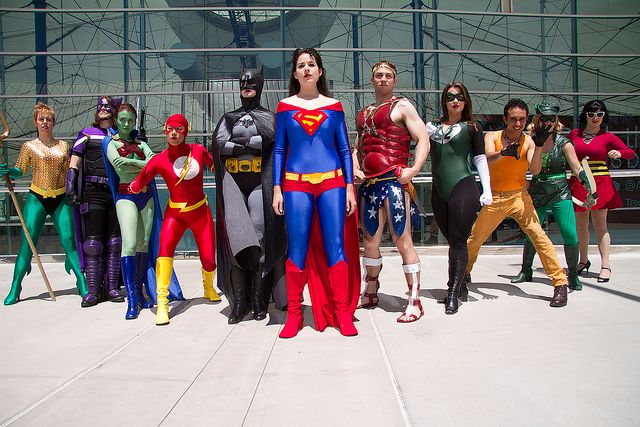
Make no mistake, comics fans and enthusiastic geeks. Comic-Con and the Business of Pop Culture is very much a business and brand strategy book, centered around a very trendy and chic brand. There’s no question that casual fans and people interested in the more technical side of comics transmedia will find it an interesting, if at times esoteric, read. But for those working in (or aspiring to) the intersection of comics and entertainment, it is an essential read. Cautioning both the entertainment and comics industries against complacency against what could be a temporary “gold rush” cultural phenomenon, Salkowitz nevertheless peppers the book with salient advice for sustaining comics-based entertainment and media, while fortifying traditional comics and their creative integrity for the next generation of fans. The final portion of the book is its strongest; a hypothetical journey several years into the future, utilizing what he calls “scenario planning” to prognosticate what might happen. Comic-Con (and all the business that it represents) might grow larger than ever, an absolute phenomenon, might scale back to account for a diminishing fan interest, might stay the same or fraction into a series of global events to account for the growing overseas interest in traditional comics. Which one will come to fruition depends on brand synergy, fan growth and engagement, distribution with digital and interactive media, and a carefully cultivated relationship between comics audiences, creators and publishers. Salkowitz calls Comic-Con a “laboratory in which the global future of media is unspooling in real time.” What will happen next? Like any good scientist knows, experiments, even under controlled circumstances, are entirely unpredictable. See you in San Diego next year!
Rob Salkowitz is the cofounder and Principal Consultant of Seattle-based MediaPlant LLC and is the author of two other books, Young World Rising and Generation Blend. He also teaches in the Digital Media program at the University of Washington. Follow Rob on Twitter.
~*ScriptPhD*~
*****************
ScriptPhD.com covers science and technology in entertainment, media and advertising. Hire our consulting company for creative content development.
Subscribe to free email notifications of new posts on our home page.
]]>
Every July, hundreds of thousands of fans descend upon the city of San Diego for a four-day celebration of comics, sci-fi, popular arts fandom and (growingly) previews of mainstream television and film blockbusters. What is this spectacular nexus of nerds? Comic-Con International, of course! From ScriptPhD’s comprehensive past coverage, one can easily glean the diversity of events, guests and panels, with enormous throngs patiently queueing to see their favorites. But who are these fans? Where do they come from? What kinds of passions drive their journeys to Comic-Con from all over the world? And what microcosms are categorized under the general umbrella of fandom? Award-winning filmmaker Morgan Spurlock attempts to answer these questions by crafting the sweet, intimate, honest documentary-as-ethnography Comic-Con Episode IV: A Fan’s Hope. Through the archetypes of five 2009 Comic-Con attendees, Spurlock guides us through the history of the Con, its growth (and the subsequent conflicts that this has engendered), and most importantly, the conclusion that underneath all of those Spider-Man and Klingon costumes, geeks really do come in all shapes, colors and sizes. For full ScriptPhD review, click “continue reading.”
In 1970, comics fan Shel Dorf organized a three-day gathering in San Diego at the US Grant hotel as a fringe gathering for the most enthusiastic amateur comics fans, aspiring artists and writers to interact with comics pros. It drew 300 fans. This was the backdrop against which young Morgan Spurlock grew up in West Virginia, passionately consuming comics and horror films, transported to a different world where everyone was a little bit askew and “weird.” “I wasn’t just a fan,” Spurlock remarks. “I was addicted.” It wasn’t until 2009 that he was able to make his first amateur journey to Comic-Con International San Diego, by now a cultural juggernaut regularly drawing over 150,000 fans, amid a vastly changed (and comics-cultural) landscape. Nevertheless, Spurlock was thrilled. He ran into boyhood idol Marvel animator Stan Lee, and thanked him for all the confidence and creativity he helped to inspire. Stan’s response? “Let’s make a documentary about Comic-Con!” And so, gathering forces with Lee, sci-fi cult icon Joss Whedon, among others, Spurlock embarked on a two-year journey that captured the 2010 Con (the 40th Anniversary edition) in all its glory—including panels, parades, photos, costumes and interviews with notable celebrities that have turned passions into professions. Most of all, however, Spurlock captured the fans.
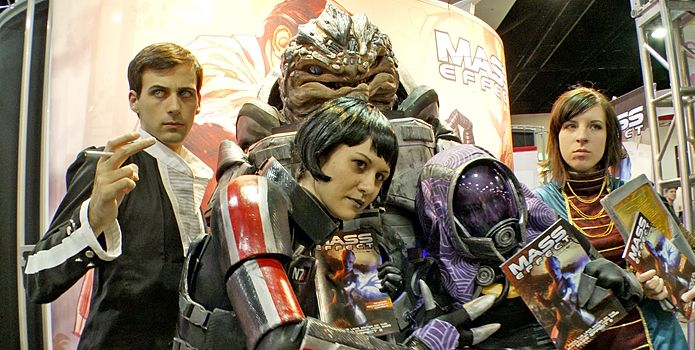
To winnow down the most compelling stories for the documentary, Spurlock held a casting call online that drew thousands of submissions. Among them was Holly Conrad, a talented, award-winning costume designer from a small town hoping to win the grand prize at the annual Comic-Con costume show. Knowing her slim odds, especially because of where she comes from, and the importance of making a splash for her career to take off, Holly called Comic-Con a “suicide mission for her future.” Also in a pressure cooker was Chuck Rozanski, proprietor of Mile High Comics, Americas largest inventory and dealer of comic books. Chuck uses the hectic, chaotic, crowded Comic-Con exhibit area to sell rare and collectible comics, comprising a substantial portion of his company’s income for the year, but faces a more fractured Con, with a smaller focus on comics every year. If he doesn’t make a killing at this year’s Com, Chuck knows the future of his whole business might be at risk. Sharing the convention floor with Chuck are comics-obsessed bartender Skip Harvey and US Airforce pilot and family man Eric Henson, two amateur graphic artists also putting their destiny on the line in San Diego. Armed with only a portfolio and a dream, Eric and Skip are hoping to get noticed at the portfolio critique sessions and land a professional design contract with one of the comics representatives. One succeeds (to the preview audience’s delight) and one learns he is a very big fish in a very small bowl, and must cultivate his talent for the greater stage. Intermingled for comic relief is the adorable story of James Darling and Se Young Kang, a couple who met and started dating at the previous year’s Con. James is planning to ask Se Young to marry him at this year’s Con, but must overcome a slew of hilarious obstacles to pull of his nerdy romantic feat.
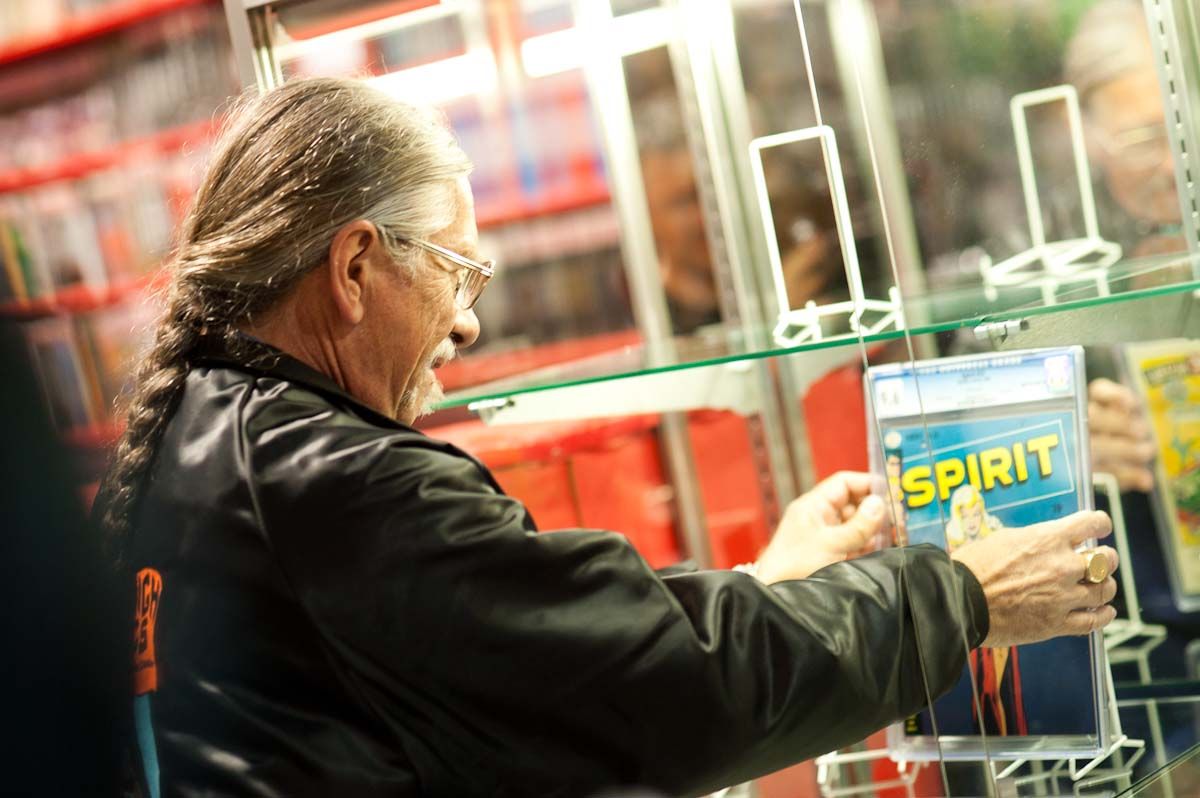
Comic-Con Episode IV: A Fan’s Hope is a terrific purview into the conflicts and dissent of the modern Con. Hidden beneath the popularity of the yearly event is a schism between older fans who have been coming for years (and feel somewhat lost in the shuffle) and the new fans, such as lovebirds James and Se Young, who may not even necessarily be there for comics events. Longtime attendees such as Kevin Smith admitted that the event has become a “beancounter” with tremendous power to preview movies and television, something Hollywood has noticed and latched onto. One can legitimately forget the presence of comics and the graphic arts at Comic-Con altogether without trying very hard. This presents a huge problem for the poignant storyline of Chuck Rozanski, with whom we empathize as he struggles to sell comics through 4-day event. When ScriptPhD.com asked Spurlock at a recent Los Angeles junket about what surprised him the most, he pointed to the sheer volume of what goes on at Comic-Con, especially the job-hunting aspect of the Comic-Con exhibition floor. His favorite moment in the movie is the comparison of Comic-Con to a Russian nesting doll, with events hidden beneath other events. “I showed the movie to people and they responded that they didn’t even know that went on at Comic-Con! There is something for everyone, no matter what your passion.” Spurlock remarked.
The documentary is at its strongest and most successful when the focus turns to what the essence of what Comic-Con is defined by—the fans. “We all weighed in with what we thought were the most important pieces of the story,” Spurlock says. “But in the end it all came back to the fans.” It is the fans whose enthusiasm drives the growth of events like Comic-Con, however much nostalgia for the past may feel threatened. It is the fans whose passion continues to motivate and drive geniuses like Stan Lee to this very day. That very same passion also launches new careers, as Holly Conrad found. Since the filming of this documentary, she has moved to Hollywood and found successful work as a costume designer on several productions. Lastly, and most importantly, it is the fans who create that magical atmosphere where no matter who you are, where you come from, what you look like, how “out there” you behave, you find total acceptance and camaraderie amongst a group of treasured friends just as passionate and devoted as you are. To Spurlock, the Con “reminds us all of the importance of dreams and of wonder. It’s not just an event… it’s a state of mind.”
Trailer for Comic-Con Episode IV: A Fan’s Hope:
“Making of” featurette:
Comic-Con Episode IV: A Fan’s Hope was released in select cities on April 5, and theaters and video on demand on April 6th.
~*ScriptPhD*~
*****************
ScriptPhD.com covers science and technology in entertainment, media and advertising. Hire our consulting company for creative content development.
Subscribe to free email notifications of new posts on our home page.
]]>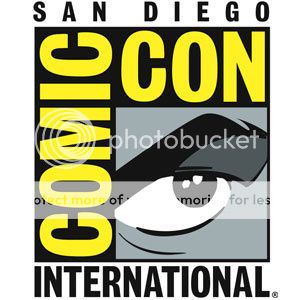
As Comic-Con winds down on the shortened Day 4, we conclude our coverage with two panels that exemplify what Comic-Con is all about. As promised, we dissect the “Comics Design” panel of the world’s top logo designers deconstructing their work, coupled with images of their work. We also bring you an interesting panel of ethnographers, consisting of undergraduate and graduate student, studying the culture and the varying forces that shape Comic-Con. Seriously, they’re studying nerds! Finally, we are delighted to shine our ScriptPhD.com spotlight on new sci-fi author Charles Yu, who presented his new novel at his first (of what we are sure are many) Comic-Con appearance. We sat down and chatted with Charles, and are pleased to publish the interview. And of course, our Day 4 Costume of the Day. Comic-Con 2010 (through the eyes of ScriptPhD.com) ends under the “continue reading” cut!
Comics Design

We are not ashamed to admit that here at ScriptPhD.com, we are secret design nerds. We love it, particularly since good design so often elevates the content of films, television, and books, but is a relatively mysterious process. One of THE most fascinating panels that we attended at Comic-Con 2010 was on the design secrets behind some of your favorite comics and book covers. A panel of the world’s leading designers revealed their methodologies (and sometimes failures) in the design process behind their hit pieces, lifting the shroud of secrecy that designers often envelop themselves in. An unparalleled purview into the mind of the designer, and the visual appeal that so often subliminally contributes to the success of a graphic novel, comic, or even regular book. We do, as it turns out, judge books by their covers.
As promised, we revisit this illuminating panel, and thank Christopher Butcher, co-founder of The Toronto Comic Arts Festival and co-owner of The Beguiling, Canada’s finest comics bookstore. Chris was kind enough to provide us with high-quality images of the Comics Design panel’s work, for which we at ScriptPhD.com are grateful. Chris had each of the graphic artists discuss their work with an example of design that worked, and design that didn’t (if available or so inclined). The artist was asked to deconstruct the logo or design and talk about the thought process behind it.
Mark Ciarello – (art + design director at DC Comics)
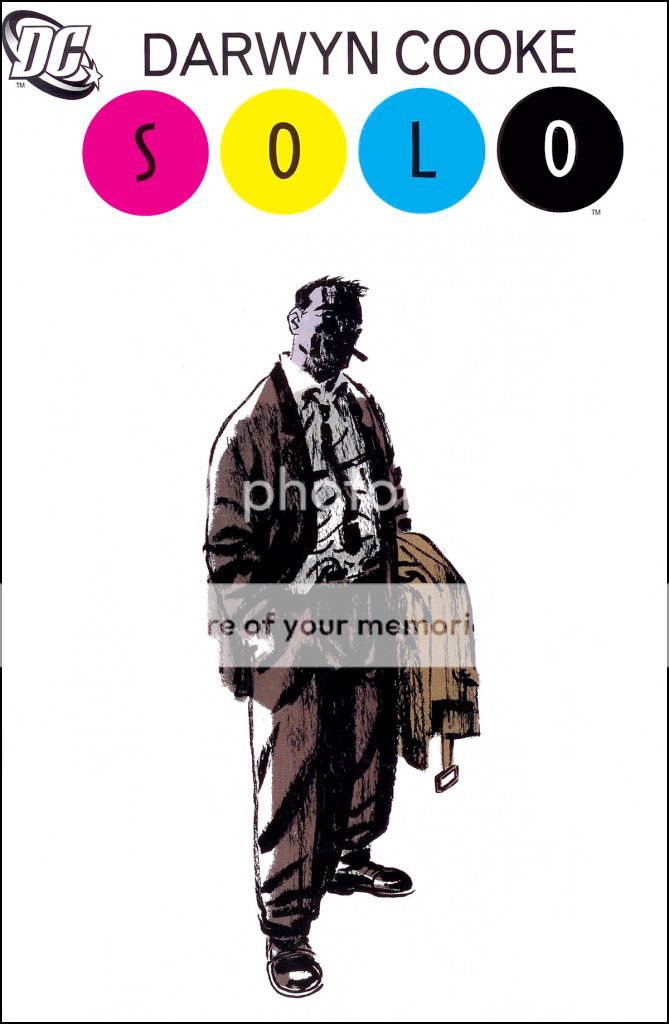
Mark chose to design the cover of this book with an overall emphasis on the individual artist. Hence the white space on the book, and a focus on the logo above the “solo” artist.
Adam Grano – (designer at Fantagraphics)
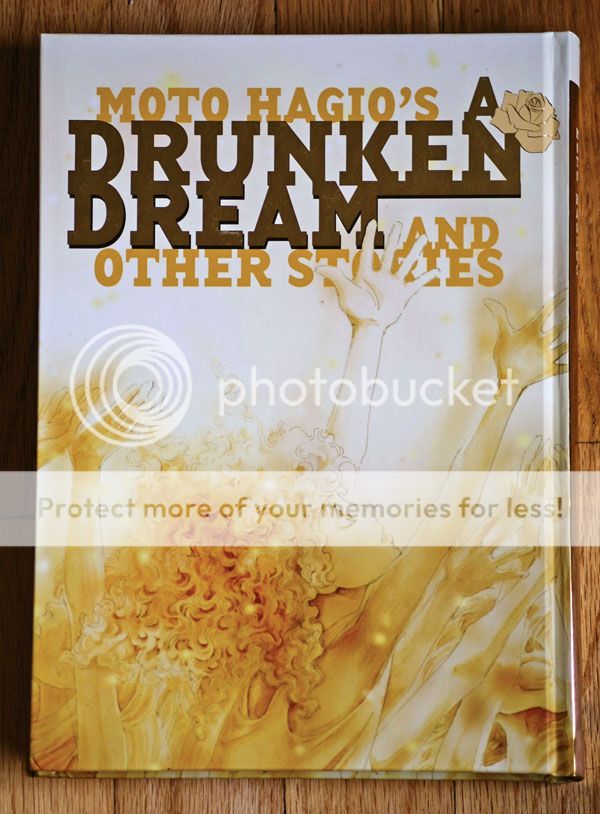
Adam took the title of this book quite literally, and let loose with his design to truly emphasize the title. He called it “method design.” He wanted the cover to look like a drunken dream.
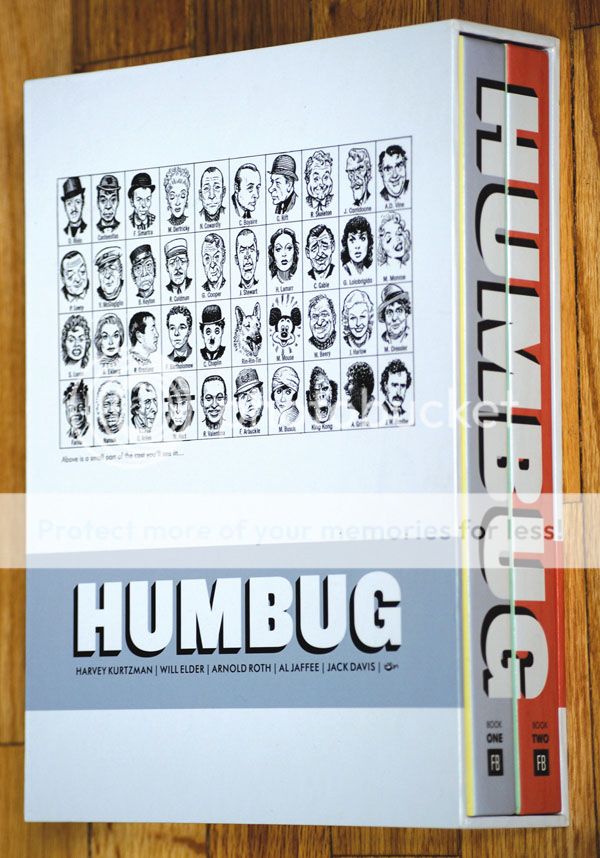
For the Humbug collection, Grano tried hard not to impress too much of himself (and his tastes) in the design of the cover. He wanted to inject simplicity in a project that would stand the test of time, because it was a collector’s series.
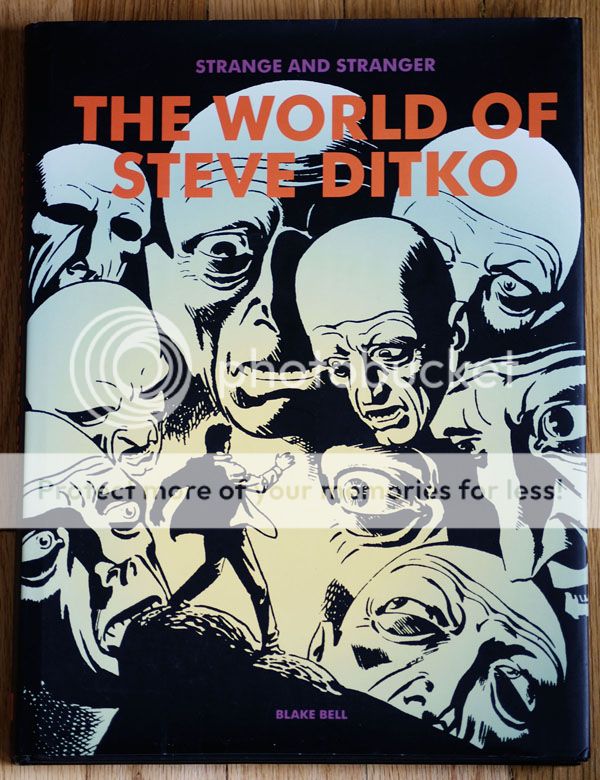
Grano considered this design project his “failure.” It contrasts greatly with the simplicity and elegance of Humbug. He mentioned that everyone on the page is scripted and gridded, something that designers try to avoid in comics.
Chip Kidd – (designer at Random House)
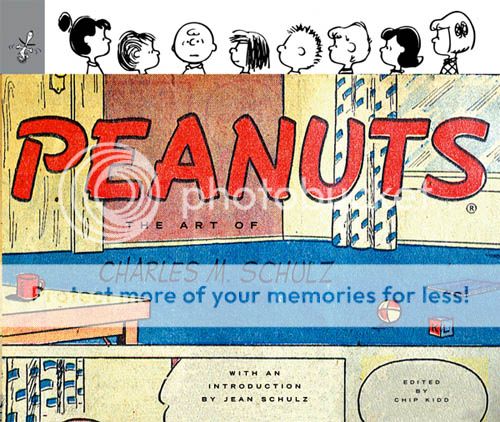
Chip Kidd had the honor of working on the first posthumous Peanuts release after Charles M. Schultz’s death, and took to the project quite seriously. In the cover, he wanted to deconstruct a Peanuts strip. All of the human element is taken out of the strip, with the characters on the cover up to their necks in suburban anxiety.
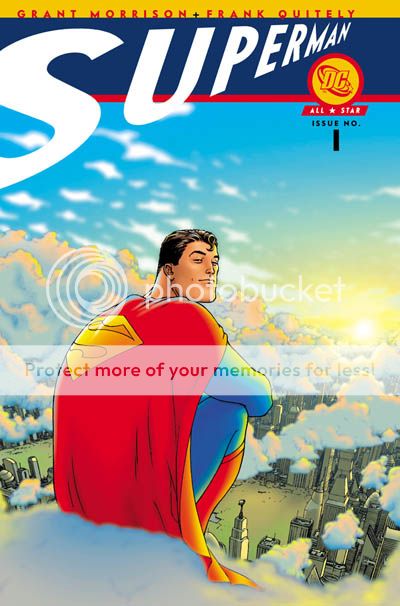
Kidd likes this cover because he considers it an updated spin on Superman. It’s not a classic Superman panel, so he designed a logo that deviated from the classic “Superman” logo to match.
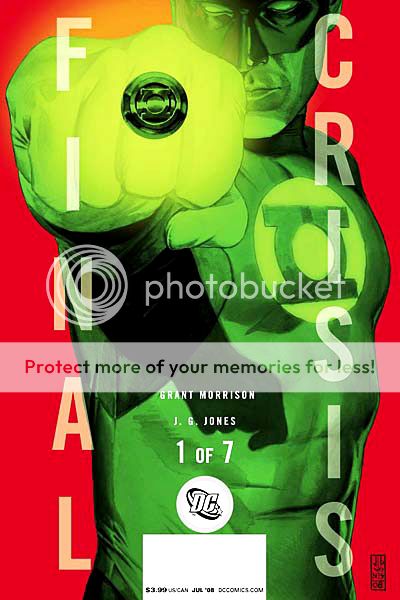
Kidd chose this as his design “failure”, but not the design itself. The cover represents one of seven volumes, in which the logo pictured disintegrates by the seventh issue, to match the crisis in the title. Kidd’s only regret here is that he was too subtle. He wishes he’d chosen to start the logo disintegration progression sooner, as there’s very little difference between the first few volumes.
Fawn Lau – (designer at VIZ)

Fawn was commissioned to redesign this book cover for an American audience. Keeping this in mind, and wanting the Japanese animation to be more legible for the American audience, she didn’t want too heavy-handed of a logo. In an utterly genius stroke of creativity, Lau went to an art store, bought $70 worth of art supplies, and played around with them until she constructed the “Picasso” logo. Clever, clever girl!
Mark Siegel – (First Second Books)
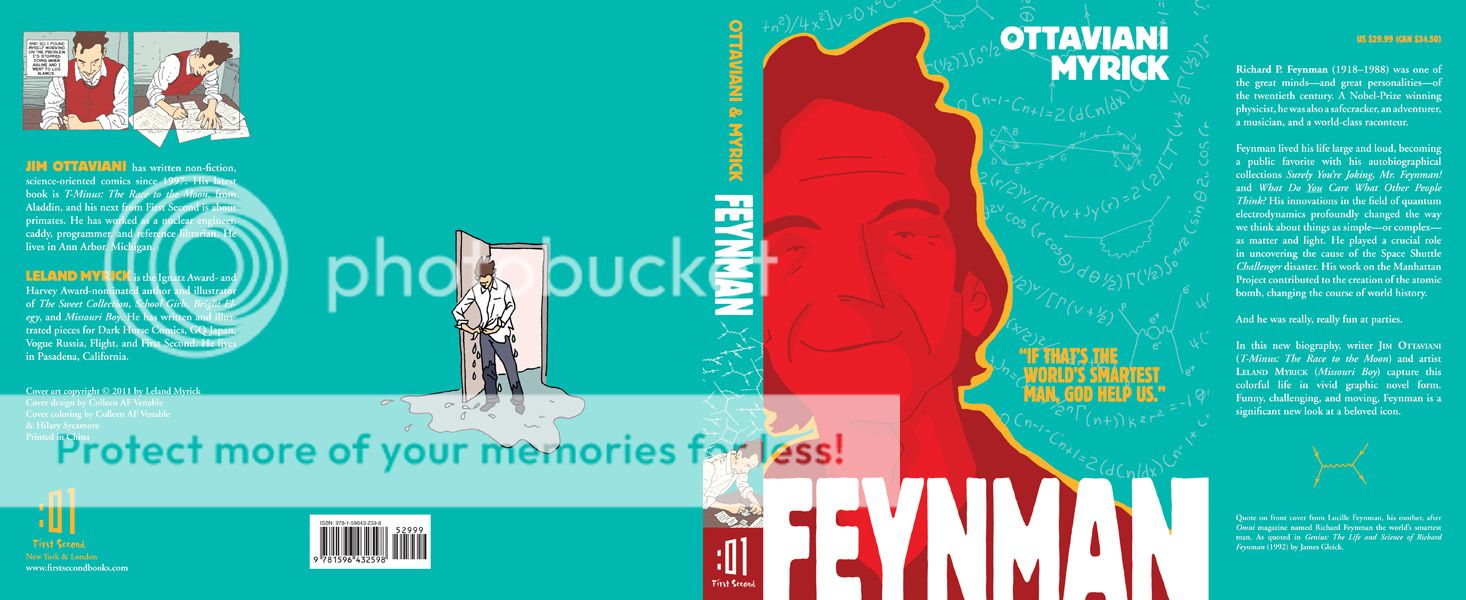
Mark Siegel was hired to create the cover of the new biography Feynman, an eponymous title about one of the most famous physicists of all time. Feynman was an amazing man who lived an amazing life, including a Nobel Prize in physics in 1965. His biographer, Ottaviani Myrick, a nuclear physicist and speed skating champion, is an equally accomplished individual. The design of the cover was therefore chosen to reflect their dynamic personalities. The colors were chosen to represent the atomic bomb and Los Alamos, New Mexico, where Feynman assisted in the development of The Manhattan Project. Incidentally, the quote on the cover – “If that’s the world’s smartest man, God help us!” – is from Feynman’s own mother.
Keith Wood – (Oni Press)
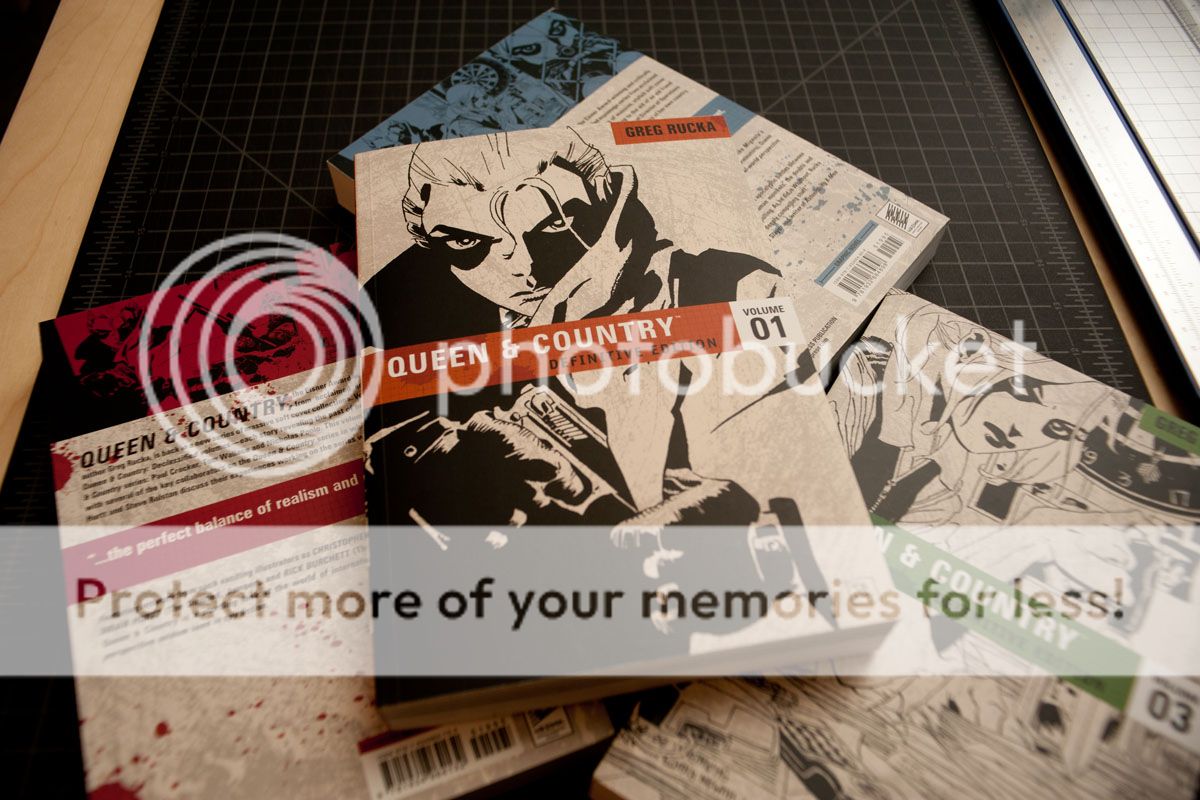
Wood remarked that this was the first time he was able to do design on a large scale, which really worked for this project. He chose a very basic color scheme, again to emphasize a collection standing the test of time, and designed all the covers simultaneously, including color schemes and graphics. He felt this gave the project a sense of connectedness.
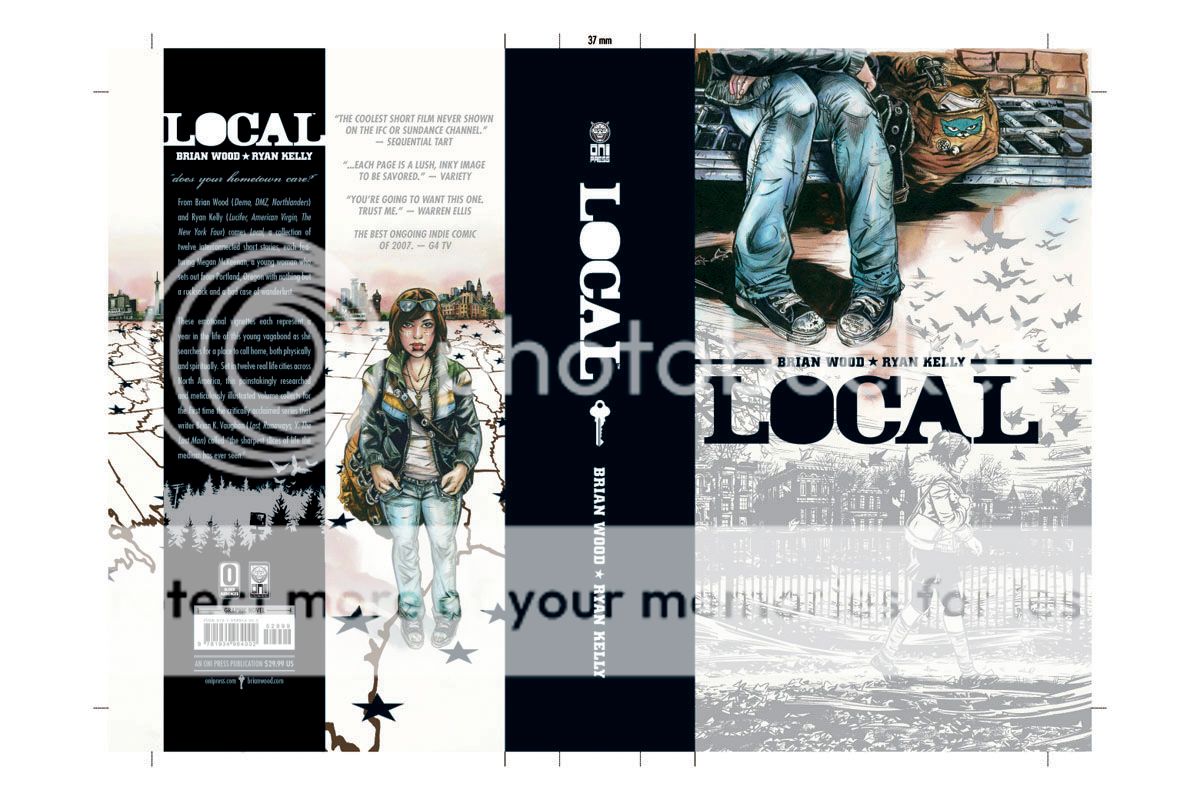
Wood chose a pantone silver as the base of this design with a stenciled typeface meant to look very modern. The back of the cover and the front of the cover were initially going to be reversed when the artists first brought him the renderings. However, Wood felt that since the book’s content is about the idea of a girl’s traveling across the United States, it would be more compelling and evocative to use feet/baggage as the front of the book. He was also the only graphic artist to show a progression of 10-12 renderings, playing with colors, panels and typeface, that led to the final design. He believes in a very traditional approach to design, which includes hand sketches and multiple renderings.
The Culture of Popular Things: Ethnographic Examinations of Comic-Con 2010

Each year, for the past four years, Comic-Con ends on an academic note. Matthew J. Smith, a professor at Wittenberg University in Ohio, takes along a cadre of students, graduate and undergraduate, to study Comic-Con; the nerds, the geeks, the entertainment component, the comics component, to ultimately understand the culture of what goes on in this fascinating microcosm of consumerism and fandom. By culture, the students embrace the accepted definition by famous anthropologist Raymond J. DeMallie: “what is understood by members of a group.” The students ultimately wanted to ask why people come to Comic-Con in general. They are united by the general forces of being fans; this is what is understood in their group. After milling around the various locales that constituted the Con, the students deduced that two ultimate forces were simultaneously at play. The fan culture drives and energizes the Con as a whole, while strong marketing forces were on display in the exhibit halls and panels.
Maxwell Wassmann, a political economy student at Wayne State University, pointed out that “secretly, what we’re talking about is the culture of buying things.” He compared Comic-Con as a giant shopping mall, a microcosm of our economic system in one place. “If you’ve spent at least 10 minutes at Comic-Con,” he pointed out, “you probably bought something or had something tried to be sold to you. Everything is about marketing.” As a whole, Comic-Con is subliminally designed to reinforce the idea that this piece of pop culture, which ultimately advertises an even greater subset of pop culture, is worth your money. Wassmann pointed out an advertising meme present throughout the weekend that we took notice of as well—garment-challenged ladies advertising the new Green Hornet movie. The movie itself is not terribly sexy, but by using garment-challenged ladies to espouse the very picture of the movie, when you leave Comic-Con and see a poster for Green Hornet, you will subconsciously link it to the sexy images you were exposed to in San Diego, greatly increasing your chances of wanting to see the film. By contrast, Wassmann also pointed out that there is a concomitant old-town economy happening; small comics. In the fringes of the exhibition center and the artists’ space, a totally different microcosm of consumerism and content exchange.

Kane Anderson, a PhD student at UC Santa Barbara getting his doctorate in “Superheroology” (seriously, why didn’t I think of that back in graduate school??), came to San Diego to observe how costumes relate to the superhero experience. To fully absorb himself in the experience, and to gain the trust of Con attendees that he’d be interviewing, Anderson came in full costume (see above picture). Overall, he deduced that the costume-goers, who we will openly admit to enjoying and photographing during our stay in San Diego, act as goodwill ambassadors for the characters and superheroes they represent. They also add to the fantasy and adventure of Comic-Con goers, creating the “experience.” The negative side to this is that it evokes a certain “looky-loo” effect, where people are actively seeking out, and singling out, costume-wearers, even though they only constitute 5% of all attendees.
Tanya Zuk, a media masters student from the University of Arizona, and Jacob Sigafoos, an undergraduate communications major at Wittenberg University, both took on the mighty Hollywood forces invading the Con, primarily the distribution of independent content, an enormous portion of the programming at Comic-Con (and a growing presence on the web). Zuk spoke about original video content, more distinctive of new media, is distributed primarily online. It allows for more exchange between creators and their audience than traditional content (such as film and cable television), and builds a community fanbase through organic interaction. Sigafoos expanded on this by talking about how to properly market such material to gain viral popularity—none at all! Lack of marketing, at least traditional forms, is the most successful way to promote a product. Producing a high-quality product, handing it off to friends, and promoting through social media is still the best way to grow a devoted following.
And speaking of Hollywood, their presence at Comic-Con is undeniable. Emily Saidel, a Master’s student at NYU, and Sam Kinney, a business/marketing student at Wittenberg University, both took on the behemoth forces of major studios hawking their products in what originally started out as a quite independent gathering. Saidel tackled Hollywood’s presence at Comic-Con, people’s acceptance/rejection thereof, and how comics are accepted by traditional academic disciplines as didactic tools in and of themselves. The common thread is a clash between the culture and the community. Being a member of a group is a relatively simple idea, but because Comic-Con is so large, it incorporates multiple communities, leading to tensions between those feeling on the outside (i.e. fringe comics or anime fans) versus those feeling on the inside (i.e. the more common mainstream fans). Comics fans would like to be part of that mainstream group and do show interest in those adaptations and changes (we’re all movie buffs, after all), noted Kinney, but feel that Comic-Con is bigger than what it should be.
But how much tension is there between the different subgroups and forces? The most salient example from last year’s Con was the invasion of the uber-mainstream Twilight fans, who not only created a ruckus on the streets of San Diego, but also usurped all the seats of the largest pavilion, Hall H, to wait for their panel, locking out other fans from seeing their panels. (No one was stabbed.) In reality, the supposed clash of cultures is blown out of proportion, with most fans not really feeling the tension. To boot, Seidel pointed out that tension isn’t necessarily a bad thing, either. She gave a metaphor of a rubber band, which only fulfills its purpose with tension. The different forces of Comic-Con work in different ways, if sometimes imperfectly. And that’s a good thing.
Incidentally, if you are reading this and interested in participating in the week-long program in San Diego next year, visit the official website of the Comic-Con field study for more information. Some of the benefits include: attending the Comic-Con programs of your choice, learning the tools of ethnographic investigation, and presenting the findings as part of a presentation to the Comics Arts Conference. Dr. Matthew Smith, who leads the field study every year, is not just a veteran attendee of Comic-Con, but also the author of The Power of Comics.
COMIC-CON SPOTLIGHT ON: Charles Yu, author of How To Live Safely in a Science Fictional Universe.
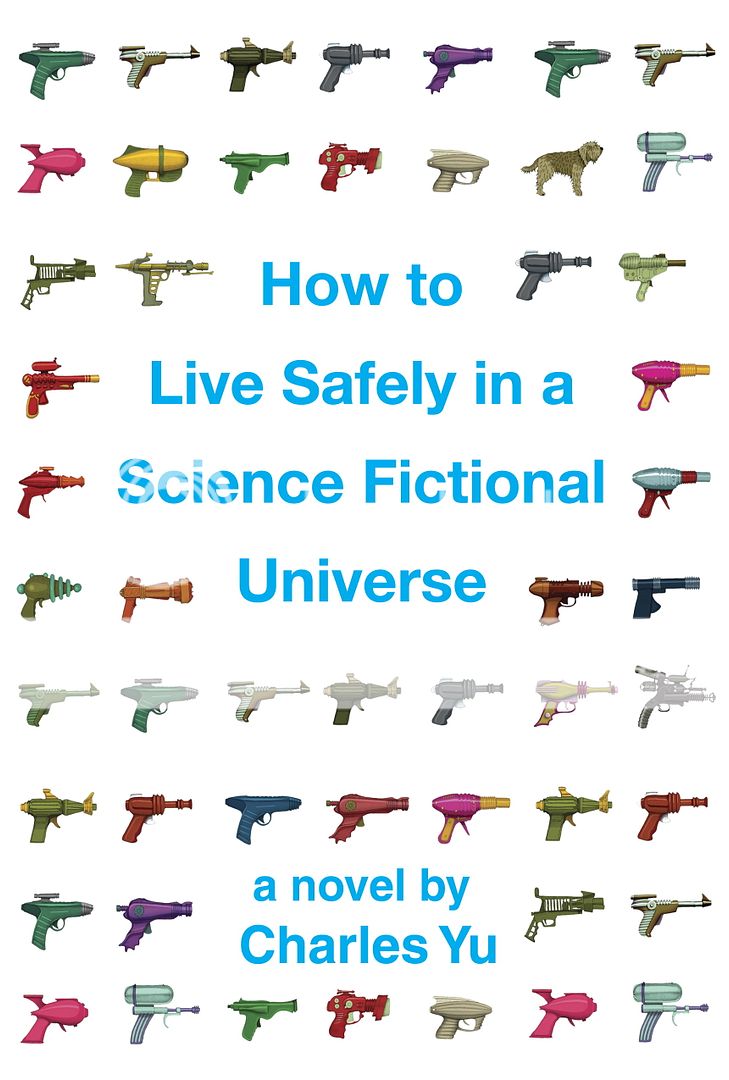
Here at ScriptPhD.com, we love hobnobbing with the scientific and entertainment elite and talking to writers and filmmakers at the top of their craft as much as the next website. But what we love even more is seeking out new talent, the makers of the books, movies and ideas that you’ll be talking about tomorrow, and being proud to be the first to showcase their work. This year, in our preparation for Comic-Con 2010, we ran across such an individual in Charles Yu, whose first novel, How To Live Safely in a Science Fictional Universe premieres this fall, and who spoke about it at a panel over the weekend. We had an opportunity to have lunch with Charles in Los Angeles just prior Comic-Con, and spoke in-depth about his new book, along with the state of sci-fi in current literature. We’re pretty sure Charles Yu is a name science fiction fans are going to be hearing for some time to come. ScriptPhD.com is proud to shine our 2010 Comic-Con spotlight on Charles and his debut novel, which is available September 7, 2010.
How To Live Safely in a Science Fictional Universe is the story of a son searching for his father… through quantum-space time. The story takes place on Minor Universe 31, a vast story-space on the outskirts of fiction, where paradox fluctuates like the stock market, lonely sexbots beckon failed protagonists, and time travel is serious business. Every day, people get into time machines and try to do the one thing they should never do: try to change the past. That’s where the main character, Charles Yu, time travel technician, steps in. Accompanied by TAMMY (who we consider the new Hal), an operating system with low self-esteem, and a nonexistent but ontologically valid dog named Ed, Charles helps save people from themselves. When he’s not on the job, Charles visits his mother (stuck in a one-hour cycle, she makes dinner over and over and over) and searches for his father, who invented time travel and then vanished.
Questions for Charles Yu
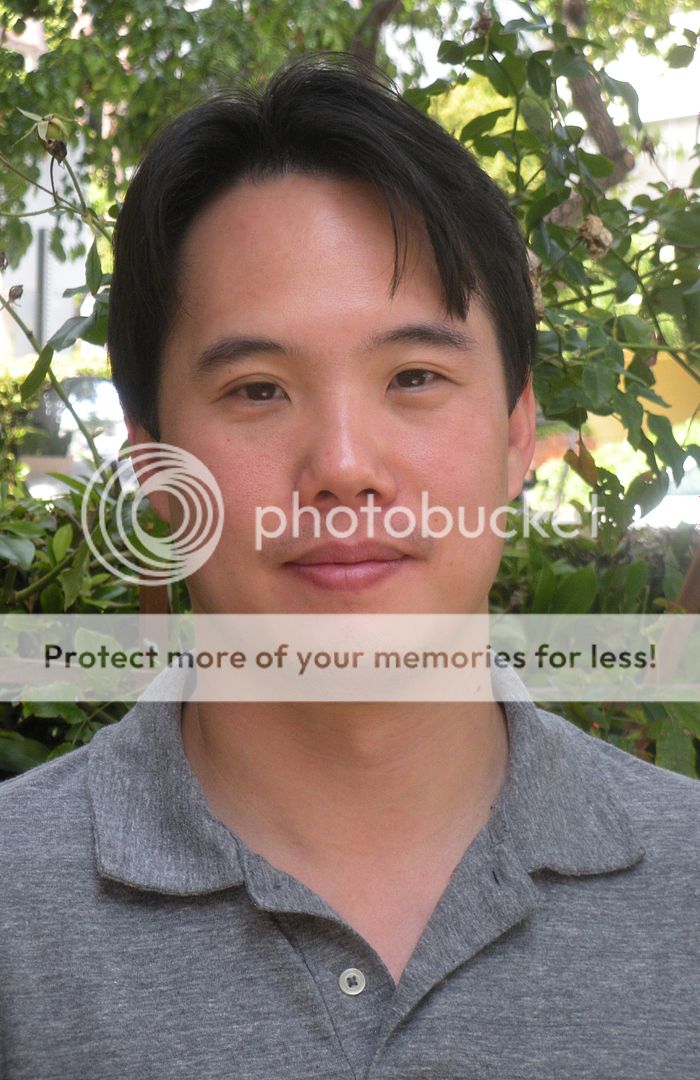
ScriptPhD.com: Charles, the story has tremendous traditional sci-fi roots. Can you discuss where the inspiration for this came from?
Charles Yu: Well the sci-fi angle definitely comes from being a kid in the 80s, when there were blockbuster sci-fi things all over the place. I’ve always loved [that time], as a casual fan, but also wanted to write it. I didn’t even start doing that until after I’d graduated from law school. I did write, growing up, but I never wrote fiction—I didn’t think I’d be any good at it! I wrote poetry in college, minored in it, actually. Fiction and poetry are both incredibly hard, and poetry takes more discipline, but at least when I failed in my early writing, it was a 100 words of failure, instead of 5,000 words of it.
SPhD: What were some of your biggest inspirations growing up (television or books) that contributed to your later work?
CY: Definitely The Foundation Trilogy. I remember reading that in the 8th grade, and I remember spending every waking moment reading, because it was the greatest thing I’d ever read. First of all, I was in the 8th grade, so I hadn’t read that many things, but the idea that Asimov created this entire self-contained universe, it was the first time that I’d been exposed to that idea. And then to have this psychohistory on top, it was kind of trippy. Psychohistory is the idea that social sciences can be just as rigorously captured with equations as any physical science. I think that series of books is the main thing that got me into sci-fi.
SPhD: Any regrets about having named the main character after yourself?
CY: Yes. For a very specific reason. People in my life are going to think it’s biographical, which it’s very much not. And it’s very natural for people to do that. And in my first book of short stories, none of the main characters was named after anyone, and still I had family members that asked if that was about our family, or people that gave me great feedback but then said, “How could you do that to your family?” And it was fiction! I don’t think the book could have gotten written had I not left that placeholder in, because the one thing that drove any sort of emotional connection for the story for me was the idea of having less things to worry about. The other thing is that because the main character is named after you, as you’re writing the book, it acts as a fuel or vector to help drive the emotional completion.
SPhD: In the world of your novel, people live in a lachrymose, technologically-driven society. Any commentary therein whatsoever on the technological numbing of our own current culture?
CY: Yes. But I didn’t mean it as a condemnation, in a sense. I wouldn’t make an overt statement about technology and society, but I am more interested in the way that technology can sometimes not connect people, but enable people’s tendency to isolate themselves. Certainly, technology has amazing connective possibilities, but that would have been a much different story, obviously. The emotional plot-level core of this book is a box. And that sort of drove everything from there. The technology is almost an emotional technology that [Charles, the main character] has invented with his dad. It’s a larger reflection of his inability to move past certain limitations that he’s put on himself.
SPhD: What drives Charles, the main character of this book?
CY: What’s really driving Charles emotionally is looking for his dad. But more than that, is trying to move through time, to navigate the past without getting stuck in it.
SPhD: Both of his companions are non-human. Any significance to that?
CY: It probably speaks more to my limitations as a writer [laughs]. That was all part of the lonely guy type that Charles is being portrayed as. If he had a human with him, he’d be a much different person.
SPhD: The book abounds in scientific jargon and technological terminology, which is par for the course in science fiction, but was still very ambitious. Do you have high expectations of the audience that will read this book?
CY: Yeah. I was just reading an interview where the writer essentially said “You can never go wrong by expecting too much [of your audience].” You can definitely go wrong the other way, because that would come off as terrible, or assuming that you know more. But actually, my concerns were more in the other direction, because I knew I was playing fast and loose with concepts that I know I don’t have a great grasp of. I’m writing from the level of amateur who likes reading science books, and studied science in college—an entertainment layreader. My worry was whether I was BSing too much [of the science]. There are parts where it’s clearly fictional science, but there are other parts that I cite things that are real, and is anyone who reads this who actually knows something about science going to say “What the heck is this guy saying?”
SPhD: How To Live… is written in a very atavistic, retro 80s style of science fiction, and really reminded me of the best of Isaac Asimov. How do you feel about the current state of sci-fi literature as relates to your book?
CY: Two really big keys for me, and things I was thinking about while writing [this book], were one, there is kind of a kitchiness to sci-fi, and I think that’s kind of intentional. It has a kind of do-it-yourself aesthetic to it. In my book, you basically have a guy in the garage with his dad, and yes the dad is an engineer, but it’s in a garage without great equipment, so it’s not going to look sleek, you can imagine what it’s going to look like—it’s going to look like something you’d build with things you have lying around in the garage. On the other hand, it is supposed to be this fully realized time machine, and you’re not supposed to be able to imagine it. Even now, when I’m in the library in the science-fiction section, I’ll often look for anthologies that are from the 80s, or the greatest time travel stories from the 20th Century that cover a much greater range of time than what’s being published now. It’s almost like the advancement of real-world technology is edging closer to what used to be the realm of science fiction. The way that I would think about that is that it’s not exploting what the real possibility of science fiction is, which is to explore a current world or any other completely strange world, but not a world totally envisionable ten years from now. You end up speculating on what’s possible or what’s easily extrapollatable from here; that’s not necessarily going to make for super emotional stories.
Charles Yu is a writer and attorney living in Los Angeles, CA.
Last, but certainly not least, is our final Costume of the Day. We chose this young ninja not only because of the coolness of his costume, but because of his quick wit. As we were taking the snapshot he said, “I’m smiling, you just can’t see it.” And a check mate to you, young sir.
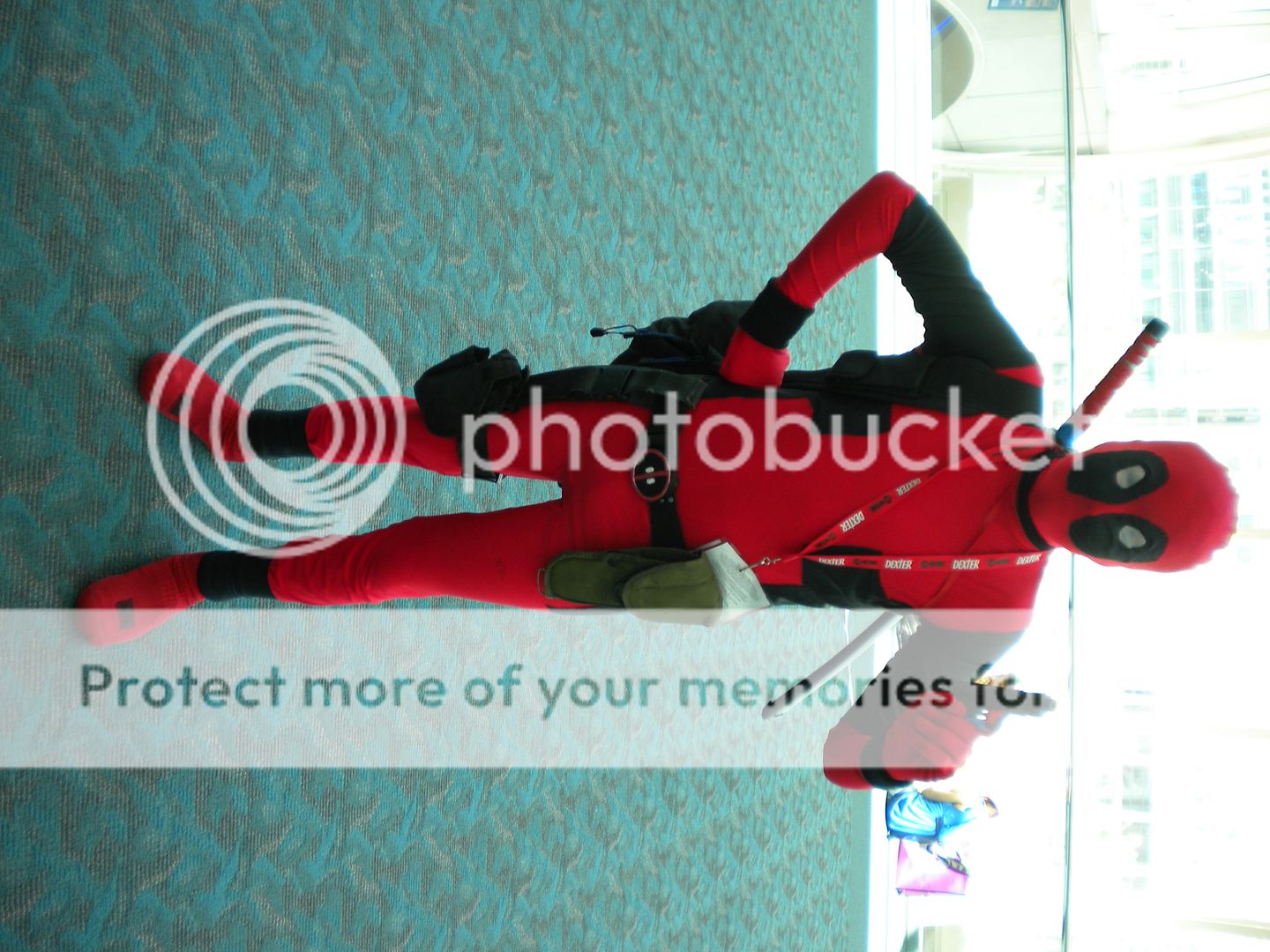
Incidentally, you can find much more photographic coverage of Comic-Con on our Facebook fan page. Become a fan, because this week, we will be announcing Comic-Con swag giveaways that only Facebook fans are eligible for.
~*ScriptPhD*~
*****************
ScriptPhD.com covers science and technology in entertainment, media and advertising. Hire our consulting company for creative content development.
Subscribe to free email notifications of new posts on our home page.
]]>
Day 2 of Comic-Con is over and now, the Convention is really underway! Today’s ScriptPhD.com coverage has a heavy focus on television, and sci-fi television to be specific. Really, is there any other kind? We spent time in the press room with the stars and producers of SyFy Channel hits Caprica and Stargate Universe, our favorite geeky physics show Big Bang Theory and the exciting (first-time ever!) Comic-Con Discovery Channel unveiling of their new scripted series Reign of the Dinosaurs. As always we try to pay hommage to the roots of Comic-Con with coverage of the design tricks behind comics and graphic novels. Additionally, we provide pictorial documentation of the costumes and happenings of the Con, and our Day 2 Costume of the Day. Complete coverage under the “continue reading” cut.
From the Press Room: Stargate Universe
We were delighted to start our day with the cast of one of our favorite sci-fi shows on the air, Stargate Universe, to get a little peek into the cast’s geeky sides and what they think of their characters and show.

For star David Blue, playing the ship’s resident math geek Eli Wallace, this year is a completely different experience. Last year, there was so much uncertainty about the show’s acceptance and success, while this year, the cast walks into Comic-Con confident of where they are headed. He spoke of liking the idea of Eli as a hero, the show’s surrogate for the audience. Though he admits to being a geek, he was very hesitant to play the role when he heard about it, because of his previous computer nerd role on Moonlight for fear of typecasting. But Eli is not a stereotypical nerd, and experiences a lot more emotional and character growth over the course of Season 2. “I am proud to be a geek/nerd,” Blue says. “Everything from computer programming to comic books to video games.”
We were so thrilled to hear that David was a certified Grade A USDA organic geek, that we got him to proclaim so on camera for you guys:
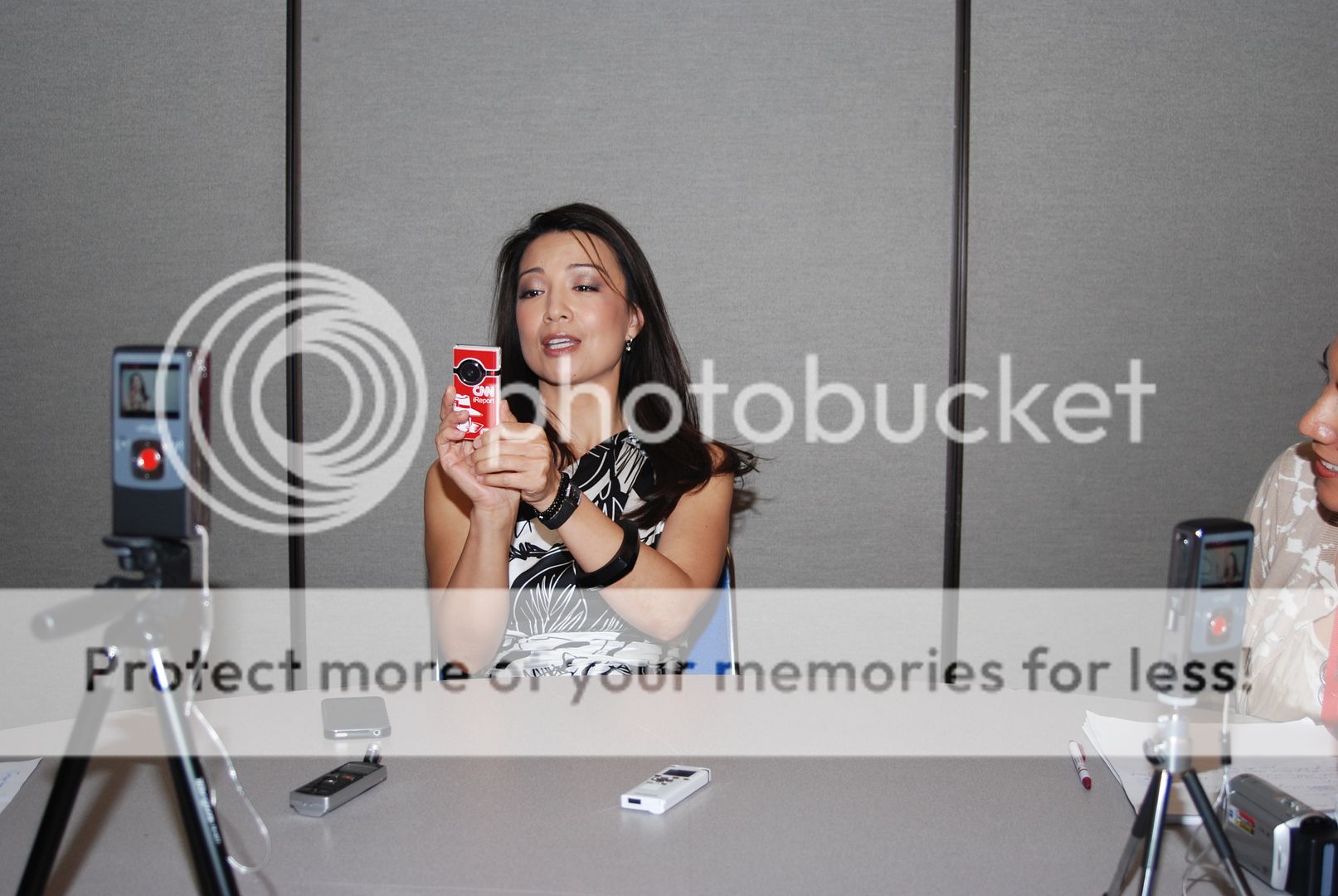
Ming-Na, whose character Camile Wray is far more controversial and decisive on the show, was asked right off the bat what she’d do differently in real life as opposed to her character. “Well, I wouldn’t be a lesbian,” the married actress quipped. Turning more serious, she said that she wouldn’t be as level-headed and calm as her character, who is often asked to make difficult, morally ambiguous decisions based on emotional issues. The fan’s response to Camile is largely a love-hate relationship. She’s gotten great response from the gay community, something that Na appreciates, but Camile’s escape from cliches or stereotypes is something that has resonated. The morally wrenching decisions are a staple of the show (and sci-fi television in general), and will only continue into Season 2. “You may not like her decisions,” says Na, “But I like her.”
From the Press Room: Caprica

One of the most pivotal roles in the history of sci-fi television (the first Cylon) went to a girl that didn’t even really know the significance of the part. “I didn’t know what Battlestar was before I got the role,” admits Torresani, who was not a real sci-fi geek growing up. “I actually turned it down because I didn’t want to do [Caprica]. I wanted to do [Gossip Girl-type fluff]. It’s exciting now to [realize how important the role is], but it wasn’t nerve-wracking at the beginning. When I read the pilot, she was a spoiled brat, and then she gets in a robot. We didn’t know that I was going to be a Cylon. We just thought they’d use my voice and the robot’s body.” Filming the scenes as the Cylon, Torresani revealed, involves acting next to a giant green 7′ tall stick that everyone communicates with as the Cylon. She finds that the hardest part for her as an actress are scenes as the Cylon where she can’t communicate vocally, such as being lit on fire and not being able to utter a single word. “It’s really challenging. That’s something I never thought I’d have to do.”
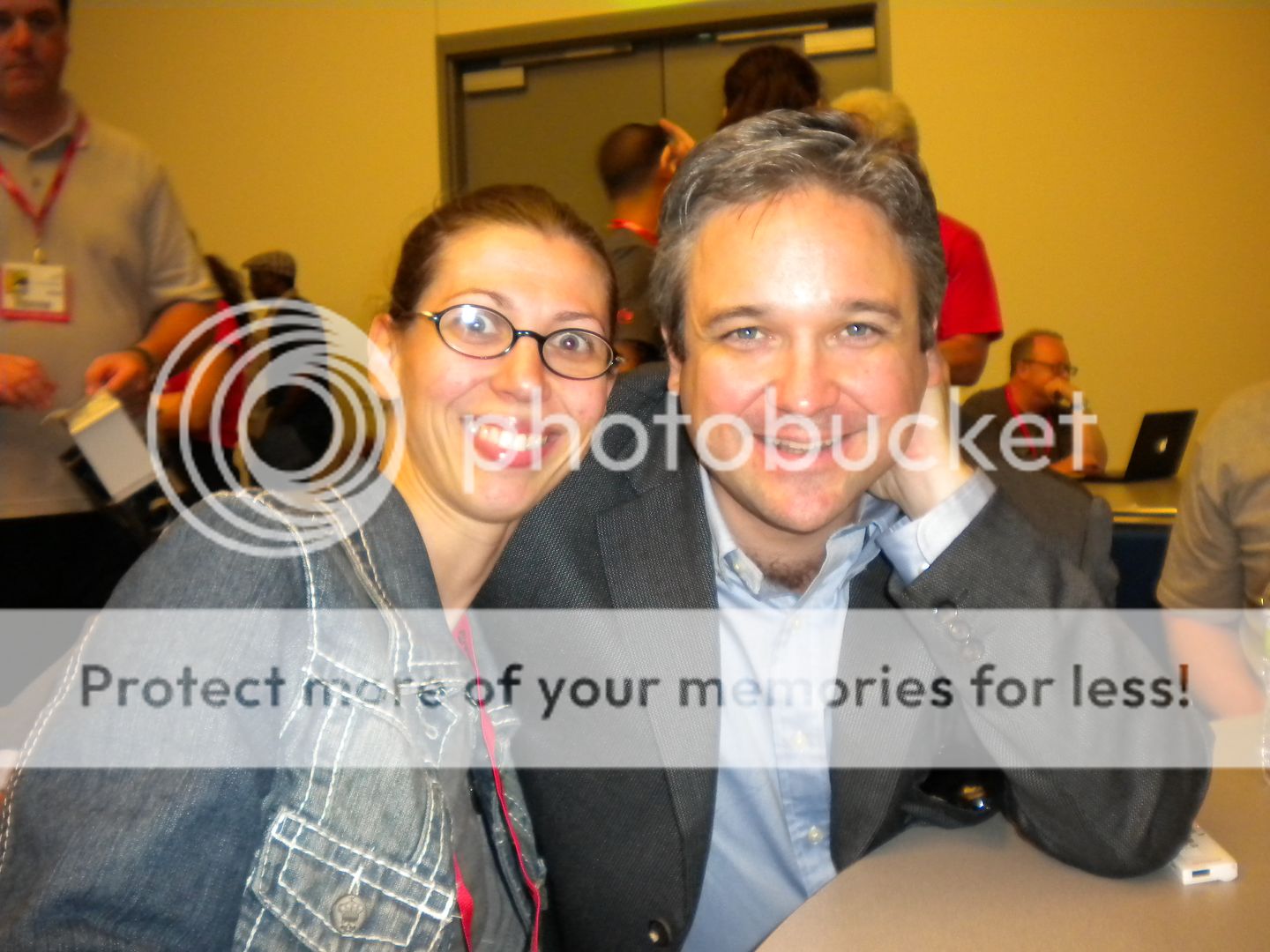
We started our time with executive producer David Eick with a humdinger—the question we know fans would want to ask. What has been the producers’ reaction to mixed reviews and fan division of the show, most notably from the Battlestar Galactica fanbase? “We knew to expect a much greater mix [of opinions] because we knew going in that we were not going to craft it or market it as a spin-off of Battlestar,” replied Eick. Rather than containing cheeky references to BSG or inside jokes only the audience knows, Caprica is very much its own beast. He hopes fervently that as the show finds itself and its own focus, that the audience, too, would find its own way in the show. He reminded us that the early days of Battlestar were equally contentious in terms of critical and fan opinions. “The very first Comic-Con we came to for Battlestar was like George W. Bush showing up at an ACLU rally.”
In many ways, he feels more challenged by Caprica, which lacks the ticking time-clock feel of BSG. It’s a more sophisticated style of storytelling, which is based in defining the characters and the world around then, Rome before the fall. The mythology of that world is deepened as the show progresses, and how it’s harnessed by Zoey to express herself. Eick spoke of how much more graceful and elegant Caprica is visually and content-wise, with Blade Runner being a huge influence on the producers and writers. By contrast, BSG had much more of a Black Hawk Down, action feel to it.
By the way, Ron and David have a longstanding tradition of taking a drink of tequila together before either a major show launch or major seminar/Convention. In fact, David brought the bottle and we all had a little fun. Kidding. But seriously, folks, next time you think the storylines on Caprica are getting a liiiiiiiittle wacky, just remember this picture:
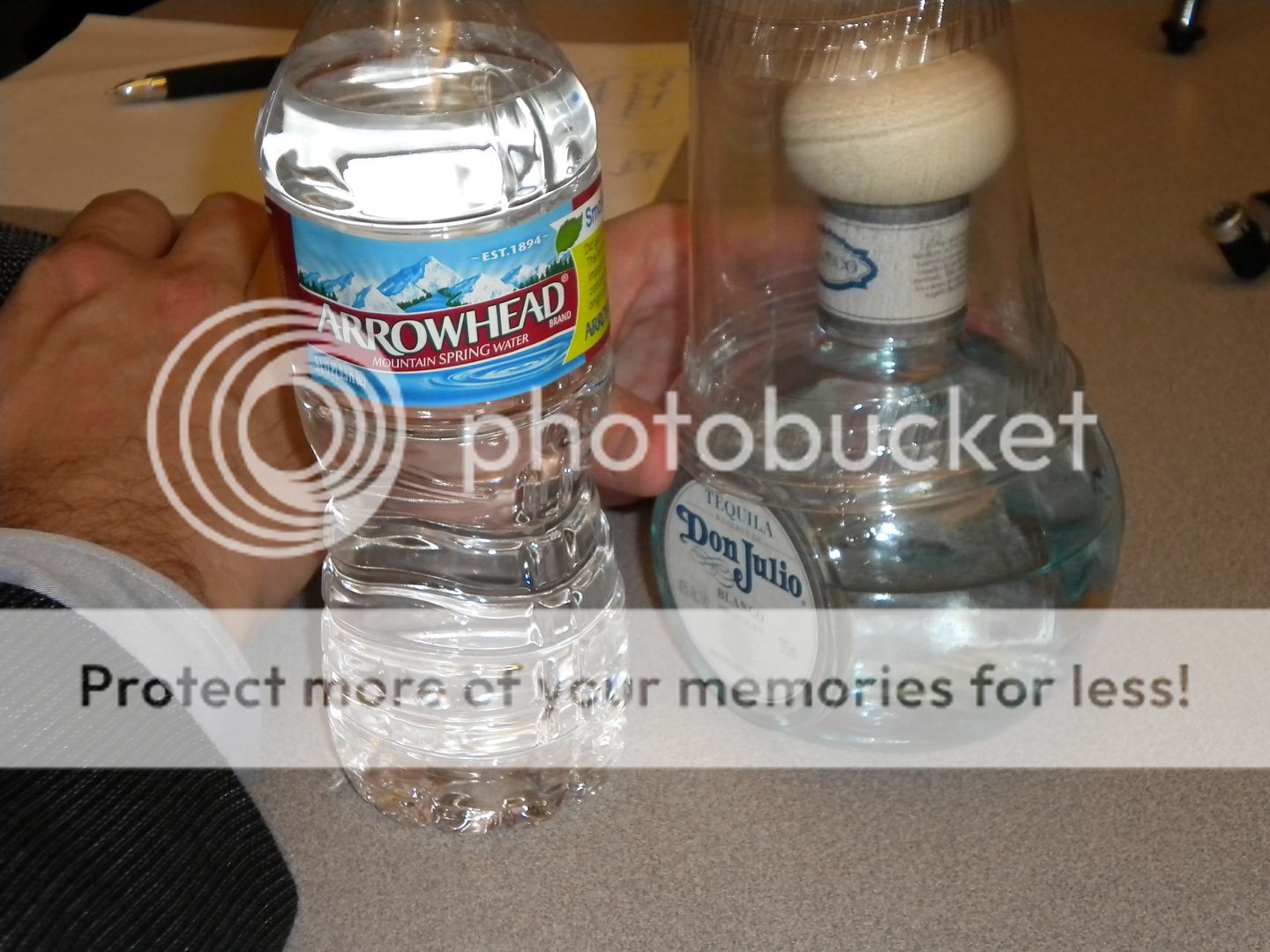
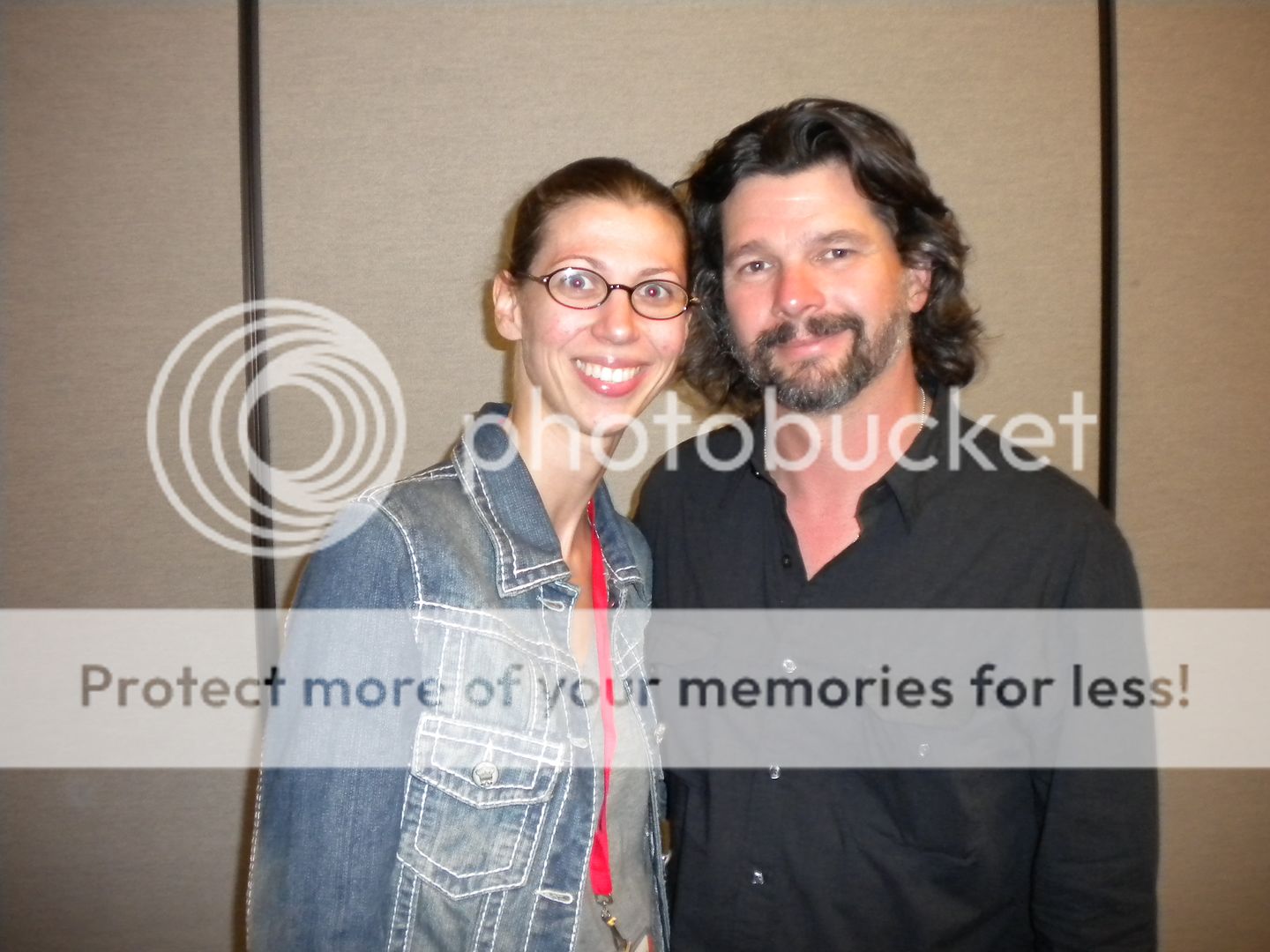
Ronald D. Moore, who made a rare media appearance at Comic-Con this year, largely echoed Eick’s comments. Caprica, he maintained is a serial, and (purposefully) as different from Battlestar Galactica as possible. In an even rarer move, Moore openly self-criticized himself for some of the early hiccups of the show. He admitted that it was hard to follow, that the story was indeed confusing, but that the show gained confidence as it went on. He predicted as strong of a build-up for Caprica as the eventual success of Battlestar Galactica. Another fun tidbit that Moore revealed was that the group marriage concept was tossed around for Battlestar Galactica, but just never found the story or the characters to make it happen.
We asked Ron about his thoughts on the current state of sci-fi and what he enjoys. “I’m probably not up to speed on a lot of other science fiction,” Moore said. “I almost avoid it now because I spend so much of my time in a science fiction world that I tend not to go there. It becomes almost like more work to watch other science fiction shows. In my brain, I’m inevitably thinking ‘How does that compare to us? And that’s their structure. How many characters do they have? I wonder what their CGI budget was.’ I haven’t watched a lot of other science fiction television for that reason.” Nevertheless, he maintains that it’s a thriving genre that will always be with us, despite the rise and fall of popularity. The one holy grail Moore hopes for is a broadcast network (read mainstream) sci-fi hit. He isn’t sure what the reason is that this popularity has remained so elusive, LOST notwithstanding. “Maybe it’s just us,” he mused. “Maybe it’s just us [the collective sci-fi geekdom], and there’s not this gigantic mass market for it in television in the way that there is a gigantic mass market for movies. Maybe that will never happen.”
We here at ScriptPhD.com hope otherwise.
From the Press Room: Big Bang Theory
If Ronald D. Moore is concerned about the viability of a basic network science fiction hit, at least he can take solace in Big Bang Theory, arguably the smartest, most successful, streamlined show about science and scientists in the history of television. We had such a fun time hanging out with the actors last year, that this year, with access to the full production team, we decided to get as much scoop from the show as possible.
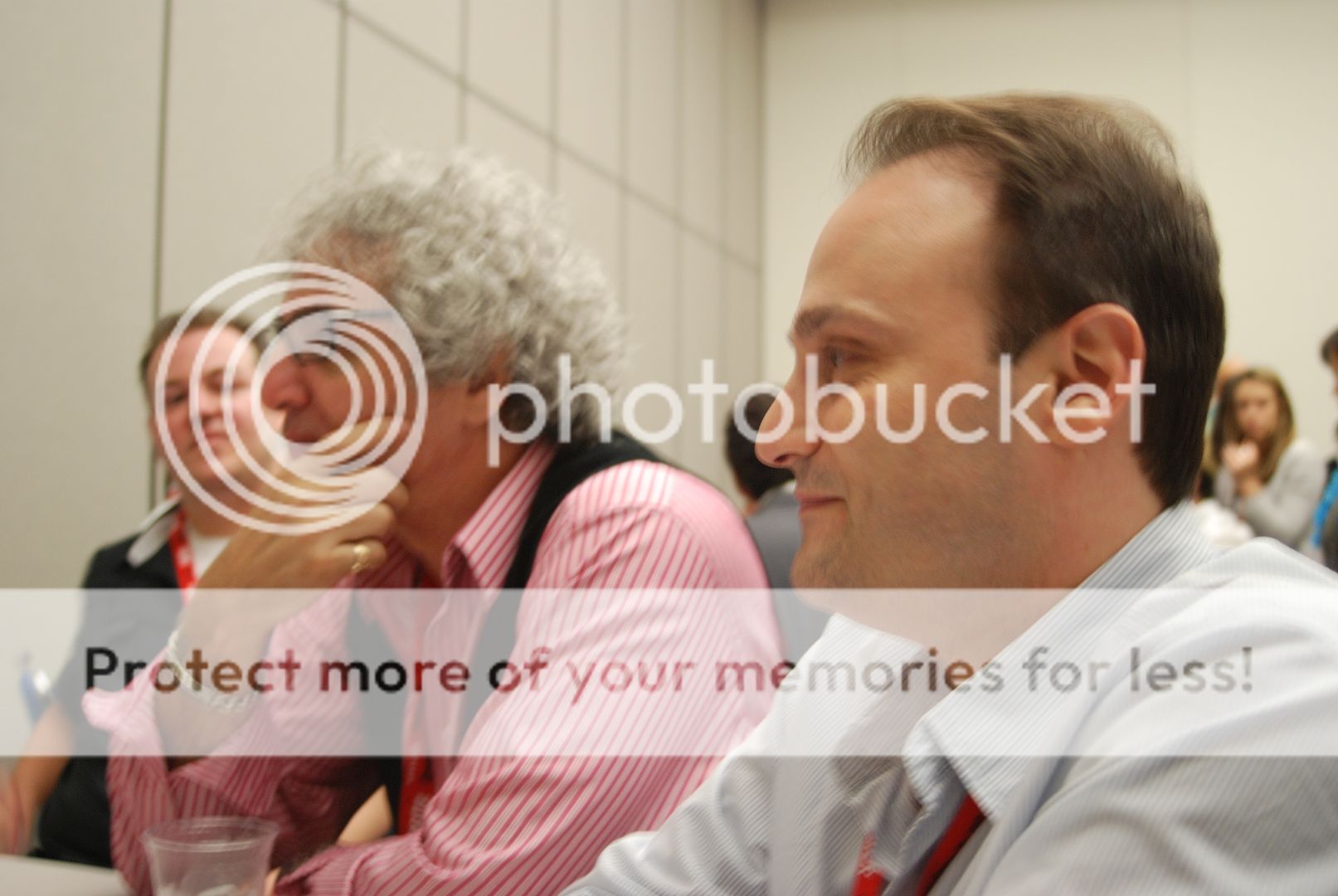

One thing fans would be surprised to learn, and the first question we asked right off the bat, is just how geeky the team behind Big Bang Theory is. Producer/writer Lee Aaronson, a self-certified comics and graphic novel geek, used to own his own comic book store. This is where a lot of the inspiration for Sheldon (and the rest of the team’s) love of geek culture comes from. They also have a close relationship to UCLA physics professor and the show’s science advisor David Salzberg. Often, they will write a line like “Hey guys, I was just working on [insert science here]” and let him fill in the blanks. We were wondering about that, too!
Geeky enough? Not even close. Showrunner and co-creator Bill Prady is a former computer programmer. He’s far more excited about Apple founder Steve Wozniak guest starring on the show than any fame or fortune that has incurred because of it. He and
co-creator Chuck Lorre maintained that the geek culture was their most important singular focus in writing the show. As one might glean from walking the halls of Comic-Con, they maintained that all geeks/nerds/scientists are not the same. There is a lot of heterogeneity amongst them, and differing, personal passions—be they Star Trek or the mathematical concepts behind string theory. And where do they get all their geeky throwaway lines? “Oh, those are all available on the internet!” And THAT is why we love Big Bang Theory.
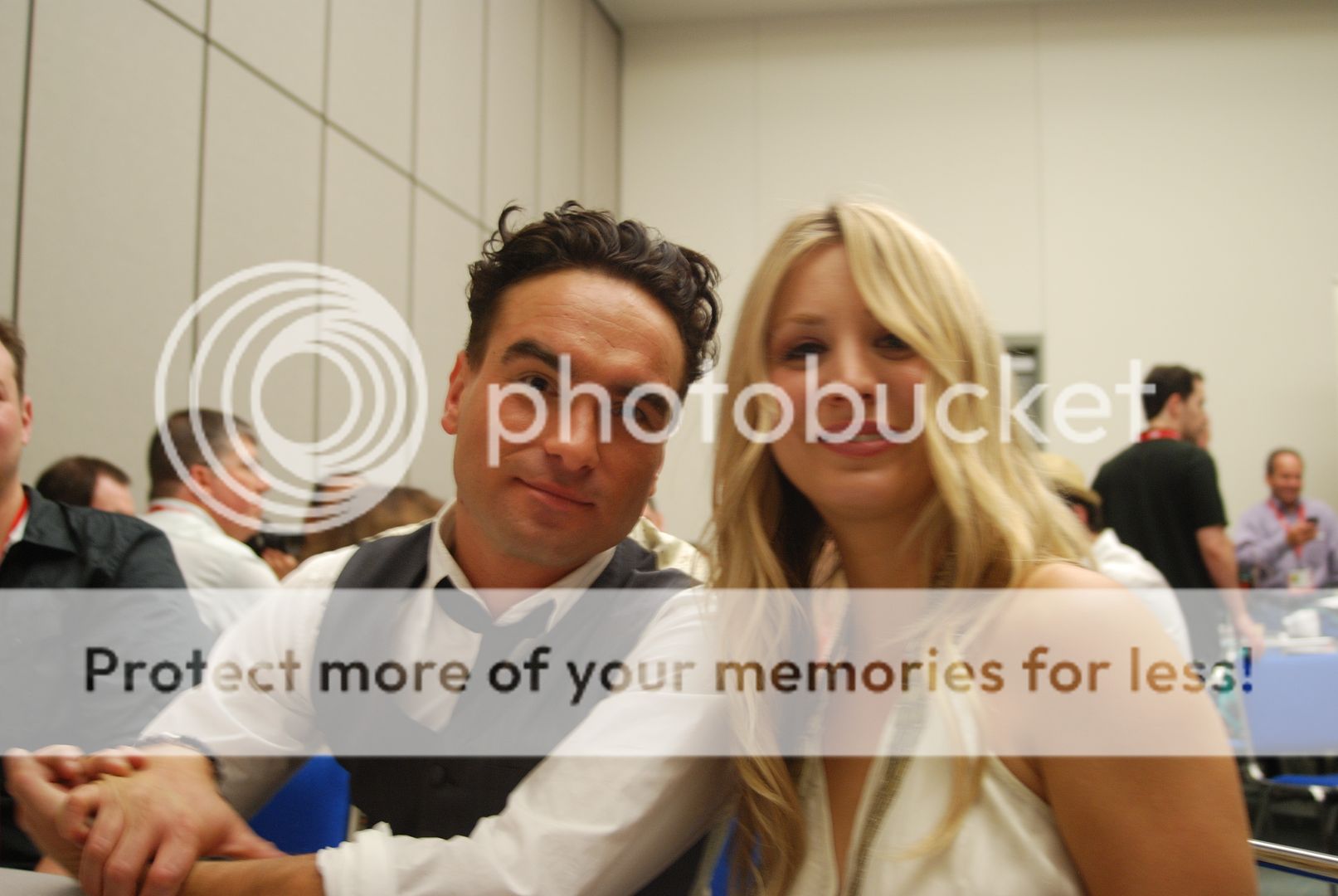
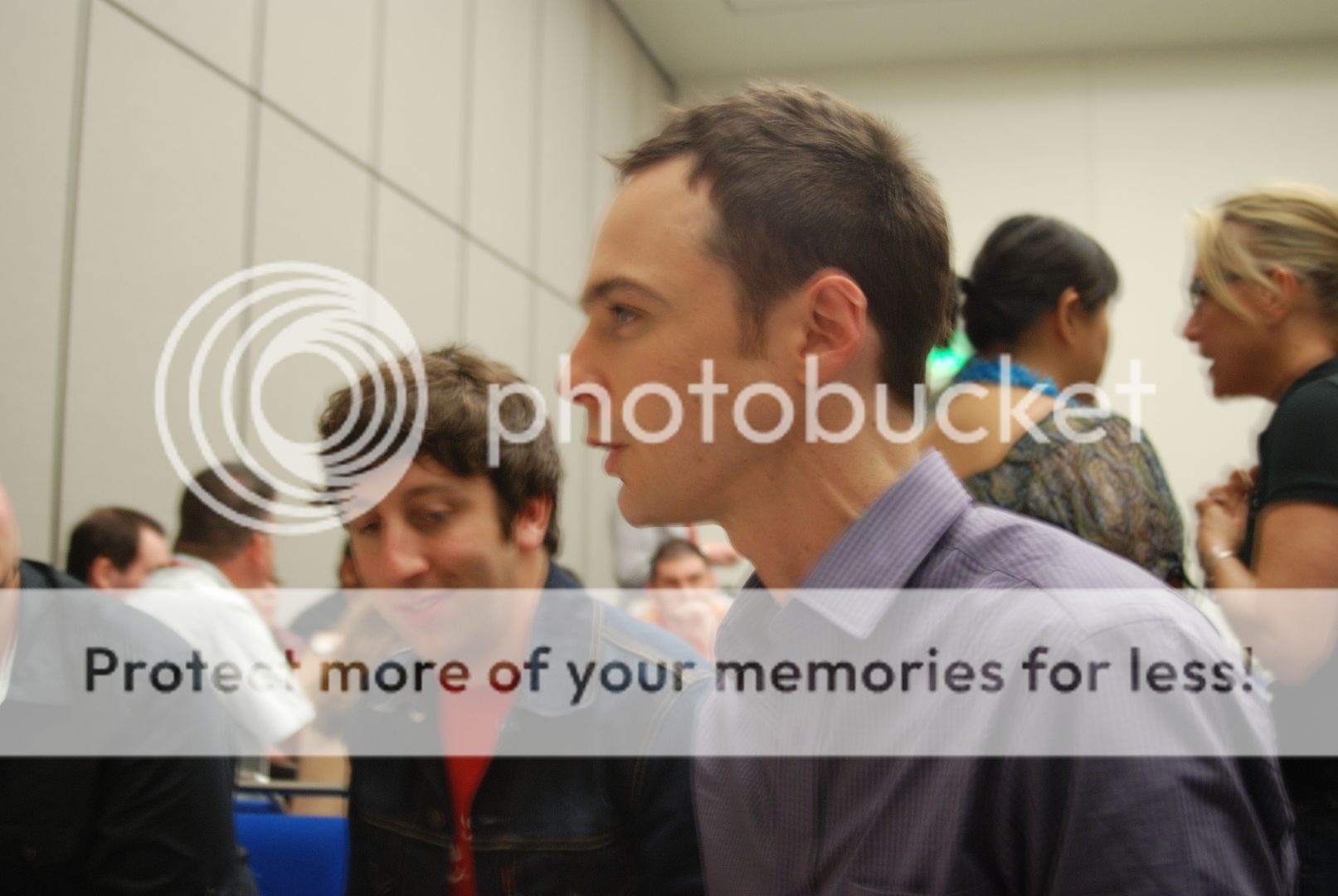
The actors themselves get right in the thick of the fun. Kaley Cuoco, playing perhaps the non-geekiest of the bunch in Penny, has nevertheless embraced geekdom. Her latest love? Her iPad! She and Johnny Galecki would both like to see a romance blossom between Penny and Sheldon (“Peldon,” joked Cuoco), but acknowledge that the road from platonic friendship to romantic involvement is filled with bumps and individual growth. Jim Parsons, who I shamelessly adore, started his time with us by telling me to shove it. He was, of course, talking about my tape recorder, but when I joked that I couldn’t believe Sheldon told me to shove it, his reply was: “And he’d tell you to shove it again and again!” Before telling Simon Helberg to bite him. Nice to know he stays in character so well!
We couldn’t leave a Big Bang Theory press room without getting our favorite superior elitist nerd to do something only for ScriptPhD.com fans. So here you have it, kids. From Jim Parsons, to you… a personal “Bazinga!”
Comics Design

One of THE most fascinating panels that we attended at Comic-Con so far was on the design secrets behind some of your favorite comics and book covers. A panel of some of the world’s leading designers revealed their methodologies (and sometimes failures) in the design process behind their hit pieces. An unparalleled purview into the mind of the designer, and the visual appeal that so often subliminally contributes to the success of a graphic novel, comic, or even regular book. We do, as it turns out, judge books by their covers.
We will be revealing each designer’s comments on their thought and art process, but are waiting for images from the panel to be emailed to us. So consider this a placeholder until we can finish this writeup and include it in Saturday or Sunday’s coverage. Stay tuned . . .
Graphic Novels: The Personal Touch
(From our correspondent Bryy Miller)

Some panels have mysterious names, some not so much. This one belongs in the latter category. There was no hidden meaning behind the phrase “personal touch.” This was all about the writers (Gabrielle Bell of Cecil & Jordan in New York, Howard Cruse of Stuck Rubber Baby, Vanessa Davis of Make Me A Woman, Larry Marder of Beanworld, Jilliam Tamaki of Skim, C. Tyler of You’ll Never Know, and moderator Shaenon Garrity of Skin Horse). More importantly and interestingly, it was about who they were. Some didn’t know who they were, others did, but they all knew one thing: that something inside of them needed to write.
Tamaki started off the discussion by stating perhaps the simplest answer of why she writes what she does, “I think that’s the only kind of book I wanna make.” Davis continued by adding that “anytime… it’s going to have a personal touch. Comics can soak up the people’s idiosyncrasies and sensibilities.” Marder, perhaps the odd man in the group, stated that even though his autobiography is a FANTASY, it still is an autobiography in the sense that it tells stories about his own feelings. Before anyone else could chime in, C. Tyler (arguably the oldest member of the panel) shot to life with an amazing amount of energy and playfulness. “I’ve taken autobiographies for granted.” she started “I know we’re at Comic-Con, but I hate superhero comics. When I read the first autobiographical comic, I was floored… it was disturbing and in a comic.” She went on to describe how she is fascinated with the idea of putting yourself out there, grabbing pieces of scraps from the table and showing us as if they were her life story – or even her creative process – in visual form. She would get extremely animated, and it really helped to humanize the element of the mysterious writer’s block and constant internal struggle to find how to portray your story. She ended her opening remarks with this, “the personal touch for me is I do it all by hand.”
Bell was the most reluctant to speak, but also, besides Tyler, the most visual. Not in the sense that she was very gesticulative or alive, but that she obviously was thinking very hard but having trouble in how to phrase her thoughts. “I try to cut my personal touch out,” she started, displaying the classic writer’s twitch of not looking directly at her audience “[I try to] make it universal. Professional.”
This instigated a very visceral response from Tyler, who on the spot tried to get into an earnest conversation with her fellow comic artist about what it means to be professional. Sadly, it didn’t last that long as Bell migrated back into thought. Cruse then brought up the point that, if your content is good, then mistakes in your craft are easily overlooked by a reader. The discussion (because calling it a panel at the end would just feel weird) had reached its time limit. Cruse gave some parting advice to young writers, “It will literally paralyze you to think of how many people have an idea similar to yours.” Marder stated that you have to fail in public. Garrity reminded everyone to heed that advice, as “Carol, Larry, and Howard have been in the comics since the seventies.”
Tyler let out a self-taunting gag.
Reign of the Dinosaurs

the Dinosaurs creative team (from left to right): Pete Von Sholly, Mishi McCaig,Tom DeRosier, David Krentz, Ricardo Delgado and Iain McCaig. (Executive producer Erik Nelson speaks on the jumbotron.)
In November of 2008, the hoi polloi at Discovery Channel approached producer Erik Nelson (Grizzly Man) with a simple request: “the ultimate kick-ass dinosaur show.” They poured enormous resources, creative and fiduciary, to create a television series that will truly break ground, both for Discovery Channel and its own medium. Scripted, yet unnarrated, scientifically stunning, yet bereft of the omniscient “talking head” paleontologist, Reign of the Dinosaurs is the ultimate exercise in “show don’t tell.” Premiering in the Spring of 2011, Reign will consist of 36 self-contained episodes erected from the art up. The stories will be chronological, detailing the rise, reign, and ultimate extinction (with a twist!) of the dinosaur species. But unlike the plethora of educational shows that cover the same topic, these will be rooted in storytelling, in treating the dinosaurs not as dinosaurs, but characters with whom we share an emotional connection. Trust me, having seen the first few world-premiere clips, you will care for these creatures, and the show will both exhilarate you and break your heart.
The true key to the success of Reign of the Dinosaurs was a dedication to amassing cream of the crop talent, formerly of Disney and Pixar, which allowed them to channel superlative animation and design talents towards an ambitious format. Along with Nelson, the team (and Comic-Con panel) consisted of renowned artists Ricardo Delgado (Dark Horse’s Age of Reptiles), Tom DeRosier (Lilo and Stitch, Mulan), self-proclaimed dinosaur nerd David Krentz (Disney’s Dinosaur, John Carter of Mars), Iain McCaig (Star Wars 1, 2, and 3), Mishi McCaig (Iron Man), Pete Von Sholly (The Mask, Darkman). Along with showing the audience their two (so-far) completed “cold open” teasers that will open episodes of the show, several of the animators simulated storyboard pitches (see picture below), just like the ones they would exchange in a writers’ room for several forthcoming episodes.
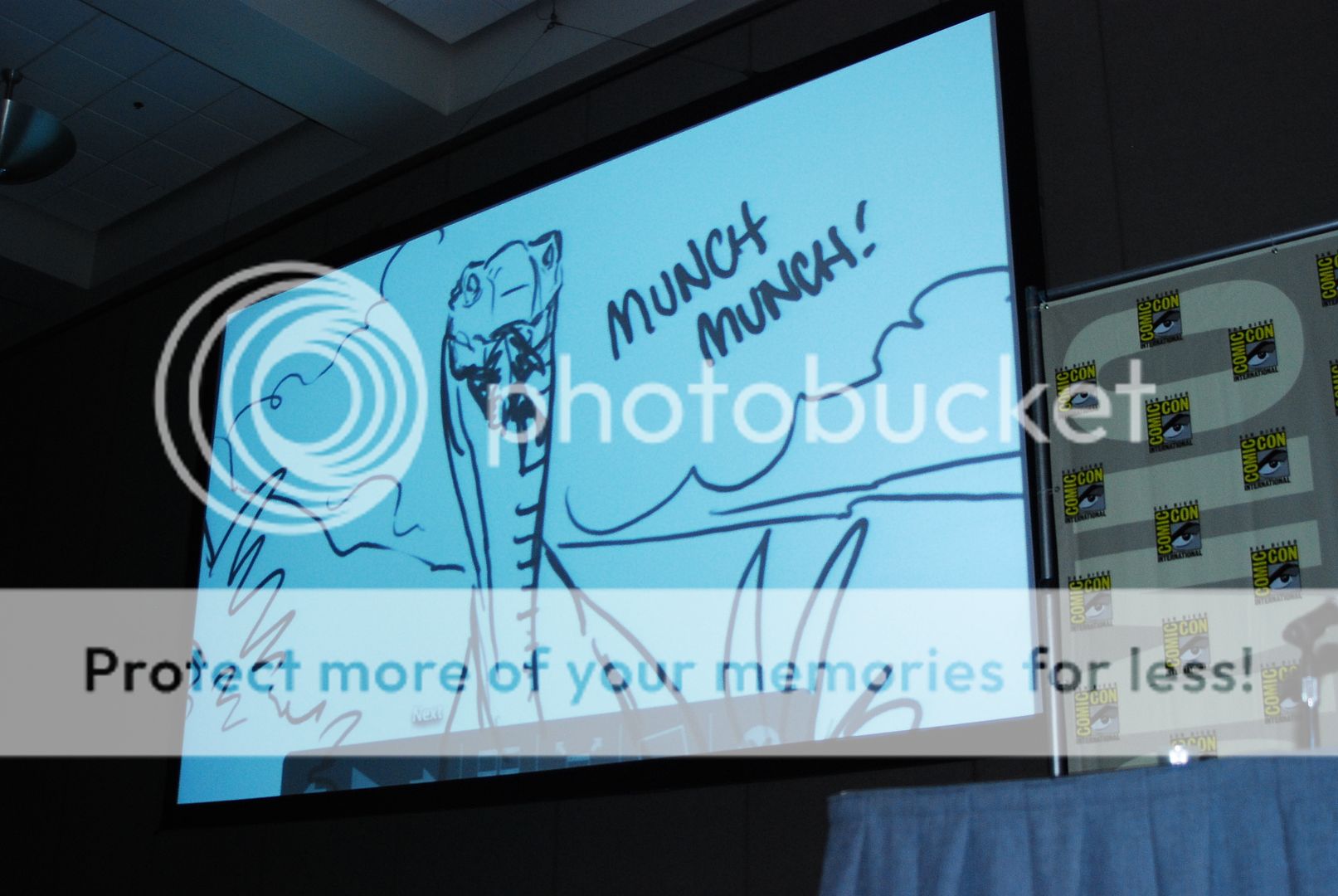
Several things impressed me upon the early viewing of Reign of the Dinosaurs, aside from the stunning art direction and well thought-out design. First of all, this show is really cheeky and funny. When the writers say that they’ll give the creatures personalities, they mean it, and it’s all done through expository action rather than showy narration. An early cold open has a dinosaur, trying to soothe her babies to sleep in the wee hours of the dawn, annoyed at the incessant chirping of a smaller dinosaur deep in the forest. Finally, she marches over and does what a dinosaur would do: bites the head off of her more annoying, diminutive co-habiting pest. Literally. Secondly, the stories pack an emotional wallop. A cinema-quality sequence shown at the end, taking place post-impact of the asteroid that ultimately killed off the dinosaurs, has the post-apocalyptic feel of Cormack McCarthy’s The Road (which the illustrator said influenced him) and visual appeal of Blade Runner. The ending, a hopeful coda on the extinction of the dinosaurs as an evolutionary stepping stone for our modern birds, had me sobbing. And then giving the panel a standing ovation.
Spring of 2011 is far away in television terms, but close enough for me to say this. Be excited, folks. Be very, very excited.
From the Press Room: Reign of the Dinosaurs

Not only did we get treated to a front-row preview of Reign of the Dinosaurs, ScriptPhD.com was extraordinarily fortunate to join the Discovery creative team for an intimate roundtable discussion panel after their panel. We were able to get enormous insight into the team’s collaborative process, storytelling aims, and dedication to balancing scientific accuracy with emotional connection, all while reinventing an entire medium. Ambitious? Just slightly.
One of the first things that impressed me upon talking to the Reign of the Dinosaurs team after their panel was their sheer dedication to, almost obsession with, “getting the science right.” Mishi McCaig and Iain McCaig spoke at length about the team’s dedication to nearing the line between science and entertainment. Hugely important to the project was the involvement of renowned University of Maryland paleontologist Thomas Holz, Jr., who cross-checks and gets pitched all the storyboard ideas. The behavior depicted in the show is speculative, but based on facts. This includes the animal’s muscle movements, how they would hunt prey, how they would interact—all aided by the paleontology knowledge of illustrator Dave Krentz. Ultimately, the team wants interest in the show to launch a more widespread educational initiative, which will include a Discovery multi-media website, and other supplementary materials to the show itself. Even when stories delve into the outrageous or fun, they’re rooted in research. A clip depicting high dinosaurs hallucinating was rooted in the marula tree, whose hallucinogenic fruit animals will eat and get high off of.
Producer Erik Nelson and illustrators Tom DeRosier and Ricardo Delgado spoke at length about the collaborative process of making the show, which they described like a TV writing room, only with animators. “Everyone’s sensibilities came together in a ‘hive mind’,” said Nelson. This visionary approach was important to the team, which is essentially trying to reinvent a TV genre. The last non-narrated, no-dialogue animated show was Walt Disney’s “Silly Symphonies” back in 1938. Needless to say, we’ve come a long way since then. The team was amazed at how constructing the dinosaurs’ stories moved them, comparing their effort to “March of the Penguins,” another simple vehicle showcasing animals that was rooted in an emotional audience response. This empathy for the dinosaurs peaks with the show’s conclusion, in which the dinosaurs die out (spoiler alert!), but which is still painted in an upbeat, survivalist way, as most geologists and paleontologists agree that modern birds are the direct evolutionary ancestors of dinosaurs.
“We’re not trying to hook you as a dinosaur person,” concluded Delgado. “We’re trying to hook you as a human being.”
Two last fun tidbits from today. Last year, on Day 3 of Comic-Con, we got geeky in the press room with our friend Barry of The Ugly Couch Show. When we saw each other again this year, we thought we’d start an annual tradition. So here it is, ladies and gentlemen. Two very tired, cranky, overworked press corps members getting silly in the press room:

And last, but definitely not least, is a very worthy Day 2 Costume of the Day. These ladies hit it out of the park. Bonus points if you can tell us which comics they’re representing:
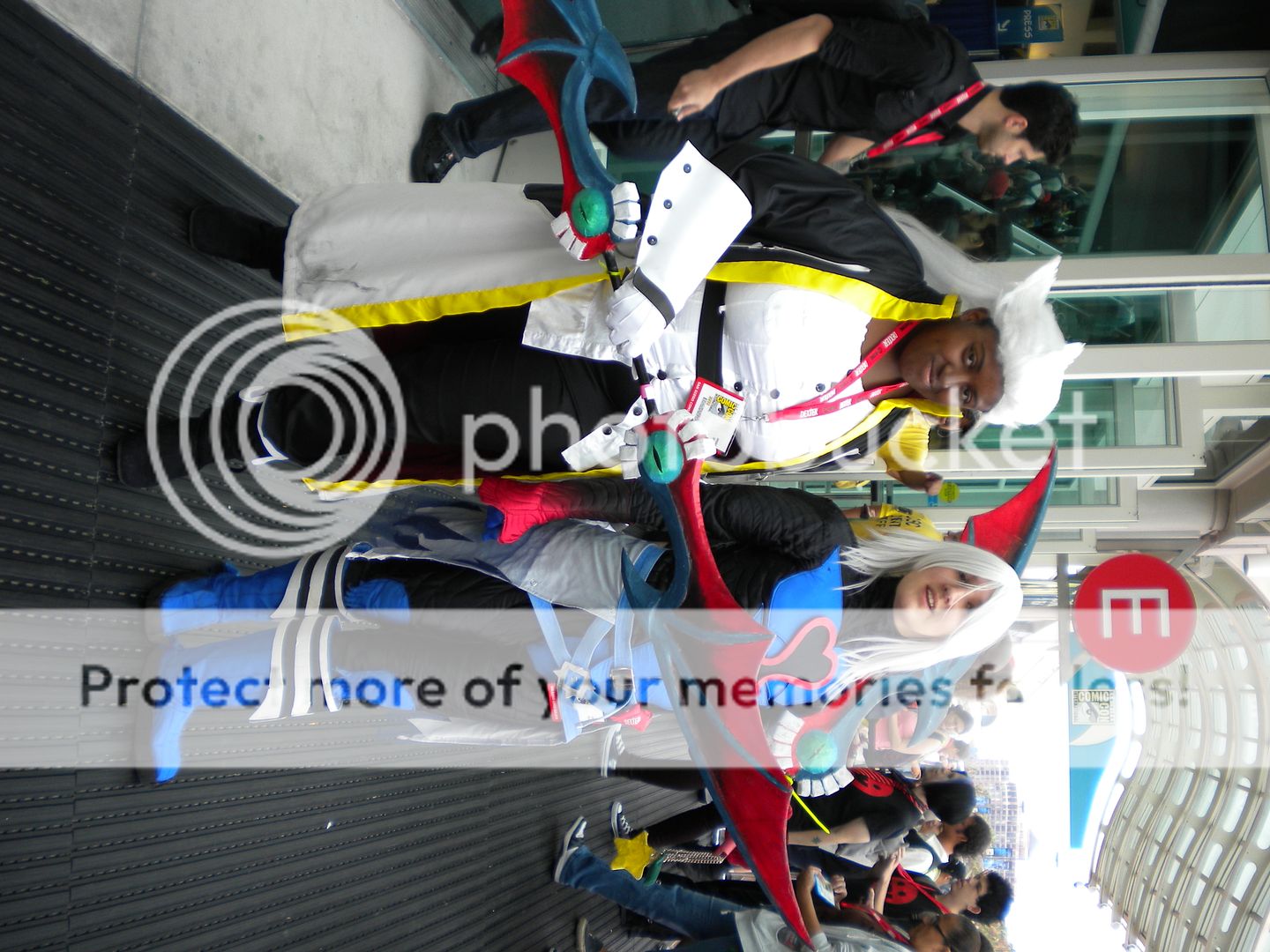
Come back tomorrow for more geeky sci-fi fun! And don’t forget to become a fan of our Facebook fan page for extra Comic-Con photos and a chance to win amazing surprise swag when we get back from San Diego.
~*ScriptPhD*~
*****************
ScriptPhD.com covers science and technology in entertainment, media and advertising. Hire our consulting company for creative content development.
Subscribe to free email notifications of new posts on our home page.
]]>Part of every great Hallow’s Eve, in addition to carving Jack ‘O Lanterns, fake blood and candy, involves a good old-fashioned horror film. To help our loyal fans prepare in advance, ScriptPhD.com enlisted the help of our good friend Bryy Miller, screenwriter and president of Lefty Films, to grab sneak peek screenings of two Halloween-themed releases, Dark Country and Trick ‘r Treat, at the inaugural Long Beach Comic Con, as well as two very rare, special comics panels. His reviews and coverage, below the cut.

Review: Dark Country
It seems like there’s a secret race going on in Hollywood right now–the race to get the first good 3D horror film into society’s hands. Next year, we will be witness to Halloween in 3D, just like My Bloody Valentine before it. But Hollywood is forever searching for a film with that magical blend of scares, good story, and unobtrusive effects.
Dark Country is not that film. Described as “heavy noir” and Twilight Zone by the director/star, Thomas Jane, Dark Country seems to have a very odd definition of both of those things. If by “heavy noir”, you mean one or two ludicrously written monologues at the very beginning of the film (which foreshadow the ending but make absolutely no sense when everything is supposed to “tie together”), then yes, it is heavy noir. If by Twilight Zone, you mean completely random, then yes, it is the Twilight Zone. The film simply did not know what it wanted to be: noir, horror, sci-fi… no idea. It kept jumping from one idea to the next whenever it felt like it. With this style of leapfrog, you can forget about any sort of a coherent plot. I felt like it was making it all up as it went along.
As for the threadbare plot, it revolves around newlyweds Dick (Thomas Jane) and Gina (Laura German), two strangers that take a trip through the midnight Las Vegas desert, hoping to get back to civilization before the heat of the morning. Before they go, though, Dick has a run-in with a man in black, who warns him to stay on highway 95. Soon enough, the two get lost and are subject to a plethora of thinly connected and fully undeveloped anomalies. What’s worse is you can figure out both the ending and the twist – at least the coherent parts – when the first signs of supernatural spookiness begin. This is a very dumb movie trying to be a very smart one. I had absolutely no investment in Dick or Gina’s lives or their plight. Thomas Jane stumbles through the movie doing his best impression of a nerdy Marv from Sin City. In a piece involving two characters for the entire film (minus a few parts with a corpse and Ron Pearlman, who is by far excellent in his small role), we find out very little about either of them and get even less dialogue. Gina’s plot is left murky and vague, and the movie keeps shifting gears with her. Is she “in on it”? Is she a helpless bystander? Her plot hinges entirely on the climactic reveal, and when it happens, we are left with an even further confusion as to who exactly the character is in relation to everything. Because, let me tell you, it just does not work. The ending has no relationship to the beginning. None at all. Even the “heavy noir” monologues that act as portents do not add up.
It’s going straight to DVD. Good for it. I guess. I mean, there are going to be people out there that will gobble this up, and that scares me. In five years, the studio executives that think blood and gore sell will be right. We need better horror films, and we need better 3D horror films.
Dark County went on DVD October 6th, 2009.
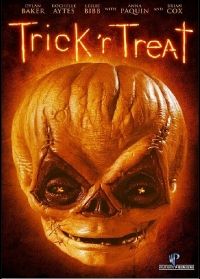
Review: Trick ‘r Treat
Halloween films are either all about slashers or Christmas nowadays, very rarely celebrating the holiday itself. In recent years, it’s even become “hip” to move away from the supernatural as your death-dealer. Rob Zombie even had the bright idea to put out BOTH of the Halloween remakes in August. They have Halloween in their titles, for Pete’s sake!
I am happy to report that Trick ‘r Treat, a movie that has been shelved for two years but has been getting critical reviews from screenings all over the country, is chock full of everything that we love about the holiday. It is filled to the brim with costumes, falling leaves, black, orange, and a boat-load of intricately-made Jack O’ Lanterns. Four stories make up this anthology film, all taking place and sometimes crossing over each other in a small Ohio town. It actually could be considered five stories, as the first story takes place even before the opening credits. The stories are thus: a high school principal who has a very odd way of connecting with his son, a crew of young women trying to find the perfect date for the ugly duckling of the group (who is complete with Little Red Riding Hood costume, as well as being Anna Paquin), an urban legend that proves a little too real for some very nasty children, and a cranky old man (Brian Cox) who gets a visit from what could be called the Ghost of Halloween Present. Besides the occasional crossover, the stories are connected by the themes of the holiday: always check your candy, never go out alone, don’t blow out a Jack O’ Lantern before the night is through, and give out candy to any and all young trick-or-treaters. Not following any of these rules is the equivalent of taking a knife to a gun fight in this film. Once you begin to think about the events taking place, you realize that this film is really about “them”, and less about “us”. I mean, why can’t the spooks enjoy the holiday – a holiday created for “them” – as much as we do? All they want to do is protect what is theirs.
My favorite story would have to be the urban legend vs. the unbelievably but intensely realistic trouble-making children. It was scary and edgy. Things happened in it that not only set up the end of the film, but revealed a whole lot about what was actually going on without saying anything. My least favorite is Anna Paquin’s Red Riding Hood tale, which saddened me, as it had my favorite scare as well as my favorite supernatural creature. I did enjoy how it used the now ordinary idea of twists and turns in a movie to scare you, it always keeps you guessing as to what is really going on. Then, when you think you know what the deal is, the rug is pulled out from under you. It scared you by pitting your preconceived notions against you. That was fun. It was interesting and smart. But the ending of the Red Riding Hood tale is rife with a clichéd song and an ending sequence that goes on way too long.
I highly recommend at least renting this film to see if it is for you. It’s a thrill ride with enough humor and scares to last you through this Samhain season. All Hallow’s Eve. Whatever you want to call it.
Trick ‘r Treat went on DVD October 6th, 2009.
COMICS TO SCREEN PANEL
ScriptPhD.com has covered (and will continue to cover) a number of films (including most recently Whiteout) that are direct adaptations from comic books or graphic novels. In fact, it seems that the near future will bring a panoply of such projects–Hollywood’s newest bandwagon. Helping to break down how comics are made into films was a fascinating panel consisting of Buddy Scalera (moderator and host of Long Beach Comic Con), Chris Leone and Laura Harkom (SyFy’s The Lost Room, Red 5’s We Kill Monsters), Jeph Loeb (Heroes, Lost, too many comics to count), and Mike Fasolo (Robot Chicken).
The first round of questions went to Laura Harkom and Chris Leone, a writing team currently working on a miniseries for Red 5 Comics called We Kill Monsters. They gained fame, however, with a ridiculously well-written miniseries for the erstwhile Sci-Fi Channel called The Lost Room.
BS: First I’m going to address Chris and Laura, how you two came together as a team, produced The Lost Room, and then we’re going to get into how you got into comics.
LH: Let’s see. Well, how we came together as a team, we went to school together. We went to college together, um, we didn’t really know each other all that well in college, and then we moved to Los Angeles around the same time, and had different careers: I was a studio executive, Chris worked in Visual Effects. But, you know, we kind of knew each other from writing, the writing program, and eventually realized, well, that’s what we should be doing, so we teamed up to start writing together.
CL: So we’ve written a bunch of scripts, but the only thing that’s been done has been The Lost Room, now, so most of what we’ve written has never been done.
BS: We’re going to talk a little bit about how you guys are stepping into comics.
CL: I’m kinda obsessed with comics so its, kinda, it’s not an alien format to me. The cool thing about a comic book is I can write it, and we hire our artist, but, kinda like The Lost Room – which took twenty million dollars – basically Laura and I funded it ourselves [WKM, not TLR] and we just wrote it, and it’s a comic book. See, see, check it out. It’s called We Kill Monsters… the title is pretty self explanatory. I come out of visual effects, I understand what it takes to build a CG monster, but you can just draw it, so y’know…
LH: Yeah. I mean, we thought “should this be a TV show?”, and then we thought, the way television budgets are, we would never get to execute the monsters the way that we wanted them. But whatever you can imagine, you can have drawn, for the same price as any other page.
CL: The insane thing about Hollywood is that the odds are of making it are even better if it’s a comic book. Why can’t it just be a script… for us, it’s fun to do a comic book and it’s cool. Odds are someone will come knocking on our door and say “hey, this should be a movie” and it’s “no shit”.
BS: Is Hollywood looking at comic books as an incubator? Is that your experience?
CL: I don’t know. I don’t know how they see it. It could be “it’s got pictures, it’s like a movie”, I think it’s something that – someone published it, therefore –
LH: It’s validated.
CL: – it’s validated. Well, someone published it, must be worth something.
LH: Yeah, someone took a chance on it and thought it was a good idea. So if it bombs as a movie, the idea can always come back to “well, it was successful as a comic book…”
BS: How was it transitioning from writing to the screen to writing to the page?
CL: Well, in some ways, I’ve read ten thousand comic books, so I understood it. In some ways, there were things that I didn’t get. Right? So, looking at a panel, you have two guys driving. I have the guy on the right, the guy driving, speaking first. Well, that doesn’t seem weird. But then you look at the panel, and he’s on the right, so the word balloons will cross. So the artist was like “no, you gotta have the guy on the left talk first” and I had to rewrite the whole page. It’s a funny little rule, but it’s obvious once you realize it.
BS: We were just talking about the differences and challenges of writing from the page to the screen. I was wondering if you could weigh in here.
JL: The really big difference is money. And, uh, I don’t mean in how much you get paid. In terms of how much responsibility you do have. When you do comics, you’re only really limited to your imagination. So if you want all of Rome to burn, you can write ‘all of Rome burns’. Your artist is going to kill you, but you can do it… you have to be realistic… or you can do ‘Luke gets in an X-Wing, and then double page splash, he blows up the Death Star’. Particularly in television you have real responsibility, and the other thing that is difficult to do, and once again, the transition goes the other way, in television it is real easy to write two people talking. It is the responsibility of the director to make that interesting… in comics, it’s incredibly boring. The biggest understanding is: on a page, what you’re able to convey, uh, versus film. The trick is to make it interesting.
It is then that the entire panel gives a shout out to Final Draft, the most widely used screenwriting program in the film industry.
BS: With Robot Chicken, it’s a little different, as opposed to working with live actors, it is animated figures.
MF: We write as though they are normal people, although we can’t have someone do a backflip… we write normally, and we hope our puppet department can do what we want our puppets to do. Usually, a page is a minute of screen time. [For Robot Chicken] one page is a minute and a half… on a very good day, we can get our animators to do ten to fifteen seconds of animation in a day… we can put together an episode in a week, but we have fifteen animators working eight hours a day.
BS: Laura, could you tell us what was the mental transition for you, the screenwriter?
LH: Sure. My experience with comics was pretty limited. When I was a studio executive at Warner, I was in charge of the DC Comics projects. So, that was really – but aside from a lifelong obsession with Batman, which is another story, I didn’t have much experience with comics per se. I got a really cool crash course from some of the best people in the business. Like Paul Levitz and Jenette Kahn, who were running DC at the time. For me, it’s – I still think comics are more directing than writing. In a comic book… it’s ten times more specific. What’s in each panel? As Chris was saying, who speaks first?
JL: By the time you get to the second season [in TV], you know what the actors are capable of. And, particularly, a serialized show, you try not to do an episode where the audience goes “what show is this?”… you are really trying to work in something that looks a lot like the previous episode and the next episode. You are writing down a very thin corridor. Whereas in comics, every time you are working with a different artist or working in a different character, you can change up whatever you want.
BS: Chris, working with a blank slate, what was your biggest challenge?
CL: Well, one of – well, I mean – basically that. Is this one big splash page or is this sixty? Trying to – I know where I need to end – but how do I get there? It is still limiting, so many pages of paper. The first issue was the most questionable… on layout, once we figured that out, the train just kind of rolled.
JL: I can’t draw… one of my kids is in second grade, and I went to What’s Your Dad Do For A Living Day. I don’t know how to draw. The kids started giggling. I couldn’t figure it out, but by me drawing a stick figure on the wall, that was drawing to them. The things I see in my head, you just can’t teach that.
The floor was then opened to questions. The first question was about if it feels different to see your creative work as a comic or as a film or television show.
CL: For me, it’s about the same. It’s a little more exciting to have a TV show because it’s more expensive – still, at the end of it, it’s “tee hee hee, I made this”.
LH: It depends. There’s differing levels of involvement. In television, writers are much, much, much more in charge of the whole production because they’re also producers. In feature films, writers are much more disposable and replaced… even if they’ve created the project. With comics, that process is pretty rare, it’s more like television.
The next question, taken with grace and respect by Jeph Loeb, was from an enthusiastic albeit confused young writer who was in search of a “game plan” as to how to get started in the field.
JL: The best thing you can do, and this is going to sound ridiculous, is write. My screenwriting teacher, back in the day when we were writing on cave walls, used to say “get a book, and every day, write a scene”. Write something every day. You can’t cheat. You have to write every day, and you can’t say “well, yesterday I wrote five pages, so today…” – it’s a little bit like exercise. You will be a better writer than when you began. If three people have a problem with what you’re doing, you have a problem, and you need to address that problem. What you write, those are not your children, and when you have children, you will know the difference. You can’t get rid of them.
Absolutely terrific advice, for those of you reading this and hoping to break into the field.
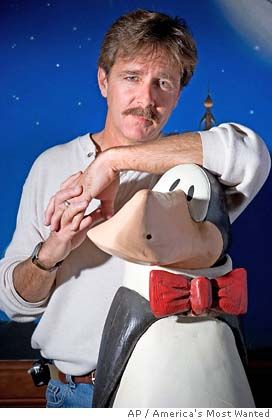
Berkeley Breathed is one of the last veritable newspaper comic legends. He made the comics section something magical alongside the likes of Bill Waterson, Jim Davis, and Lynn Johnston. His two comics, Bloom County and its spin-off, Outland, ran from 1980 to 1995. He never did conventions, until now. So it was a rare treat when Mr. Breathed finally came to Long Beach, partially to unveil The Bloom County Library, the first volume in a series of mega-sized books collecting his first strip in its entirety.
This is what he had to say about his work, his process, and his life:
Berkeley Breathed: Um, so this is a comic con? Cool. The kids love it. You know, I haven’t been to one before. I didn’t know what they were, I didn’t know what people showed, I didn’t know what people talked about. So I asked Scott, my editor, “what do you think I should do?” “Show some slides” “Slides?” “Show your old favorite slides to them”. So I thought about that. It didn’t make much sense, but I do what my editor says, so here are some of my old favorite slides.
Breathed then clicks a button controlling the projector that has lowered. A montage of playground slides, de-evolving in quality and safety as the thing goes on, plays to the amusement of the crowd.
BB: … it made me think of were sources of ideas come from. Um. I love NOW, looking back on my career, as to figure out where ideas came from, both my ideas and what I most admire in others. If I came to hear someone speak… I would like to hear the process. I would like to hear where they thought of that idea for that movie, for that – Sophie’s Choice. Did they start it at the choice, did they write it backwards… that’s what this place is really all about. Even more so than comics.
Breathed then shows us a slide of one of his very first drawings, done up in his junior year of high school. It is a graphic but comical image (a staple of Breathed’s work) of a man in a spread pose… with his head blown off. He received an F. Later that night, after some advice from his father, he wrote one simple word as a caption: Gesundheit.
BB: I still got an F. But she added “you get an F, but you are going to be very wealthy someday”. It was the first clue that I had that drawing a picture and writing … and put them together, and the whole is larger than the sum of the parts. That was really the first clue I had of probably where my career was going to go. I had no history in comic books. I had not read them as a child. Cartoons did not come natural to me. It was a side effect that I was fired from every other department in the University of Texas for making stuff up. I was fired on the news side for wholesale manufacture of stories. It didn’t go well. But I didn’t think of the comic strip first, I thought of an editorial cartoon. This is my first and only editorial cartoon:
He then brings up a slide which parodies the ‘Star Trek’ poster, but replaces ‘Star’ with ‘Far’. It was a commentary on Austin, Texas’s new busing system. It did not go very well, either, and he was fired once again.
BB: I was making the mistake of arguing that it was a perfectly funny cartoon. So. Bloom County. [I] Came up with a penguin one day. The strip needed an animal, I was desperate for an animal in the strip, I was desperate for a focus in the strip, and was without a clue as to how you do a comic strip, but specifically, one without a college readership which had themes of sex, drugs, and rock and roll, which was easy. It needed a focus, Opus came along at just the right time.
He then shows a slide of Opus, Bloom County’s central character. A shy, lovesick, sometimes outrageous, and often social commentarily depressed penguin. Breathed then puts on a slide of Dick Van Dyke dancing with penguins during the famous painting scene in Disney’s Mary Poppins. He explains that this is the image that Opus was born from.
BB: I named it Bloom County, by the way, because most strips are named after their main character. I had no idea who was going to be in my strip. I actually hated the name of the strip for the rest of my career, mainly because Charles Schultz hated Peanuts, as he told me one time. He wanted to call it Wee Folks, which was actually a worse name. He was actually told by a syndicate – he was told to name his strip that [Peanuts]. Garfield was an odd source – it was a good source for one of my odder ideas:
Breathed puts on a slide of Bloom’s secondary character, a speechless and often drooling mad-eyed cat named Bill. Tall, lanky, and in one slide, eating Snoopy alive while a horrified Charlie Brown peeked around the edge of the panel. There was an open briefcase at Bill’s feet, proclaiming the words ‘Get MET, it pays’. He then explains that his editors forbid the mockery of other strips, let alone the mockery of companies like MET. Doonesbury, which Breathed openly admits about being way too close in art and writing style, was put on the editorial page. Breathed then tells the story of how he was invited to the Reagan White House. He shows an image of a random panel that just so happens to have a portrait of Nancy Reagan in it.
BB: So the next morning, I get a call at 7:30 … I need to hold on because the President of the United States needs to talk to me. It’s 1982. I was new to the game, I thought maybe everyone gets a call from the President of the United States. (Laughs). I thought it was fake … I get a call from the local newspaper, I knew it was legit. So he calls me, and it’s President Ronald Reagan. “I just wanted to call up, I was reading the paper yesterday, and I came across Nancy, and I just wanted to tell you, I loved it”. And I said, “Mr. President, you don’t want anything?” and he said “No I don’t want anything, I just got a kick out of it”. And I said “Well, would you like the original?” “Oh, well, I didn’t think you fellas gave those up”. And I said “You know, there is a short list of people that we give them to, Mr. President, and guess who’s on it?” – and he was so endearingly charmed that he was on that list. So, in those days, back in the days when they had big state dinners, they paid you back with a big state dinner. (Pause) There have been strips and themes that always don’t work. One was overweight. Classic, but, uh – thundering, deafening silence after each of these strips that I did. Another thing – Cosmetic Surgery. Cosmetic Surgery was never funny to people. The notion of stuffing your body full of artificial materials to do whatever we do is, in the abstract, very funny. The last topic is big medicine. I thought there must be a way to bring in big medicine – the medical industrial complex – which is just now being talked about – into the strip. If we get scared enough, we go running to them. This is the last one, and it is what got me out of the cartooning business entirely:
Breathed clicks, and a comic involving Opus and a woman in a Burquini (a body burqa) appears.
BB: This is pretty much the last of the Opus strips. I had a character that became Muslim. I had her in Muslim garb. That sent the Washington Post, and its writer’s room, and its lawyers, into a tizzy that I had not seen in 25 years. I thought I saw it coming. I approached it with more sensitivity than I cared for. She comes out in a Burquini. What they [the Washington Post] didn’t know is that a Burquini is absolutely real. It’s sold actually out of Southern California by a Muslim corporation, it’s sold to women around the world to wear on the beach. It didn’t matter, I could not put it in the strip, they did not want me to. I was on the phone at six o’clock at night before the deadline with the publisher of the Washington Post – who I had not heard from in ten years, and he was on the phone telling me “Fix her hair so it doesn’t look too askew” because that would reflect badly on the Muslim community, and I could see things had gone so over the top… I couldn’t even mention Ron L. Hubbard’s name… it was getting weirdly more conservative. It was getting more political. As far as cultural commentary, it was shrinking. And I’m on the phone with the Washington Post publisher about how to fix her hair.
Breathed then goes on to talk about his past and future children’s picture books. He talks about Red Rider Came Calling, which was a story based on a real bicycle stuck in a real tree. His next, Mars Needs Moms (currently being made into a feature film by Disney), is based on his own son, Milo, having a temper tantrum directed towards his mother. But the most compelling tale came from one of his future books, Flawed Dogs. It is the tale of a Dachshund who, through a series of jealousy and betrayal, lands in a prison-type environment for… you guessed it… flawed dogs. They eventually break out and go on a mission of revenge against the Westminster Dog Show. One of the images of revenge is a dog, having shaved a poodle, draws Calvin from Calvin and Hobbes going to the bathroom.
BB: I haven’t heard from Bill for fifteen years, and I’m going to hear from him now. I have the greatest collection of letters in my file – we’re both fighting the syndicates, early 90s. He’s in the middle of a horrible fight that I never had, because of licensing. As you know, Bill Waterson would have nothing to do with licensing. He was probably losing two to two hundred and fifty million dollars a year in the balance of that decision not to do it. In those days, you didn’t own your comic strips, so here was a guy – he was hired labor, as far as they were concerned. We all were. So he’s having terrible fights, scared terribly that they’ll start making the stuff that, for whatever reason, he feared terribly. We wrote letters back and forth, and sweet Bill Waterson has a deadly sense of humor, so he draws these great drawings – always at my expense – of a power boat, me one foot on the dock, pouring dollar bills into the gas tank, while the syndicate head is selling merchandise to pay for the power boat. I’ve got a whole file of these things that I can’t show you – maybe I should, that would get him out of the hole.
Click! A new slide shows up of a woman comforting a helpless dog in the snow. They hug each other. He is looking up at her with such… pain… as well as love. Breathed then tells us that this was his inspiration. He tells us what it is:
BB: This is – this is a picture of one of Michael Vick’s fighting dogs. That was removed and was going to be destroyed until a shelter came for him. This is the moment when he – for the very first time in this dog’s life – years in brutality, taught only to hated, faced only with hate, faced only with hate and cruelty that you and I can’t imagine, never having felt any kind of kindness from a human being in his life, this is where he is receiving it for the first time, and you can see that everything that makes a dog tick is still there, and he’s becoming a dog again. And for a storyteller, this is like the bicycle in the tree. This is what we live for, this is what I live for.
A broader silence fell over the room, as I think I realized for the first time just how amazing this guy actually is. He knows exactly why people write. It was really cool.
“Bloom County Library: Vol. 1” went on sale October 6th.
~*YorickArcher*~
******************
Follow ScriptPhD.com on Twitter and our Facebook page. Subscribe to email post updates on our home page.
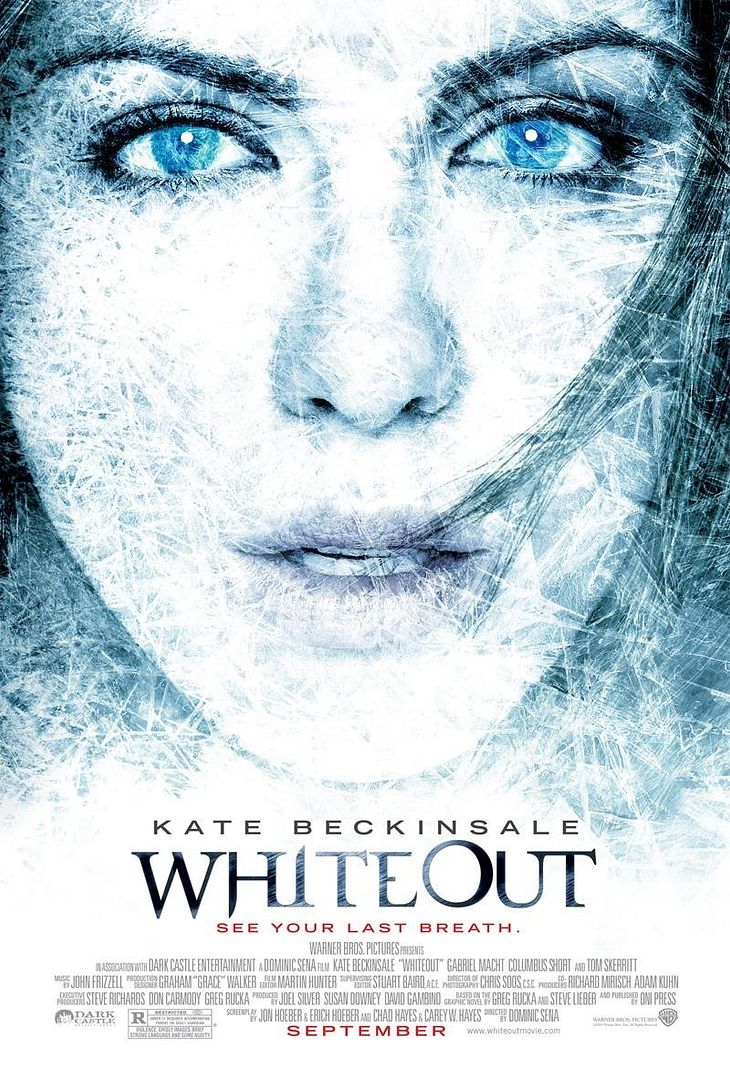
In a recent interview with ScriptPhD.com, Watchmen screenwriter Alex Tse described Hollywood’s recent spate of comic book and graphic novel adaptations as jumping on a bandwagon. So let’s continue the momentum and hop aboard the South Pole Express to Warner Brothers’ Kate Beckinsale-starring remake of the classic graphic novel Whiteout by Greg Rucka and Steve Lieber. ScriptPhD.com reviews this cool-as-ice thriller and provides some real-world gripping tales of scientific heroism in Antarctica under the jump.
Review: Whiteout
ScriptPhD Grade: B
Deep in the blinding chill of the whipping Antarctic winds and snow flurries, with temperatures at -120 degrees and winds at 100 miles per hour, a Russian cargo plane carries a crew and mysterious payload. Its flight and mission are aborted by a rampage that kills every member aboard, forever burying the plane and its secrets. That was 1957. This is now. Assigned to the South Pole’s Amundsen-Scott research station, U.S. Marshall Carrie Stetko (Kate Beckinsale) is wrapping up her Department of Justice duties and getting ready to hand in her badge before the oncoming “whiteout”, an unholy convergence of weather events that results in a six-month winter of darkness. Inconveniently for Stetko, days before the last of the planes are to leave the station, a grisly murder is discovered, Antarctica’s first. Delving deeper into the mystery, and putting her own life into danger, Stetko unravels motivations leading all the way back to the Russian cargo plane. With the help of her friend and mentor, the station’s on-board doctor (an avuncular Tom Skerrit), UN investigator Robert Pryce (Gabriel Macht), and fiery pilot Delfy (scene-stealer Columbus Short), Carrie must battle the haunting demons of her past and the harsh conditions of the present to answer the two questions that will capture the killer. What was on the cargo plane that was worth killing for? And who can she trust?
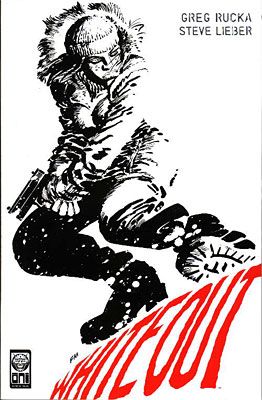
Seeking to evoke the realism of the cold, barren Antarctic, director Dominic Sena shot the film’s exteriors in subzero temperatures in Manitoba, Canada, a point reiterated vocally by the stars at the press junket. Sweeping cinematography of the stunningly beautiful landscapes is one of Whiteout‘s high points. However, Sena’s camerawork seems to serve no more than the dual purpose of pointing out that the South Pole is oh-so-very cold and that Kate Beckinsale is oh-so-very hot. (A gratuitous shower scene towards the film’s beginning evinced an audible groan of disbelief from the press corps.) That Beckinsale has a smokin’ bod is apparently essential to absorbing this labyrinthine tale. “What I found intriguing about the story and about Carrie Stetko is how human and flawed she is,” said Beckinsale. “Because you don’t know her backstory, you don’t know what she is capable of until you see events unfold. How damaged is she? Are her instincts still good and will they carry her through or will they fail her again?” Sadly, Ms. Beckinsale could not translate this wonder and intrigue into credible acting. Her staid, underwhelming performance turns a rare (for the world of graphic novels) strong leading heroine into a forgettable victim. Surrounded by a cluster of credible, if underdeveloped, side characters, the relationships and secondary plots feel like anemic distractions from an already weak premise. A tease of romance between Stetko and UN investigator Pryce is just that, because they haven’t had time to solidify a true bond. Likewise with colleagues Doc Fury and the pilot Delfy–by the time their characters figure into the unfolding of events, no one cares. Flashbacks to a previous partner’s betrayal and murder by Carrie (in a rather clever meteorological juxtaposition between scorching Miami and frosty Antarctica), significantly explored in the graphic novel, never finds satisfactory resolution in the movie. To make matters worse, many of the comic book elements that contributed to the book’s success simply don’t translate to the silver screen. A masked pick axe-wielding psychopath, for example, designed elicit page-turning fear, in the film seems anachronistic and inappropriately humorous. There is also the controversy over several elements changed from the novel, most notably the gender of Stetko’s UN agent partner, originally a female in the book, with whom Stetko had nevertheless become . . .close.

Despite its shortcomings, Whiteout still has noteworthy merits, not the least of which are subtle, appreciated nods to science organizations NOAA and the National Science Foundation. For one thing, the movie never scrimps on the action and thrills. A few of the chase scenes between Stetko and her would-be assailant, amplified by the blinding, debilitating chill, are downright gripping. With an unidentified killer afoot in a confined space, a few of Beckinsale’s solo scenes evoke the psychological suspense of classic film noir. Much of that was achieved through Sena’s commitment to shooting in authentic locales and conditions. “We wanted to lay out clearly what the temperatures are, how quickly a person can get frostbite or die from exposure. It’s all there and it’s all true,” said the filmmakers. Indeed, the unforgiving conditions are a character unto themselves, contributing both to the plot evolution and action sequences. Adds Beckinsale, “The action is based in reality and I think that will make it more intense for audiences because they might imagine what they would do in the same situation.” Finally, despite veering towards some predictable plot points along the way, Whiteout does culminate in a genuinely surprising ending that will keep you guessing. After reading the bookseeing the movie and digesting the ending, the tagline “See Your Last Breath” will make much more sense.
The bottom line is that fans of Ms. Beckinsale, the original graphic novel, or those simply looking for a mindless cinematic weekend escape will be suitably pleased with this perfectly adequate by-the-numbers thriller. However, fans wishing to experience the magic and suspense of Whiteout with all the nuance and character depth that the story necessitates are better off sticking with Rucka and Lieber’s comic masterpiece.
Whiteout opens this Friday, September 11th in theatres nationwide.
South Pole Science
The Amundsen-Scott South Pole Station is the southernmost continually inhabited place on the planet. Research, the primary purpose of the station, includes glaciology, geophysics, meteorology, upper atmosphere physics, astronomy, astrophysics, and biomedical studies. As depicted in the film, scientists (and other crew members) primarily inhabit the station from late October to mid-February, leaving a minimal crew during the “winter over” Whiteout months. For a tour of the Station by researchers working on the South Pole telescope, check out this video:
Want a real dose of Hollywood terror on the South Pole? Check out the story of heroic Doctor Jerri Nielsen FitzGerald. Answering a call to serve as the only doctor at the NSF’s Amundson-Scott research station, Dr. Nielsen, an emergency room physician, soon found herself trapped at the station because sub-100 degree temperatures turned fuel gelatinous, thus making flights in or out of the station impossible. It was right then that she discovered a lump in her breast, and had to rely on computers, satellite imaging and teleconferences with oncologists back in the United States. Terrifyingly, because she was the only trained physician at the station, Dr. Nielsen had to get help from her colleagues for every procedure–a welder first practiced on an apple before using a needle to perform her biopsy, a maintenance worker prepared laboratory slides and other samples, and computer scientists aided with transmissions of data for analysis and chemotheraphy treatment, which was airdropped to the station. Finally, as temperatures began to thaw that Spring, she was rescued by the National Guard. Dr. Nielsen documented her harrowing story in the autobiography “Ice Bound: A Doctor’s Incredible Battle for Survival at the South Pole”, as well as a CBS movie of the same title starring Susan Sarandon. Sadly, Dr. Nielsen passed away earlier this summer, but her bravery, courage, and survival are immortalized.
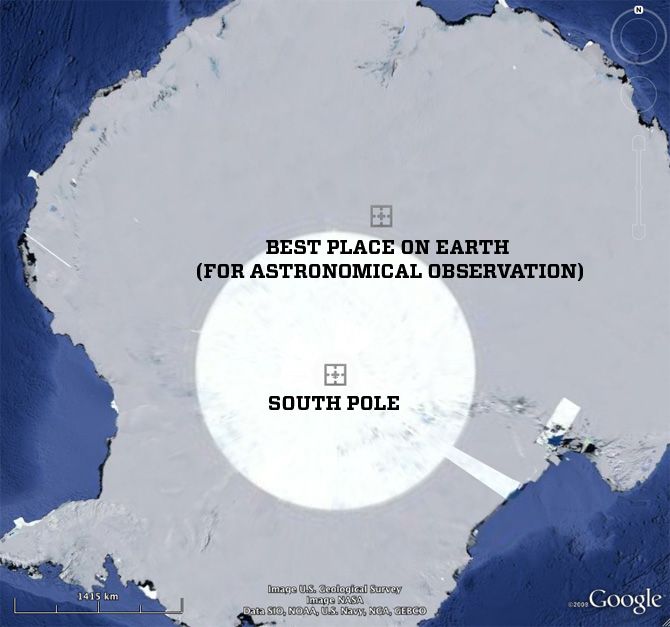
The next wave of research on the South Pole? Stargazing. Scientists have identified the perfect spot, known as Ridge A, located in the Antarctic interior [see picture above]. Why is it so perfect? Scientists combined all the factors that influence astronomy–cloud cover, temperature, sky-brightness, water vapor, wind speeds and atmospheric turbulence–and determined where they converge most auspiciously. “The astronomical images taken at Ridge A should be at least three times sharper than at the best sites currently used by astronomers,” said Will Saunders, an astronomer at the Anglo-Australian Observatory and visiting professor to UNSW, in a press release. “Because the sky there is so much darker and drier, it means that a modestly-sized telescope there would be as powerful as the largest telescopes anywhere else on earth.” The bad news? It’s so inhospitable to human existence, no human has ever set foot on the space. Well, no discovery is perfect. A similar viewing station nearby, the Dome A PLATO observatory functions year round robotically, without any human presence, and could serve as a model for Ridge A.
But until then, we have Hollywood.
~*ScriptPhD*~
*****************
Follow ScriptPhD.com on Twitter and our Facebook page. Subscribe to email post updates on our home page.

Who watches the Watchmen? A whole lot of people! One of the spring’s biggest breakout hits was director Zack Snyder’s cinema adaptation of the Alan Moore and Dave Gibbons classic 1989 graphic novel, Watchmen. ScriptPhD.com first caught up with one of the Watchmen screenwriters, rising star Alex Tse, during this summer’s Los Angeles Film Festival, and sat down with him recently to talk about the experience of working on the blockbuster. Before being contracted on the Watchmen project, Tse got his big break when his first script, Sucker Free City, was produced by Showtime Television and directed by Spike Lee. His current projects include a collection of sci-fi and comics screenplays, including the 1951 collection of science fiction short stories The Illustrated Man, the 2005 American thriller novel The Winter of Frankie Machine, the anime Ninja Scroll, and a film adaptation of the upcoming graphic novel Battling Boy by Paul Pope. Tse grew up in the San Francisco area before attending Emmerson College in Boston. Our full transcript under the “continue reading” jump.
ScriptPhD: How did you get involved in the Watchmen project?
Alex Tse: It’s the only way I could have been involved, given the amount of credits I had, which were not many. I had read that the project was going to Warner Brothers, I think at the end of ’05. And I knew that because it was going to WB, and I had done a lot of work there, that I would be given the opportunity to be heard. So I just told my agent, “Hey, get me in a room.” And they did, and I talked to [producer] Lloyd Levin over the phone and that went well. He had read a script of mine that he liked. And that just began the process, the competitive process, from there.
SPhD: Actually, when I watched the movie, I hadn’t read the graphic novel. And I have done since, and it only struck me after I’d read it, and talked to [author] Dave Gibbons at Comic-Con, how much material you guys had to deal with to condense into a movie. Interestingly enough, Dave loved the adaptation! It’s amazing how much of a higher standard is held sometimes by fans of a particular enterprise—
AT: [laughs]
SPhD: —than the creative talent! While the script was being written, was there an acute cognizance on your part that you had this one shot to get it right?
AT: Well, you can’t not be conscious of it on some level, I think, certainly it’s always even a hesitation of taking something like this on because you don’t want to be the person that messes it up. But what overpowers that notion is the fact that, and I always use a sports analogy here, at the end of the game, do you want to be the guy with the ball in your hands and the responsibility despite the fact that you might miss the shot or make the wrong play? Is that your personality? And I think for a lot of people involved, they wanted that responsibility, because for myself and I speak for [co-writer] David Hayter, and especially for Zack [Snyder], we were all fans of the material. So I think there didn’t have to be an overconsciousness of the fanboys necessarily, because we’re fanboys! So we come in from that perspective—now that’s much different than being a fanatic, and it’s interesting that you say that sometimes the creators of the material aren’t such sticklers for certain things that strict fans are. And when you’re coming from a creative background, especially a working creative background, you understand the pitfalls and challenges of trying to do good work, given the system, and you are not so hard on certain things because you understand how hard it is to get it to the point where it is at now. Does that make sense?
SPhD: Oh it makes perfect sense! And that was one of the things, after I read the graphic novel, that got me curious. What was the process of what stayed in and what didn’t? Watchmen has a LOT going on. It was really complicated, there were stories within stories, you guys kept out the Black Freighter. Take us through the development of the script.
AT: Well first of all, David Hayter had already done a draft, and had done a good job of the editing process. When I became involved in the project, and especially when Zack became involved, when 300 was successful, he had the leverage to call certain shots that people couldn’t do without that currency. If you go back and look at the comic book, there is a lot of time given to let’s say secondary characters that are not the Minutemen, that are not Rorschach or Adrian or what you would consider main characters. There’s a lot of pages given to the two Bernies. The whole issue with them is like the whole issue with The Psychiatrist. Now, obviously they’re not going to be main characters in this movie. So you can immediately edit that out, and the Black Freighter stuff that’s not gonna fit in the movie. And if you look at a lot of that stuff, you’ve already lost a chunk there. You’ve already lost a great deal with the most obvious stuff to go. And then, when you’re left with the main characters, we also lost a lot of the Golden Age Minutemen stuff, with the Hollis Mason crew, we lost some of that backstory. So, when you trim those things, you’re left with what you’ve determined to be the main ensemble. It’s pretty workable, if you go back and look at it and cut all the interstitial stuff. When you look at the core story and the core of what Watchmen is, and you’re determined to protect that—
SPhD: And certainly Dave Gibbons, and Alan Moore of course, must have had creative input into the transfer process. I can’t imagine not involving them in that.
AT: Well Alan Moore doesn’t give a shit! [laughs]
SPhD: Oh seriously?
AT: Yeah, he openly doesn’t give a shit. Dave was involved from the get-go. That was important. Critical box office numbers didn’t mean as much to me as his approval. His approval was certainly one of the highlights of my career.
SPhD: What drew you to screenwriting and who were some of your early influences in screen and print that you enjoyed growing up?
AT: Well I’ve always been interested in writing from a really young age, but you certainly don’t consider it to be a real job. I didn’t consider that until I went to college. And then I saw Pulp Fiction and that [movie] made me want to suffer for [the craft]. It’s an important distinction and an important decision, because everyone can wave a magic wand and want to be in the movie business. And I’ve always loved movies and television. My first love was comic books, but I couldn’t draw. Not that you have to draw to do comic books, but to be in comics, I would have wanted to be able to draw. I wanted to draw so bad, but I just sucked! It’s probably what I would have ended up doing, because that was a big influence. My parents loved movies, and they took me to see a lot of movies at a young age, and that certainly influenced me.
SPhD: What kind of comics did you like to read?
AT: Yeah, first, before I got into what you would call more “serious” comics, I was way into X-Men. All the mutant stuff: X-Men, X-Force, New Mutants, anything that was mutant related. I got into Batman, Spiderman, but mainly all the mutant stuff I really loved. Then in terms of writing, when I initially read comics as a kid, I might recognize the writer’s name, but I wasn’t buying stuff because of the writer. But the first time I really started paying attention to writers’ names was when I read Frank Miller’s Dark Knight Returns. And I was like, “I want to buy everything that this guy wrote. I need to read more of what this guy wrote.” So I started reading his Daredevil stuff, then I read Alan Moore’s Swamp Thing. And that led me to Watchmen and a lot of his other work. And I began paying more attention to who was writing these things. So it all kind of blended together in terms of writing influences. Frank Miller, Alan Moore, Star Wars was huge, all of the George Lucas/Spielberg early stuff.
SPhD: It sounds like you’ve been able to really combine your love of comic books and graphic novels with screenwriting. And in my generation, it seems like there’s this whole slew of movies that are going back to the graphic novels and the Golden Age serials. What do you think it is about this genre that so lends them to the cinematic experience?
AT: Well, I think you’re giving a lot of credit there to people. I’m talking about on the development side. Yeah, some of it is deserved, where you get people who recognize a piece of material that could translate to the screen. I think at this point, it’s just another source of material. Certainly there’s been a bunch of graphic novels that have been successful as movies, and of course anytime that happens people are just going to jump on that bandwagon. And they’re not necessarily comic book fans or anything like that. And in a very basic way, it’s a storyboarded thing. Like, “Look there’s pictures!” so you can have some reference. But I’d say it’s more a bandwagon at this point. Hollywood is always hedging their bets, Hollywood is always making the safer decision.
SPhD: Tell me a bit about the current project you’re working on. I know we heard a bit about it at the LA Film Festival earlier this summer.
AT: I’m working on Battling Boy right now. It’s been an interesting and fun process to work with Paul Pope. With anything in the film business, all I can do is my job, which is to write the best film script that I can, and getting a movie made is like winning the lottery. There’s so many moving parts.
SPhD: And you’re writing the movie at the same time as the graphic novel is being written, right?
AT: Yeah, I think the novel is getting released next year. I’m not sure what percentage [Paul] is done with, but it’s in the process. So that’s been interesting for both of us, but a lot of fun because he’s a great guy and really visionary.
SPhD: Anything else you’re really excited about that you’re working on?
AT: I sold a TV pilot and I’m going to have to start working on that. And we’ll see if any of the projects that I’ve finished a script for get made.
SPhD: Can you reveal…. comedy, drama?
AT: It’s going to be a drama, for FX. And I haven’t started writing it yet, so I’m going to have to get started on that soon.
SPhD: Well it sounds like you are very sci-fi/comic oriented, so if and when any of that pans out, you are more than welcome to come back and talk about that with us anytime you’d like! Alex, we wish you the best of luck in the future. Thanks so much.
AT: Thank you very much.
Watchmen (the theatrical cut and the extended Director’s cut) was released on DVD and Blu-Ray July 21st.
~*ScriptPhD*~
*****************
Follow ScriptPhD.com on Twitter and our Facebook page. Subscribe to email post updates on our home page.
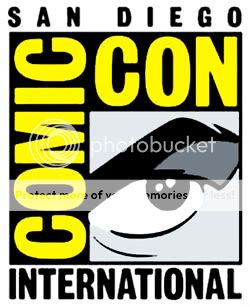
Well, faithful readers, our press room interviews have been transcribed, our complete pictures have been edited and labeled and sleep has still not been had. Someday. To make it easier to enjoy all the Comic-Con goodness from start to finish, we have condensed our four days of coverage in one place. Enjoy and thanks so much for following the journey with us!
Day 1: Includes pictures and scoop from the Warner Motion Comics, Battlestar Galactica Retrospective and Mad Science: The Fiction of Science Fiction panels, and press room transcripts of Psych and Burn Notice.
Day 2: Includes pictures and transcripts from the Farscape 10th Anniversary Reunion and FlashForward panels along with full transcripts from press room interviews with Bones and Big Bang Theory
Day 3: Includes exclusive pictures and videos of the enormous Lost panel/arena rock event and the Futurama! and True Blood panels, as well as press room interview transcripts with talent from Fringe and MythBusters
Day 4: Includes exclusive pictures and transcripts of two final Sunday panels: Supernatural and the long-awaited Comic-Con appearance of David Tennant with the Dr. Who panel.
All four days of coverage include the ScriptPhD.com Costume of the Day, chosen from an array of pictures that you can browse through on our Facebook fan page and extra side interviews and scoop from all the wonderful actors and writers we ran into.
But wait! There’s more! I’ve saved two special surprises for our last post. The first is our ScriptPhD.com one-on-one sit-down with 24 writer/executive producer David Fury. We go in-depth behind the show’s themes of terrorism, torture, national security and how they extend to the real-world law enforcement reaction to the show. We also have a free fan giveaway of three copies of the Comic-Con 2009 40th Anniversary souvenir books handed out only onsite.
To read our interview and enter to grab your copy of the book, please click “continue reading”.

ScriptPhD.com: Your show paints this terrorism world as very tense and pressing and in imminent danger. So it’s kind of a no-holds-barred search for information that saves lives. That’s your plot, that’s your premise. You’ll do whatever it takes.
David Fury: That is the premise, yeah.
SPhD: What response have you gotten from members of law enforcement, particularly from Homeland Security, in terms of how you portray this [arena], and if there has been any criticism, how is that then fed into the writing? I know you entertain and that’s your bottom line, but I’m just curious.
DF: No, it’s an excellent question, and we’ve certainly dealt with it a lot, particularly in the last couple of years. We’ve spoken to a lot of people at the Pentagon in law enforcement, now it’s federal law enforcement, and military. We’ve spoken to the men who literally interrogated the men who gave up Saddam Hussein. In fact, they couldn’t use their own names because these are top secret guys. How they feel about the show? They’re concerned, because the show does present this absolute, where we have a pressing problem, a bomb is gonna go off, an attack that’s going to happen, an assassination. And we have to get information quickly. In reality, if this wasn’t a real-time show, if this was a show that existed minute-by-minute, we would love to tell the stories of how they manipulate information out of their prisoners. But we are constrained by the premise of the show, which is a 24-hour period, real time, every episode one hour where very bad things are going to happen and what they’ve told us is, “Well that never happens. There’s never a ticking bomb. We’ve never been in a situation where there’s a ticking bomb and we have to have this information right now.” And to that I’d say, that’s the difference between reality and this show.
We try to be as true and as respectful to the people who do this kind of thing and we try, particularly last year, to address the nature of torture and the costs of that torture to all the people: the person being tortured and the one inflicting it. We try to deal with that, but it’s difficult for us to tell any stories where they use the methods that are actually being used right now to get information. These are brilliant people doing a very difficult job and a lot of it has to do with ingratiating them and the people they’re trying to interrogate and flattering them and promising them, and that’s just not dramatic. And if we were a show that was able to skip three days within an episode and say “Three Days Later…” and this is what’s happened, we’d tell that story, but we can’t, so we resort to Jack [Bauer] doing what he does, and other people, inflicting torture. But we’ve always been very conscionable in terms of the costs and I can tell you that the majority of the people are, I can’t speak for everyone, but we’re not pro-torture. We’re not, in life–
SPhD: No, no, I totally understand. The reason I asked you this question is because your show came along at a very important time in our nation’s history.
DF: Absolutely right.
SPhD: It was almost like timing meets opportunity. And you are an entertainment outlet, but it’s funny how you are capturing the zeitgeist. And I’ve heard a lot of people say, “Well if Jack Bauer can do this…” so do you ever worry that that bleeds over into a certain mentality–
DF: Well, it certainly does. And it does worry us, and it does apparently really happen. We’ve been told that some people in the military, I believe in particular, some of the younger recruits took to watching our show to get ideas [on] how to get information. And that was a scary thought to us. It’s like, “For God’s sakes, we’re not a training video! Don’t let Dirty Harry teach police officers how to catch criminals.” But you’re absolutely right. The show was born in a very tense time for this country. It was born in the shadow of 9/11, and it’s now eight years later and we have to maintain, for the purposes of drama, that kind of heightened threat. The one that we’re kind of feeling a little bit more relaxed about and we’re not really thinking about. But dramatically in the world of 24, it’s something that like for Jack Bauer, as we pointed out, he’s starting the season in a happy place, but as we all are, as we’re much more optimistic and positive, but something can happen to just turn it back all around and we’re back where we started eight years ago.
SPhD: Well I want to thank you on a personal note, because I was in New York City when 9/11 happened, unwittingly so actually, and being there [during a terrorist attack] really re-prioritizes your moral and political ambiguity of where you stand and your mindset when something like that happens to you. So your show really brings back a lot of the feelings [and struggle] I had when that happened. I’m really happy to hear that you’re cognizant of the greater outlet of what you are doing and I thank you for that.
DF: We are. Well, thank you for that. We’re very concerned, we certainly don’t want people to look to us as we’re painting the world as we see it. We’re painting a world where a character like Jack Bauer can exist and can function. And if it resonates with people’s fears, great. It doesn’t have to. I think it works on its own level as a character study of a man who is forced to do terrible things to protect the country.
SPhD: Thank you, sir.
DF: You’re very welcome!

And now, for my favorite part of this process… being able to interact with our wonderful ScriptPhD.com fans and make you happy! I’m so grateful for the support our site has gotten and for all of you who have emailed to let us know where our transcripts have needed updates or adjustments, that we have decided to give away some Comic-Con memorabilia. Rather than giving away banal chachkes that appear every year, we wanted to give away something unique and special. This year, to celebrate the 40th Anniversary of Comic-Con’s existence as a festival, organizers put together a gorgeous commemorative book chronicling highlights, pictures, posters and factoids from each of the 40 conventions to date. For sci-fi, Comic-Con and comics buffs, this collector’s edition is a must have. We rounded up three extra copies (shhhh don’t tell anyone!) and will mail them to three lucky fans for free anywhere on Earth! Sorry, at this time, extra-terrestrial residents are not eligible. To make the process fair and transparent, the first three comment posts with a valid email address will win the prize–and don’t worry, if I can’t approve them right away, they are timestamped. We will contact the winners for mailing info. Good luck!
Please credit all photography to ScriptPhD.com if you take any for your own use.
~*ScriptPhD*~
]]>
Well, the 2009 Comic-Con marathon has come to an end. Sundays at Comic-Con tend to feel like a blissful hangover after a three-day non-stop party. You’re not entirely sure of what just transpired, but you loved it, and have it in you for just a little bit more. And our four-day coverage ends with transcripts and pictures from two fantastic and much-anticipated panels: Dr. Who, the longest running sci-fi show in the history of television, and Supernatural. We also have our final ScriptPhD.com Costume of the Day. Come back to ScriptPhD.com on Wednesday, when we post all the inside scoop and behind-the-scenes action at our press rooms. We will conglomerate our four days of coverage, pictures, interviews and impressions into one post to make it easy for you to get all your Comic-Con goodness in one place. Click “continue reading” for our final installment.
Dr. Who
Moderator: Robert Lloyd (Los Angeles Times)
Panelists: David Tennant (The Doctor), Russel T. Davies (writer/executive producer), Euros Lyn (director) and Julie Gardner (executive producer)

The Dr. Who panel didn’t feel so much like a convention gathering as a rock show. A deliciously raucous, dedicated group of fans were ready to get the party started even before the cast and production talent stepped on the stage. A brief introductory clip of Dr. Who evinced pandemonium from the crowd. The ScriptPhD overheard backstage that the Comic-Con organizers have been trying to get David Tennant and the Dr. Who masterminds to do a panel for a long time, to no avail. So you can imagine the decibel level of Ballroom 6 at this moment:

Robert Lloyd: Good morning class. Welcome to Dr. Who 101. My name is Robert Lloyd, I’m a TV writer for the LA times, a little town about 3 hours from here. In 2005, BBC Wales brought back to life a little sci-fi show called Dr. Who that had been missing from the screen for 15 years. It’s still
the same show, but it’s also a different show. It’s bigger and better. It’s rooted in mythos and values of original, but way beyond what a Saturday night kids’ show should be. It’s a show about love and loneliness and beauty and terror in a universe that can mess with your mind. I really love the show’s ambition, its bravery, its willingess to push the edge of outlandishness and absurdity. Mostly because behind all of the craziness and swashbuckling and technobabble is real a poetry and vision about the world and people in it. It’s also
a show that can make me cry. This is a summing up in a way. This team has finished its work, but there’s four more hours of the Tenth Doctor yet to come and you’ll be seeing some of that this morning. We’ll start with clip from “Planet of the Dead”, which will premiere tonight on BBC America.
[Welcome and introduction of Dr. Who cast and producers to wild applause and cheers]
Robert Lloyd: There has been lots of speculation that all these people are gathered here to hear about a movie. Can we just address this and get it over with so we don’t hear about it the rest of the morning?
Julie Gardner: Thank you all for coming. I’ll start with the bad news. We aren’t making announcements about a Dr. Who movie. I don’t know where the rumor started. But since we’ve talked about it, we were thinking maybe it would be a good idea to do at some point. Is this something that you want? [wild cheers] So no announcement about a movie, but we have a teaser trailer of David’s last tenure as the tenth doctor.
[clip]
Julie Gardner: What do you think of all this David?
David Tennant: We should see [the clip] again! This is awesome but quick. It’s so much to take in, right? Roll the tape!
[repeat of tape]
Robert Lloyd: Obviously this is an apathetic crowd. Give us a sense of the immensity of the cultural impact of Dr. Who in the UK and what it meant to you, haivng grown up in the Dr. Who world. Because here in America, it’s something for cable, but in the UK it’s a Saturday television event.
David Tennant: And it was when we were kids as well. I grew up obsessed with it really, so it’s strange to be sitting here at 38 and in it. But it’s definitely part of my recent memory in Britain.
Russel T. Davies: Loved it all my life and I’ve thought about it all my life. And now someone has taken it and made it into a TV show. Because really in Britain, that’s what it is: it’s this phenomenon that wherevery you go, there’s t-shirts and backpacks and people are talking about it. My dad is old and blind and he sits there all day listening to the radio reports, and he counts at least three Dr. Who references in any show. It’s mad, I can’t get my head around it.
David Tennant: It’s overwhelming to walk into a supermarket and your face is on a cake and t-shirts and children’s pants, which isn’t something they prepare you for in drama school. It’s overwhelming, and difficult to get an objective, that’s why it’s great to come here to gauge the fans’ response. We love making it.
Russel T. Davies: And that’s what we want here as well, everything in the US: the t-shirts, the lunchboxes, the cakes. Go out and spread the word. Tell peple about the show.
Robert Lloyd: Euros, were you a fan of the show as well?
Euros Lyn: A huge fan. And watching the show as well in Whales, which is this little quiet corner of UK, I little imagined that this could happen.
Julie Gardner: I didn’t watch as child, but when I took over, Russel Davies gave me a homework list, to watch his favorite titles. And I think my favorite had to be City of Death, a Tom Baker story. I loved it. I thought “Wow there’s so much we can do with this, so much emotion, it’s mad, we can really do so much with it.”
Robert Lloyd: Do you see the current show as fulfillment of the original concept, or a left turn?
David Tennant: No it’s the same show, the story continues. I’m the same man as William Hartnell, I’m just wearing a different wig.
Robert Lloyd: David, do you try to incorporate the other doctors in your peeformance?
David Tennant: Not really, but they’re all immersed in the show, there’s bits of all of them in there somewhere, yet you make the role new and of yourself, because that’s how works. It’s not like James Bond or Sherlock Holmes or other characters reborn in the same mold. We want to break the mold a bit, make him a new man, which is why I went with a different wig than William.
Robert Lloyd: There’s an amazing amount of material and tones and ideas, somtimes from episode to episode, it seems the visual plan changes. Euros, you directed two consecutive episodes at the beginning, and they go from 5 billion years in the future to Victorian England. Can you address that time jump?
Euros Lyn: From a tonal point of view, we set out to give different stories different looks for different worlds, and it all stems from the script, our guiding light. Taking stories in different directions into the future and the past demands a difference. Yet the adventures, the humor and the excitement go into all. There’s a universality and a huge difference at the same time.
Robert Lloyd: Julie, talk about making a show that looks that good on such a tiny budget.
Julie Gardner: We go over budget.
David Tennant: But not irresponsibly.
Julie Gardner: Russell has great writers, and comes out in the beginning to plan everything. Part of that is practical and creative. We make hard choices about special effects, stunts, and we balance it. Out of 13 eps, you may notice a smaller episode, which helps pay for the Christmas special. So we do little tricky things, we double bank two units running at the same time. We call in favors and a lot of love.
Robert Lloyd: My impression from the show and all the ancillary things I’ve read about Dr. Who is that there’s incredible dedication and love involved. Lots of camaraderie. Was it an unusually privileged situation in which to operate?
Julie Gardner: I’m thrilled.
David Tennant: It’s true. It’s a very committed set. There’s lots of passion about the show. Because people grew up with it and loving it, and are now making it. We manage to expand our budget through good will and are happy to be there. We benefit greatly from the show’s legacy.
Robert Lloyd: Was there a moment when you realized you were onto something bigger than you expected in terms of scope and ambition?
Russel T. Davies: I suppose when the history of the show is written, one day people will realize Julie Gardner’s role. We had ambition, we had goodwill, but she raised an amazing amount of money, which in the labyrinthine, Dickensian world of the BBC is tough. Julie also had to raise it from scratch each year, with different sources. That’s when Julie got on board and thorough motoring and pushing the ambition, size, and scale. That’s when I began to think huge. And I thought it wold only go one year and here we are.
Julie Gardner: It was easy to motor. Russell always thought big from the first moment. Yes, we had huge stories, a big production team, big trailers, blockbuster trailers. The most important thing was thinking 7 o’clock bbc prime time. We had to think mainstream.
Russel T. Davies: Everyone worked hard and never dreamt of this kind of success—it’s amazing and mystifying. And THANK YOU.
Robert Lloyd: We have a special presentation before fan questions. Craig Glenday of the Guinness Book of World Records has something for you.
Craig Glenday: I’m back again! Dr. Who has been in the Guinness Book of World Records for a long time, it’s the longest-running sci-fi show on TV, we all know that. But I have the Dr. Who entry in next year’s book. And today we want to make a special announcement. That one record is not enough. You guys are too good for one record. Based on sales, distribution, downloads, illegal downloads, and longevity, Dr. Who is the most successful sci-fi show on television for sure.
Russel T. Davies: The most successful sci-fi show on television? I can hear Comic-Con war breaking out there. Close the doors, don’t let Star Trek in. Eat that Supernatural, actually eat me, Supernatural. And I’d like to accept this in the name of Verity Lambert, who set up Dr. Who in 1963. She’s no longer with us but she’s smiling somewhere because this is hers. Thank you.
Robert Lloyd: Fan question time.
Fan: David, there’s a rumor that you wear the long brown coat because you’re fan of Firefly. True?
David Tennant: Ohh, I’ve never heard that one before. There’s a new rumor about me every day at Comic-Con. I’m playing The Hobbit, apparently. I love Firefly and Serenity, they’re excellent. Both great shows. But they’re not the inspiration for the coat. When Russell and Julie first asked me to play the part, I said “Can I have a long coat?” It’s as basic as that.
Fan: You look good in it!
Russel T. Davies: He looks good out of it. [laughter]
Fan: David, if you could be any other doctor, who would you pick?
David Tennant: Wow, I need to be careful here. Splendid chaps all of them. I guess that’s the traditional answer.
Fan: What was best part of working on Dr. Who
David Tennant: My favorite is everything. It feels wrong to choose. Each episode is such an individual thing, with a different cast, setup and script. It feels like choosing between your children, just wrong. It’s been four years of extraordinary moments. I take away so many brilliant memories, this [Comic-Con] being one of them. And that’s before I’d even seen the final episodes.
Fan: You never get your first doctor. Who was your first doctor? How did you deal with the trauma of replacing him?
Russel T. Davies: I still remember William changing into Patrick. I was just at the right age for Tom Baker, we love him. But as for trauma, it can be quite fearsome and horrific. Murray Gold our composer—Euros, the director of the finale—
Euros Lyn: We’ve been spotting the finale [for various cast and crew], and we reached the last twenty min or so of the last episode, and Murray hangs his head, starts shaking, just sobbing uncontrollably. And you all will too when you see episode. Get your tissues ready.
Julie Gardner: There was a lot of crying when we shot the last episodes. The crew was really moved by it. So many gododbyes. Every day. The goodbyes went on for weeks.
David Tennant: I remember being a kid when Tom Baker left, I’d idolized him. I couldn’t concieve the idea of a new doctor. But then Peter came along and within three weeks I thought he was the best. So it’s part of what makes this show go on forever. Hopefully you’ll watch the final episodes, and then a few weeks later you’ll think Matt Smith is the greatest thing ever. Because he is. Change is a part of the show and I’m proud to have been a part of history, but also proud to hand the role over and that it carries on.
Fan: I heard that John Barrowman has stolen things off of the set. What have you stolen off the set, if anything?
Julie Gardner: He just stole thngs to be strip searched on the way out.
Russel T. Davies: One of the Doctor’s jackets. Someone took them.
David Tennant: There is a sequence in final episode where one of the Doctor’s jackets gets compromised and we were going through the shots before and after, the last day, last thing we did, tears, hugs all that. And the jacket had disappeared. eBay is being scoured. But it wasn’t me.
Fan: David, you’re my Doctor. I’m so sad to see you go, any possibility that you might come back for specials or a movie?
David Tennant: Well, the dust has to settle. And the fiftieth anniversary [of the original Dr. Who] is in 2013. I don’t know. That is not an announcement. Don’t twitter that. It’s not a thing. Just an idea.
Fan: Do you all have a favorite assistant [Doctor’s companion] character that you prefer?
David Tennant: It’s hard to choose. What do you guys think? [Everyone in the crowd shouts something different.] Well, that just sounds like mwahhhhhh. The one thing I leave show with sadness about, is that I didn’t get to snog Bernard Cribbins. I got to snog all the other ones. Or am I? You haven’t seen the last episode.
Fan: David, would you be returning as the other doctor, the one who’s coming with Rose?
David Tennant: There are no plans, but anything can happen.
Fan: What was like working with Nicholas Courtney in Unit Stories?
David Tennant: He’s a legend. I did a couple of audio stories with Nick Courtney long before any of my television work. He’s the nicest man you could hope to meet. I just sat there thinking Brigadeer! Huge fan of his, wonderful, brilliant man.
Fan: You don’t want to pick favorites in Dr. Who, but as a fan what was something that was exciting for you in this show or other shows?
David Tennant: I’ll tell you what it was. When I started, we had the first read-through, and we read the first three episodes all at once. Everyone who had ever worked for the BBC was there with their note pads staring at me. I spent the first hour thinking I’d be sacked at any moment. The replacements were just lining up. It was a terrifying but wonderful prospect, and then we read the episodes out of order. Suddenly, halfway through the read-through, a voice from my childhood was calling me Doctor. When the 8 year old boy met the 35 year old boy, and it wasn’t the playground but doing it for real, that was quite special.
Julie Gardner: And that reminds me, we should do a little plug. David’s Doctor is coming up in the Sarah Jane Adventures.
David Tennant: Yes, and the episode is called the Wedding of Sarah Jane Smith.
Fan: How much fun was it doing the laugh on Top Gear? Will you still hold the title of the fastest doctor on four wheels?
David Tennant: It was fun, but it is forever blighted by fact that I’m .02 of seconds behind on the leader board before Billie Piper. And the only reason I’m behind Billie is that she was wearing a see through top. So Jeremy Clarkson bumped her on the leader board. If Billie didn’t have such good breasts, I’d be higher on the leader board.
Fan: As an alumnus of the Royal Shakespeare Company, has your training affected your way of reimaginig the doctor?
Julie Gardner: David you did meet Shakespeare in an episode of Dr. Who. That must have informed your interpretation of Hamlet.
David Tennant: I don’t know. It’s hard to tell what kind of actor you are. You can’t judge, can’t be objective. There is certainly a great tradition of shakesperean actors being the Doctor. Chris played Hamlet, Tom played Macbeth. I have no conclusion to make.
Fan: David, what sort of roles are upcoming for you?
David Tennant: I don’t think I’m in Harry Potter. Apparently I’m playing The Hobbit. No phone calls about that yet, but I don’t know, no idea. There is a film at the moment—I’m playing the villain in Centrinians 2, I’m doing Hamlet, but beyond that, who knows?
Fan: Prior to the new series, it was hard to find American fans. Are you surprised at the popularity explosion [in the States] of the new series?
Julie Gardner: I’m struggling to work out how big it is. Are we huge? Russell and David?
David Tennant: We went on Good Morning San Diego this morning and were met by a man in a t-shirt with a tardis on its front. So it’s hard to quantify. People who know it REALLY know it.
Russel T. Davies: It’s hard to quantify because you are told it’s not known, but then it’s the catch of the week in Entertainment Weekly. But word is spreading, and it’s up to fans like you to keep the faith and spread the word. Give yourselves a round of applause.
David Tennant: It feels like it should have been from the start. And they’re behind it, and will show episodes much more closely, and now uncut, on BBC America. So we’re coming but keep proselytizing.
Fan: Russell, you’re leaving Dr. Who, but do you have future plans for Torchwood?
Russel T. Davies: I hope so. We were astonished by the success of that series. We tripled ratings. I hope so, I can’t promise, it’s the middle of a recession, but we want it too. Fingers crossed, but maybe the characters you want back won’t be back.
Fan: Why did you cast Captain Jack as American?
Russel T. Davies: We had actually singled John out for that part. We knew he could do a Scottish accent. We wanted him because we loved him. He did it for us in all accents, and in the end, I just thought it made it bigger to have American accent just because you have American soldiers in Britain. It felt right. I didn’t know he’d go on to do Torchwood. That’s very rare in the UK to have an American lead in a British show. But he proved everyone wrong because that’s how brilliant he is.
Fan: Is the difference between each Doctor based on each actor’s perspective or is it in the writing?
Russel T. Davies: I don’t tend to write the Doctors differently. There are differences. But it’s the Doctor in my head who drives the script. It’s a joy to cast the show with all these talents, you have the freedom to write anything. Cast well and your imagination goes to the horizon. We are absolutely limitless to go anywhere because the cast is so brilliant.
David Tennant: Euros, you’ve worked with two of us. Who was better?
Euros Lyn: You David.
Fan: The archaeologist from Silence in the Library, will she be back, and will we see the interaction between her and The Doctor?
David Tennant: Well, it’s not on our watch anymore, really.
Julie Gardner: We are now just happy viewers. We don’t know anything.
Russel T. Davies: Do a search online for River Song. Alex Kingston and River Song. You’ll be very happy.
Fan: Can you comment on the rumored return of Gallifray and or the Timelords? Would you consider coming to Galley One?
Russel T. Davies: As for those rumors, I don’t know what you mean. Let’s just say that in that clip, the voice was Timothy Dalton playing the narrator. One day we keep getting invited to conventions, but there’s no time. That was Alexandra Mowen as Lucy Sexton. She’s coming back.
Fan: David, do you have any words of wisdom for Matt Smith for the impact that playing The Doctor on personal life?
David Tennant: We’ve chatted a couple of times, he’s enthused and clearly going to be brilliant. He’s such a talent, there is nobody in the UK who’s worked with him who doesn’t rave about him. Nothing but praise to lavish. He doesn’t need any advice. Dr. Who is a big thing in Britain, there’s very few television shows, and you get attention, some of which is nice and some that’s intrusive. But he’ll cope. He’s bright, normal, and down to earth.
Russel T. Davies: [regarding videotaping the panel] This tape we’re making on stage will be on Dr. Who: Confidential, so you will all be on Dr. Who: Confidential.
Fan: In the episode where playing teacher for school, if you were a real teacher what would you teach and why?
David Tennant: You save the hard ones for last! I have absolutely no idea. The only subject I liked was English. I’d probably be an English teacher and my set text would be anything by Russel T. Davies.
Robert Lloyd: Thanks everyone for getting up so early to stand in line for this, and a big thanks to everyone who came for the panel.
Supernatural
Moderator: Maureen Ryan (Chicago Tribune)
Panelists: Misha Collins (Castiel), Jim Beaver (Bobby Singer), Eric Kripke (creator), Ben Edlund (executive producer) and Sera Gamble (executive producer)

I was really excited about covering the Supernatural panel not just because of the fan base of this show, but also because the moderator was the delightful Maureen Ryan, television critic for the Chicago Tribune. The ScriptPhD has admired Maureen’s work for a long time, and it was a pleasure to meet and chat with you, Mo! Keep up the great work.
Eric Kripke: Castiel is coming back, I’m happy to say. We spent five minutes talking about wardrobe, do we do a catsuit for him. He’s back in his catsuit.
Maureen Ryan: So that begs the question: front seat or back seat?
Misha Collins: He as a special respirator to sit in the trunk. He’s going to breathe through a straw with a periscope.
Maureen Ryan: How do you solve problem like Lucifer? This guy is out to do some damage, but he’s all about herbal teas and feelings and sharing? He’s a softer, kinder Lucifer.
Eric Kripke: Yes, but we wanted to present a Lucifer that hasn’t been seen on TV and movies often. We’re shamelessly stealing from the beginning of Paradise Lost. He’s a sympathetic devil with a point of view. He was betrayed by those closest to him, and has a definite chip on shoulder. It’s a little personal. He’s the most honest of all the characters. Of course, there is that thing about ending the world, but otherwise, we’re trying to do a complicated Lucifer, where the angels can be dicks and Lucifer can be sympathetic.
Misha Collins: Except me.
Maureen Ryan: What does bobby think of all this? Is he going to pull out a can of whoop ass on boys?
Jim Beaver: Bobby has a very interesting scenario. I wish I could tell you about it, but I can’t because the real Lucifer [Kripke] is sitting by me.
Maureen Ryan: I am hearing that maybe Castiel and Bobby have an upcoming scene or two. They’re becoming buddies.
Misha Collins: It’s more of a romantic type thing.
Jim Beaver: On or off camera? It’s an unrequited thing for Castiel. Very unrequited.
Maureen Ryan: You’re going to separate the love affair of Dean/Castiel. There’s an apocalypse going on, things are crazy. Kind of a team building enterprise. Are we going to see any old friends or enemies coming out of the woodwork?
Sera Gamble: Definitely old friends. Because of the apocalypse, old hunters are coming out of trenches, like Rufus, who kind of thought he was over the hunting thing, and Ellen, who wasn’t even a hunter, but decided that she has to get into it to back up her daughter Jo. You will see all of them in episode 2.
Maureen Ryan: And Meg. You said we might see her in more than one episode.
Eric Kripke: Yes, you’ll see her in the season opener, and she’s played by Rachel Minor. We struggled with how to put her in Nikki Cox’s cat suit, because she’s buried and rotten, her hair is a different length, but Rachel does a terrific job at it. I’m borderline OCD and I want to fill every pothole. The Croatoan virus is paying out in episode four.
Ben Edlund: In episode four we go into the future. It’s five years into the apocalypse, and we wanted to blow the doors off the world. One thing is Sarah Palin is president. It’s the apocalypse, what do you want?
Eric Kripke: In all seriousness, it’s our 28 Days Later episode. You can see the end of the world with Ben’s sensibility. It’s really really cool.
Maureen Ryan: I think we have some old business to address. What did Ruby know, and was she tricking Sam?
Eric Kripke: From her first introduction in “Magnificent Seven” and then the first time you saw her talk, she was always a bad guy. We, the producers, always knew that her motivation was to double cross the boys, she was always working for the demons. It made us frustrated to read online chatter and debate about that, but in our back pocket we knew she was evil and yet couldn’t tell anyone about it. We kept trying to make her likeable, but there was that problem that she’s a demon. And you can never entirely trust a demon.
Maureen Ryan: Who changed the voicemail message in the finale?
Eric Kripke: I’m not going to tell you, because I think it’s interesting and open for debate. Some things are fun to talk about and discuss. I have my belief of it but I don’t think I’ll ever say. We always talk about it on set.
Maureen Ryan: What’s the relationship between the boys like at this point? Under the circumstances, it can be a downer for that.
Sera Gamble: Actually, the apocalypse is shockingly amusing. Last season we had some funny episodes, but at times the show was almost suicidally dark. This season we’re in the worst situation you can be in, and yet it’s kind of funny at points. It’s pretty bonkers, we’re enjoying it.
Eric Kripke: As far as the boys’ relationship, the network executives called us and said “Oh you’re doing the apocalypse. Aren’t you afraid it will be ohhhhh… I don’t know… depressing?” But I said yes, the situation is what it is, but hilariously enough this is the most optimistic season we’ve ever done. We pent all last season tearing the guys apart and this is the season they come back together. Family is going to save the world and when you’re in this big story, for once you can aim at the good guys winning, it’s very Polyanna in its tone.
Maureen Ryan: Let’s talk about Castiel’s arc. What’s his status? Is he the same guy? Same abilities?
Misha Collins: Yeah, I think it’s been some of my best work so far. Yes, I think he’s different. When you’re blown molar by molar into someone’s hair, it changes you. He lost a bit of his angel mojo, he lost some friends, and has a very ambitious mission he’s on, it’ll be very satisfying for you.
Eric Kripke: But yeah, it’s kind of an epic arc. He’s cut off from heaven and in full-on rebellion mode. But he goes through his own mythology arc and emotionally at that. Castiel must become human in a way, he’s not an etherial angel anymore. One teaser title from an upcoming episode: Dean Takes Cast to a Whorehouse.
Maureen Ryan: I heard some talk that you only wanted to do five seasons, but I’d be happy with six or more. Care to comment?
Eric Kripke: Here’s the honest answer to that. Because I have very low self esteem, I never dreamed Supernatural would even go five years, and now that it keeps picking up steam I’m shocked. If there’s more stories to tell, then it’s a real possibility. But right now, we are thinking of ourselves as base camp on Everest. We are just finishing writing episode 3 and breaking episode 6, and we have 16 more after that, so we’re kind of neck deep in Season 5. We’ll see.
Maureen Ryan: So this apocalypse Lucifer thing, you won’t stretch that beyond the season?
Eric Kripke: No, we have a five year story, and we’re in the fifth year of that. We owe it to you the fans to not water it down, dilute it, or stretch it beyond that. We just want to tell the story. We don’t need to go down endless mystery on top of mystery. But another chapter can certainly begin. We’ll see with everything.
Fan: Jim and Misha, what’s it like knowing you’re just as important as Jensen and Jared’s characters?
Misha Collins: Well, it would be great.
Jim Beaver: Who are Jensen and Jared?
Misha Collins: Yeahhhh, it’s nice to have a supporting cast like Jared and Jensen. They really are just a great supporting base line for fleshing out stories that everyone cares about. [laughter]
Fan: Will Castiel get to help out on any monster of the week hunts and what’s the dynamic like after what happened?
Misha Collins: Yes and dynamic is awkward, to say the least.
Fan: Had you always intended to take the show in this direction or have things developed over time?
Eric Kripke: We tend to start these things with cocktail napkin sketch of a five year plan. And in our case, the plan was always driven by demon side of it. So yes, progression of the demon ladder of the dark side and the apocalypse was pre-planned. But to say there will never be angels would have been a mistake for us. That’s one of the coolest part of the show. We didn’t have the rebellion. And thank god, it totally rejuvenated season 4. So the angels did evolve with the process.
Fan: One of my favorite things about the show is the music, but it’s really dropped off. Is it coming back?
Eric Kripke: I know, it hurts us too. It all comes down to the budget. You have to pay for rights, which can be expensive. Production value takes precedent. So we used to have a particular music budget for the show, and we had to cut the music budget in half. It used to be one song every episode, then it started getting to be one song every other episode, one every third, you get the idea. Sometimes we’re so over budget and irresponsible, that’s the casualty. It’s literally where one song makes the difference between getting to shoot the episode.
Fan: Erik, you teased about looking at the future. Will the idea of destiny be addressed? Can you change your destiny?
Ben Edlund: That’s the question of the episode. Destiny is one of the key themes of the show. We’re planning on some mind-bending loops. Can you avoid destiny, what you already know is going to happen, by the choices you make?
Maureen Ryan: How much will we see Mark Pellegrino?
Eric Kripke: He is currently shooting episodes 1 and 3, and then won’t see him for a while. I know he’s on Lost and bad-ass as Jacob. He was actually in the running for Castiel—it was between Misha and Mark, and they were both so great, but Misha squeaked by. But we always loved Mark and remembered him, so went right to him when the part of Lucifer came about.
Fan: When you go through the writing process, how do you go from ideas to episodes?
Sera Gamble: Coffee mostly. It’s like American Idol—the strongest ideas win. If they survive, they end up on the TV screen, but they must survive with the long hours we work.
Fan: At the beginning of season, we were first introduced to mythology. Have you received any backlash about themes of angels and demonds, and how does that criticism fuel the stories?
Eric Kripke: surprisingly little. Every so often you see an individual saying they don’t love it, but by and large…
Sera Gamble: We don’t have agenda to criticize or push any one religion. These ideas have been done before and have entranced people for one millennium, and it’s general.
Eric Kripke: Sometimes we laugh about sacrilege that we might be doing, but we’re not the first to ask about God’s will, about a benevolent God letting bad things happen. That’s not new, provocative material. We just happen to be asking it on our horror show on CW. One of our writers is good friends with a priest who loves the show, and loves what we’re doing. He’s interested that a show is even attempting it.
Fan: Is there a chance we’ll see the cult God return?
Ben Edlund: I think so, yes. The rumor and myth and legend of the cult doesn’t go away, you’ll see it come around.
Fan: Misha, based on personal beliefs, how did you prepare for playing a morally gray angel?
Misha Collins: I set my personal beliefs aside. Castiel hasn’t been walking among humans for 2000 years, so he has a curiosity about humanity. It’s been an interesting question. What does it mean to be human? Not many roles allow you to explore that in depth.
Fan: The meta-episode, what made you decide to do that?
Eric Kripke: No, we just love navel-gazing. It was writers’ assistant Nancy Weiner’s idea, totally. She wanted to do a stranger than fiction episode, in which their characters find out they’re in a book. At first we were like, “No, that’s crazy! We’re not going to do that.” But the idea kept floating around, we couldn’t shake it. Then it just snapped into focus, because it tied into the mythology. I have such a complicated relationship with the online fandom, I’m very attracted to poking loving fun of them.
Fan: Are we going to find out what happened to John?
Eric Kripke: Jeffrey Dean Morgan is a huge star now, in case you haven’t noticed. We’d love to explore that and have him, but it’s about scheduling.
Maureen Ryan: But the boys’ mom? Will we see what happens to her?
Eric Kripke: Samantha is awesome! She was sort of in episode 21. But I can definitely say Jessica is coming back.
Fan: Are you ever going to distribute official soundtrack for show?
Eric Kripke: This really is not the first time we have heard this question. We took the idea to record companies, but they were not interested. So we pitched it out, and our music supervisor is great, but she was met with a big fat middle finger. We’re rying to put together a “virtual album” playlist on iTunes so you can at least download it. We keep saying we’re going to do it, but then we get back home to Los Angeles and forget. But this time around we’re going to do it.
Unfortunately, due to our hectic schedule of interviews and panels, the only thing we didn’t have a chance to do at Comic-Con this year was roam the convention floor—we’re relievedbummed, but it’s something to save for next year. Nevertheless, this year’s Comic-Con was bigger than ever and did not disappoint. Thank you for following along with us, and we promise more surprises in the week to come: full transcripts of all ScriptPhD.com press room interviews (Psych, Burn Notice, Bones, Big Bang Theory, Fringe and MythBusters), a special extra one-on-one interview, and fan giveaways of 40th Anniversary Comic-Con memorabilia. Don’t forget to follow ScriptPhD.com along on our Twitter feed and our Facebook page for announcements, updates and future article alerts. A huge thanks also goes out to the hard work and assistance of all the wonderful media coordinators, publicists, and technical crews that facilitated press schedules, helped us with an overwhelming schedule of interviews, and generally made an otherwise gargantuan event manageable and enjoyable.
And now, for the Day 4, and final, Comic-Con Costume of the Day… Jane Austen Book Club: Freddy Krueger Edition:

As Comic-Con 2009 comes to a close, this poor fan embodies the physical state of the ScriptPhD:

Luckily, we have a whole year to recover before we do it again. We hope those of you who have found us through our Con coverage stick around for more coverage of the best of science and technology in entertainment, pop culture and media. Thanks for following along.
A very exhausted and spent ~*ScriptPhD*~
]]>
Are you guys still staying strong and ready for more Comic-Con highlights? Good, I thought so. Saturday is always an action-packed highlight day for the Con, with the best of science and entertainment panels saved for last. And this year did not disappoint. We got an up close and personal view of the very last Lost panel ever as we watched right from the stage and bring you great pictures and highlights from the panel. Thanks to two great friends from the production crew, we were able to enjoy the controversial Futurama! panel from backstage, where we caught up with the writers and producers. Along with a full transcript of the highly anticipated True Blood panel, we had two more great press rooms with Fringe and MythBusters. To be a part of the Comic-Con action, please click “continue reading.”
Lost
Panelists: Damon Lindeloff and Carlton Cuse (executive producers and head writers of Lost) and special guests to be named later.
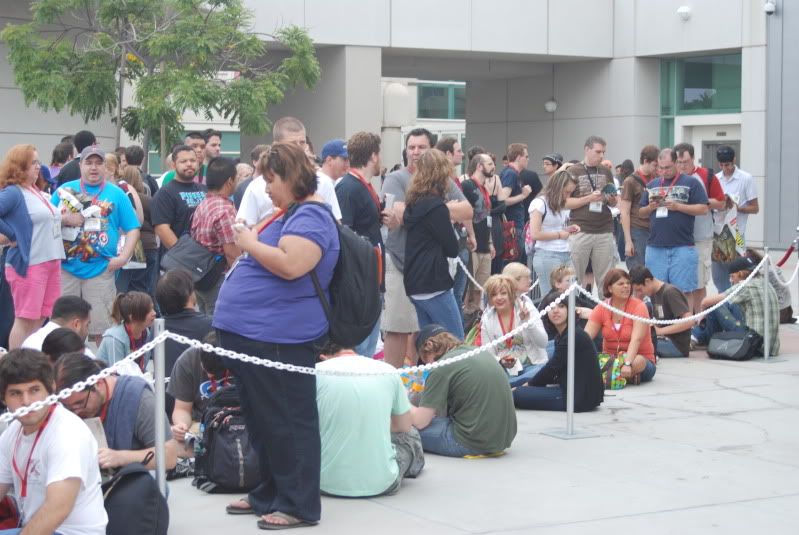

We can say with a high degree of scientific certainty that this year’s Lost panel, the last ever at Comic-Con, was the most anticipated event, as evidenced by queues that wrapped around the convention center, around the marina, and back. Some fans had started lining up in front of the Hall as early as 7 o’clock… the night before. Luckily for you, our faithful readers, ScriptPhD.com had a front and center seat right up on the stage with the press to take in every moment right up close as it happened. And since a picture is worth a thousand words, we decided to let you experience the full Lost panel in the pictures we snapped and with YouTube videos kindly recorded by Tostie Productions.
Part 1
Part 2
Part 3
A fun Season 6 promo!
And an even more fun parody video
As a supplement to the full videos, scroll down for some fun pictures capturing the best moments of the panel. Please credit all photography to ScriptPhD.com if you take these for your own use.


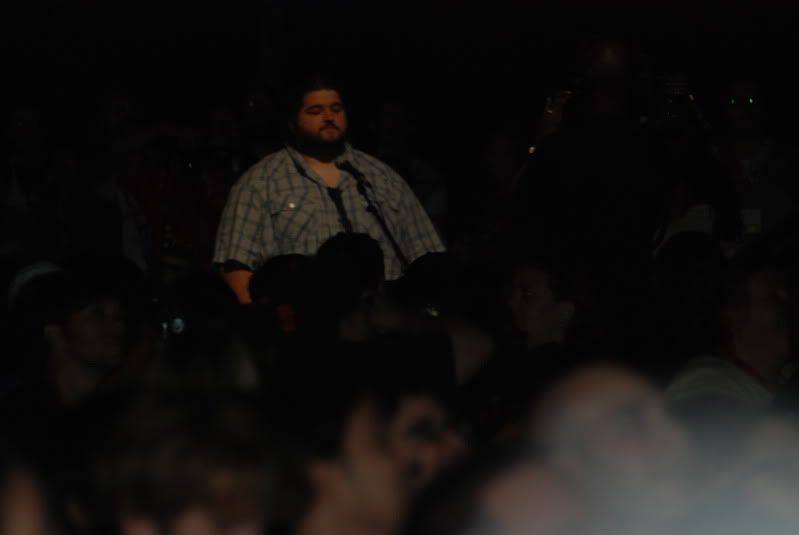


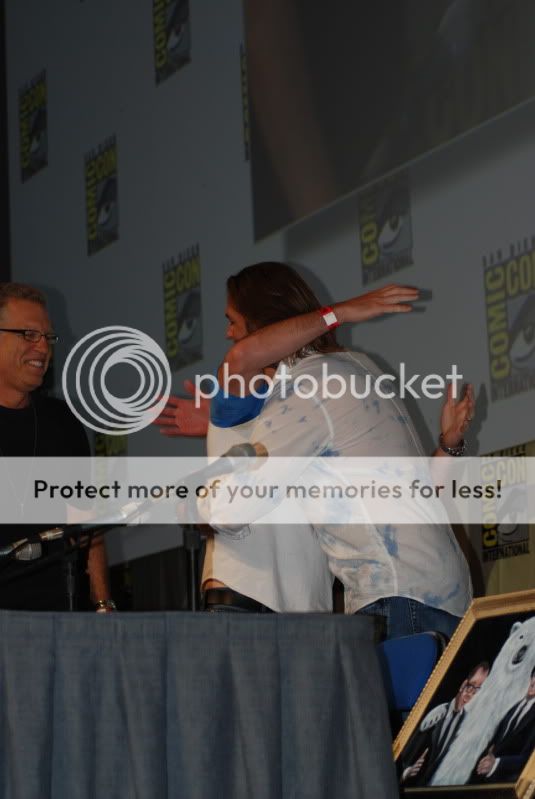







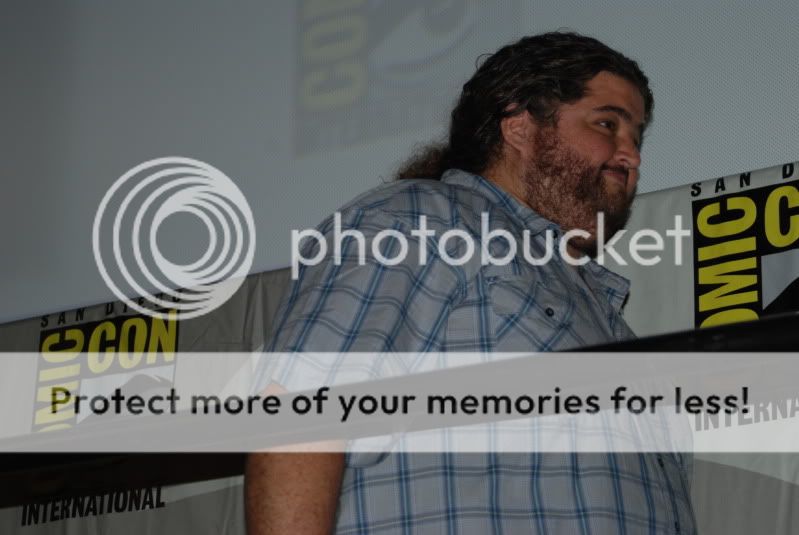
Futurama!
Moderator: Bill Morrison (Bongo Comics)
Panelists: Claudia Katz (producer/writer, Futurama), Patrick Verrone (Producer/writer, Futurama), Eric Kaplan (writer/producer, Futurama), Michael Rowe (producer, Futurama), David X. Cohen (Futurama, The Simpsons), Matt Groening (The Simpsons)
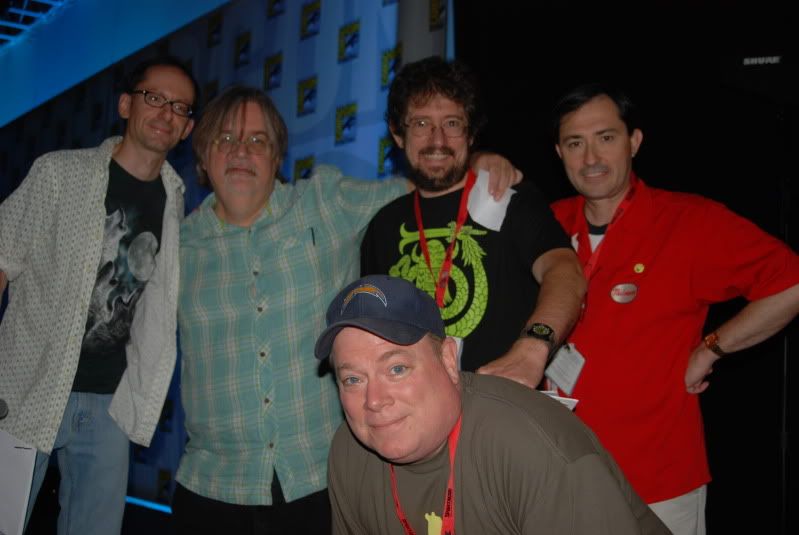
As many of you know, there has been a fair amount of controversy surrounding the return of FOX’s immensely popular animated show Futurama! due to contract negotiation issues with the actors doing the voices. The Futurama! panel was to have consisted of the voice talent, however because of the uncertainty of when and if the show would be renewed, animation and production talent appeared instead. Matt Groening began the morning by reading a humorous, sarcastic statement absolving Fox of blame for the situation. Due to time restrictions, the panelists saved time only for fan questions.
Producers showed a funny clip of Futurama! behind the scenes. (The clip is available as an extra on the DVD of Futurama!
Matt Groening: First of all we want to make it clear that we love our Futurama actors! We just hope that FOX and the actors can come to agreement ASAP. Let us continue.
David X. Cohen: We are mainly a panel of writers, and we decided to take advantage of that. S we are going to show you some samples of actual behind the scenes dialogue from writers’ room: things people have said over the years in the writers’ room that have been memorable, and we wrote index cards later. We saved them, Xeroxed them, and read them back, these are magic moments. And genuinely behind the scenes.
Example:
“We need to think about logistics?”
“What kind of logistics?”
“That’s what we need to talk about-there might not be any logistics”
“This is a light, romantic scene, so we don’t want him farting, puking and shitting diarrhea.”
“Were you nominnated for something?”
“No I’m a judge.”
“What did you judge?”
“Nothing, I forgot.” —re the Webby awards
“My monster manual is starting to smell.”
“Search for lame [on the script] going upwards.”
“Watch, it’ll highlight the whole script.”
“Inscincere compliments are still good.”
“Futurama brings the flava.”
At this point, the writers opened up the floor to fan questions, and each fan that asked a question got a prize out of the box to mimic what the Lost writers did during their panel at last year’s Comic-Con.
David X. Cohen: This is mostly Lost merchandise as prizes.
Fan: How do you guys keep continuity throughout the series? There’s a lot of references in later seasons from earlier seasons.
David X. Cohen: Fan sites, actually. We frequently consult with them, I’m proud and embarrased to say.
Fan: Beginning of the new season, are they going to end up in a random place or back home at Planet Express?
Matt Groening: David and I debated over that one. I thought it didn’t matter and that we should just start over. And David thought, no we have to address that world. So, he wore me down and that’s what we’ll do.
David X. Cohen: Exploring the story of that world wont be the thrust of the plot, we’ll get them back home, but yes we will address that world in the beginning for continuity.
Fan question: Do you guys expect to do Futurama! in theaters?
Erik Kaplan: Like puppet theaters?
Matt Groening: We’d love to do a Futurama theatrical, but we had premiere screenings at various movie theaters, we actually had one here at Comic-Con last year. It’s really fun to see it on the big screen. Hats off to the animators at Rough Draft for creating something that’s way beyond the boundaries of television, so we have watched the show on big screens. And we do plan on some work as a theatrical feature.
Fan: Will Leela and Bender ever get together?
David X. Cohen: We were right on the brink at the last season, and we will address that a little bit, but they’ll have their ups and downs in the new adventures. But of course it’s their ultimate destiny.
Fan: Is it harder to come up with jokes later in the series than in the beginning?
Michael Rowe: Can be hard at start, actually but later you learn from those mistakes. You get into the flow of the feel.
David X. Cohen: We’re at a certain point now with the show where that curve is leveling up, but someone will say, “Wait we did that in Season 3” so then we remember a hilarious joke we did and do a twist on that.
Michael Rowe: We’ll have to go back to the DVDs and change it!
Patrick Verrone: It’s actually much harder to come up with stories than jokes.
Fan: What was the inspiration for Nibbler?
Matt Groening: That was my idea of designing something cute, my Ewok.
Matt then gave this fan the uber-prize for best costume they’d seen all day.
Fan: Will there be any major characters that we’ve come to know and love next season?
Michael Rowe: I guess it depends on the actors [and the contract resolution].
David X. Cohen: We’re not going for anything big.
Matt Groening: But we’re planning to reveal the secret origin of Scruffy. He is not what he seems.
Patrick Veronne: I was home working on a script for a concept called “Twitter in the Year 3000”, which I’m working on right now. I’m hoping to involve you the fans from here at home, but that may get written out. We’ll probably call it something else because of the Twitter copyrights.
Michael Rowe: We’re going to have a shocking, unlikely relationship. Bender and Amy. It’s hot and heavy. Bender is due for a lot of it. And it even turns into marriage.
David X. Cohen: There’s a controversy about the robosexual marriage aspect of it.
Michael Rowe: Yes, it’s human/robot marriage, I heard there was Proposition Infinity to address the controversy of it. [laughter from audience—he’s ripping on Proposition 8 in California to repeal gay marriage.]
David X. Cohen: There is going to be a literal rebirthing of the show. We have another big one in the works: Ken Heeler, Zapp Brennigan, and Leela stranded together on an island.
Matt Groening: We have another one where Fry arrives early for once in his life to meet up with Leela. And Fry and the Professor get into time machine to skip over the 10 minutes so they don’t have to wait, only they go forward 10 years on accident. They keep going forward in time, hoping that eventually they’ll get into a time machine that goes bakcwards. I can’t say anymore… well all right I’ll tell you. The universe collapses. That’s all I can say.
Patrick Verrone: [Off-topic—all the panelists got a Hershey’s kiss during Comic-Con.] I disovered you can turn a Hershey’s kiss into a gelatinous blob.
Erik Kaplan: Someone here has a figurine of Judge Sotomayor.
Fan: Are you guys planning on doing any more mythology episodes?
David X. Cohen: 100% chance. Definitely, it’s in the works!
Fan: Simpsons episodes tend to parallel other works. Does Futurama parallel sci-fi?
Matt Groening: Yeah, we tried to do a bit of that. To create a broad enough sci-fi universe to have fun with all sorts of sci-fi. But we didn’t want to do parodies, although we did do our Star Trek episode with the original cast. But mostly, we keep it to a lot of references to literary science fiction.
Fan: Is there a Zoidberg story in the works?
DXC: That is an episode we want to do this year. Why did the Professor hire Dr. Zoidberg? We want to do the origin of them meeting many years ago. Yes, although it’s the Professor who will mainly star in the episode, we still want to do that backstory as a part of it.
Matt Groening: Some guy came up to me and showed me his Zoidberg tattoo on his arm. And I was so amazed by it, I told him “I can’t believe you got that.” And the guy said, “Yeah, everybody gets Bender!”
Fan: Are we speaking to the original writers here today? Is there a difference between the Fox and Comedy Central versions?
David X. Cohen: Well, the format has changed. It’s more of a feature piece with more music, battle scenes, andepic scenes. It’s really hard to watch 90 minutes straight of jokes. You have to pace it out differently.
Michael Rowe: It’s four half hour shows in one movie, and we had to make them work.
Matt Groening: In the middle fo the third one there was a writers’ strike, so that also may be accounting for some of the inconsistency that you notice.
David X. Cohen: There were three huge events at 22, 44, and 66 minutes in the new format. There were challenges to it, but it worked to our advantage. Ultimately, it’s up to you the viewer to decide where we succeeded, where we didn’t.
Fan: What was the creative evoluton of Zapp Brennagan sleeping with Amy Wong?
David X. Cohen: Given an infinite amount of time, all possible pairings would occur eventually. This idea seemed like it would create good tension between our characters. It did. This is why Amy and Bender have their deal down the line. It creates more cross-breeding.
Fan: You’ve created celeb guest heads. Any exciting ones planned for the future?
DXC: We can’t talk about it until the actor resolution. Until the person agrees to record it, we can’t announce anything. Generic answer yes, but we do have every exciting big names planned. Ufortunately we can’t elaborate.
Bill Morrison: Any parting words?
David X. Cohen: Keep your fingers crossed. This is business, and we’re just hoping for the best. Many cast members are still around, things are good between us. Just hope for the best and it may come true.

By this point of Comic-Con, the journalists and media covering the event are running mostly on coffee, adrenaline and the never-ending desire to get sleep… someday. After three straight days of virtually no sleep, wall to wall coverage, running the marathon to get from one end of the Convention Center to the other, all while dodging nerds and egregious violations of personal space, you might be wondering what the atmosphere is like by now in the press rooms? Pretty darned silly! Check it out:

From the Press Room: Fringe

Roberto Orci, Alex Kurtzman, Jeff Pinker (series showrunners)
[ScriptPhD note: please forgive us for not delineating between the three showrunners for this particular part of the interview—they had to move very quickly from table to table, and it was tough for us to tell the voices apart in transcription. Thanks for understanding!]
Press question: How is the rewriting going? There was a whole conversation about it at the Paley Television Festival.
Showrunners: It’s going really well. We now know what the show is to a much greater degree. In a first season show, you’re really trying to find it, you’re trying to find the voice, trying to find what works and what doesn’t work, and like most shows that I’ve been associated with, the characters and the actors playing them start to become more one. And it’s a much easier time for writers who are joining the second season. The learning curve is much steeper. And they learn much faster. And they’re working out great. We’re just having fun with it.
Press question: Is there a plan for this season? Have you guys all sat down and…
Showrunners: We have a plot arc, a plan for this season, we have characters arcs planned for the season, and beyond.
I think in general, we’re much better prepared this season than we were last season. I think it’s hard for any show on earth, you’re in the first season, you’re finding your feet. So I think it’s a major improvement for us: what works on the show, what is the balance between the A story and the B story, which characters do better in what storylines? And it’s really a trial by fire. And hopefully if things are going well, by the end of the first season, everything slots into place. And that really happened. I think we all tangibly felt by the end of the first season that the show had really found its stride.
Press question: So when you’re plottig time for the show, what are the terms that you’re using for the different worlds?
Showrunners: We say our reality and the other reality.
ScriptPhD: Do you guys mind if I ask you a sciencey question?
Showrunners: As long as you don’t embarrass us! [laugher]
ScriptPhD: Promise. I represent ScriptPhD.com, we’re one of the few sites that covers science in entertainment. Really enjoyed the panel with your writers and your science advisor Ricardo Gil de Costa. He talked a little bit about his role, and I wanted to get the reverse, straight from the horses mouths.
Showrunners: Which one of us is the horse in that equation?
ScriptPhD: It’s just a saying!
Showrunners: It’s a collective horse.
ScriptPhD: It’s a collective horse, a proverbial horse. Tell me a little bit about how you use Ricardo’s expertise, and how that works in the mix of the science that you approach and obviously you are entertaining first and foremost?
Showrunners: We are entertaining first and foremost. We made a rule very early on that our show would not have aliens. Because The X-Files had done that so well. And we made another rule that all the science would be plausible, based on the science that’s currently accepted or at least proto-science. So the stories come from two different directions. One, we’ll come up with an idea that we really love and we’ll say, well, make the science work. Or, we’ll start with the science and ask where the story is in this.
ScriptPhD: And what role will Ricardo play in this process? How will you use his expertise?
Showrunners: Basically, it’s educating us about the language of the science, that we can rip creatively on it. You want to use the terms that are—we cheated, we tried to make it evocative and creative. So we’ll start with an actual article, actual reasearch, actual cases, and let that inspire us. As opposed to making stuff up. Everything that you’ve seen on the show has had some article that was the basis of it. You can see on any mainstream website or news outlet, the science and technology section has some very strange stories. It used to be that you really had to search these things out. And now you really can look at mainstream science and be inspired to imagine this really great stuff.
Press question: One of the things that makes it really successful is the science. Some people have asked about the romance, which for me personally is a bit too soon. In the second season, where are we on the Peter/Olivia romance?
Showrunners: I think we’re in a place where—I assume you’re talking about Josh and Anna—they’re more familiar. It’s more brotherly and sisterly right now and more of a caretaking role. As we go into the second season, our stories are starting to be driven by the characters as opposed to outside in. And if you saw our season finale, Olivia ended up in the other universe, and she’s going to come back, and there’s going to be consequences of what’s been done to her and what’s been happening to her. And she, in many ways, is going to become affected by the cases and this world. And he’s going to have to take more of a caretaker role towards her. It’s also very important for all of us that in doing a romance, you have to buy it. The characters have to organically get to a place where you would believe it. As opposed to forcing them together just to do it. Olivia’s character has so many walls. She was in love with someone who burned her badly, so she’s going to be very unwilling to trust again. And Peter has his own issues too. So I think if we do it, we really want it to happen organically, so that the fans buy it.
J.H. Wyman (writer/co-executive producer)
J.H. Wyman: Well, I’m the showrunner, with Jeff Pinkner, just so you know.
ScriptPhD: With Peter, how much are you going to go into the two realities. This reality versus the other reality? And where are you going to go with that?
JW: I can say that Peter is actually going to learn a lot of things about his existence, who he is, what’s going on, we’re going to delve into many things that will bang Peter out as a character. And make him the hero I think he wants to become. That’s all I can say about it.
ScriptPhD: But you are eventually taking us on a path where we’re going to learn about all of this?
JW: Look, you watch the program so you know that there’s enough answers in there to—I mean, it’s amazing the theories that people will come up with. It’s really quite wonderful. But yes, we’re definitely going to be able to delve into that and talk more about what we’re investigating in Fringe.
Press question: So we know there was this other reality Peter. Well, we think so. Is there another reality massive dymanic that enriches the world? Are we going to learn more about that?
JW: I would say that’s an interesting theory. I don’t mean to sound cagey about it. I think there are certain things the fans are trying to work out and figure out and the direction that we’re going down right now absolutely follows that line of thinking. But I don’t want to be cagey about what you’re going to see, but I promise it will really play your mind, because it does mine. It’s fun, you know? Really fun!
Press question: Any clues?
JW: Let’s talk about how the show is different, and there’s so many clues in that. Let’s talk about why it’s Fringe 2.0 instead of the original, and why it’s getting better I think.
Press question: So we know there’s not going to be aliens, what other things can we expect that we haven’t seen yet, as far as the fantasy and science fiction minus the aliens?
JW: It’s funny you should say that, because we literally made a whole—you know at the beginning, there’s the words, and we’ve done most of those words. Now, we’ve come up with a whole bunch of words—there’s many things beyond alien that you’re going to see that will frighten you and hopefully make you think science is dangerously out of control. But what’s really important, and the key to the characters and what’s happening this year, and why the show is different this year as opposed to last year, is that we’re actually—I would consider the first season a prologue, that’s my take on it. Here’s the show, here’s what you’re going to be doing with it, here’s the things that are happening, science is out of control, much more advanced than you would even imagine, here are the characters and the players. Now the second season is: let’s get involved into these people’s lives. And I think that that is the key to all the questions that you were asking. You’re going to fall in love with it. Like this year, Walter’s emancipation. He’s going to come out and come into his own and Peter’s going to have to let him, it’s really delicious stuff you know? Olivia’s going to start to develop in her own way, Peter in his own way, things that you never imagined you’d get to spend time with them, like last year in their houses and this year you will.
ScriptPhD: Like the relationship between Walter and Peter will develop.
JW: Oh, that’s one of my favorite things, yeah!
ScriptPhD: I really love that part of the show!
JW: I’m so glad you say that because it’s a big part. Yeah.
Press question: You just started shooting in Vancouver, just like another show, Supernatural. Can you talk about what that’s been like?
JW: We were in New York, and just cost-efficiency wise, we brought it to Vancouver. They allowed us to do much more. Because our money goes further, because of the Canadian dollar, and the production value goes up. The things that we’re planning to do this year really do take a certain amount of finance and fiscal responsibility to be able to do, so we figure we can definitely get much more money to do them. And we’re ecstatic. It was a smooth move, all our keys are still with us, and we found great people there, the nicest people ever. You can’t imagine. You go there and they’re just the sweetest people.
Press question: How much does the fans’ reaction to the show influence you in writing it?
JW: A lot. For me. I did read what they said about Season 1, going into Season 2. Because you have your own perceptions as a writer. You look at it and you’re going, “This is the story that I’m compelled by. I love the science and I love all that stuff, but what do I like?” And then when you start to write from that spot, you start to realize, oh when I’m really telling the truth, everybody responds. And people seem to pick up on the smallest little things. So I say, “Oh, everybody loves Walter in this! Oh, they love that moment.” And you realize that that’s something that you wanted to investigate so let’s do that. And I’m always looking at what they have to say, because that’s why we’re doing this, is so people can discover the program. And I still think not enough people have. And it’s really something, what the show is. The more that I can hear from the viewer, the more that I can do my job. Because, it’s not to write for them, but they’re a parter of sorts. I don’t want to write a show that fifteen people watch.
ScriptPhD: That’s really refreshing, because there are other showrunners [no names shall be mentioned ?] that are like, it’s my vision, it’s my show…
JW: No, no, no. I’m much more secure than that! I certainly have a vision…
ScriptPhD: I’m just amazed, because I’m a fan and a journalist and it’s really refreshing to me that when I watch the show, I know there’s a symbiotic existence between you and your fans, and a synergy there to make the show possible, and I think that’s just terrific.
JW: I did a very small program in the UK called “Key and Eddy”, a show in London. And I did it in 2001, and I still get people calling and asking what I was thinking for the rest of the show, because it only ran 13 episodes. And it left kind of a big question mark. It was very much ahead of its time. They still email and call and say this or that, there’s a whole movement, and they’re there. And it’s so hard these days to find time for appointment television, and the point is that when you’re asking someone in this busy time to commit to your show, the five minutes that they have in their day, I want them to feel like they are appreciated.
Anna Torv (Olivia Dunham)
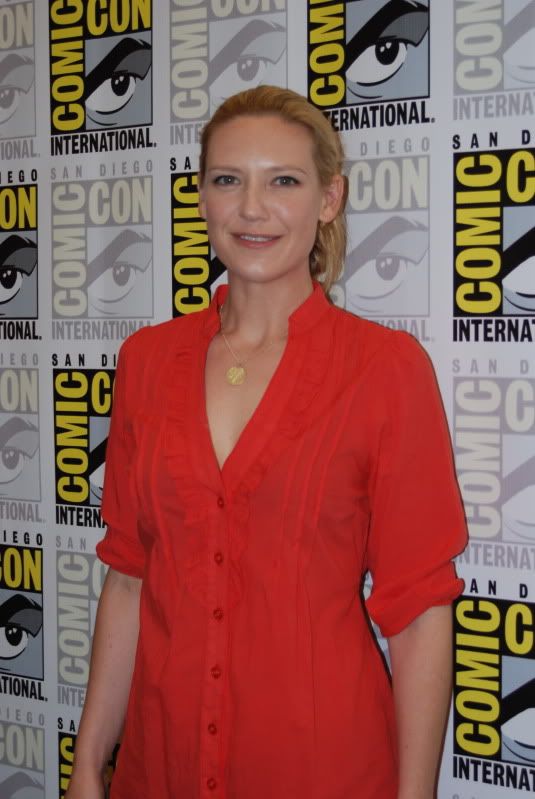
Press question: Do we get to see more of your superpowers next season?
Anna Torv: I know for sure that we will.
Press question: Are they going to have a darkness to them?
AT: Oh I hope so! I want Olivia to get darker, I think. I kind of like the dark Olivia the most. I like the episodes where something personal has happened to her, like when she was taken and had her spinal tap and she came out and she was ready to kill someone. Or when she was killing people in her sleep. I like her darker.
Press question: How long have you been living in the United States, and have you been hanging out with any of the other Australian actors here?
AT: I didn’t live in the States at all until I did the show, so I’d been over and visited a little bit, and had met with agents to see if I could get representation, but I never lived here until I moved to New York for the show. I moved over a year ago. I don’t know any of the other actors, I missed out on all of that, because we were based in New York. I heard that they have all these barbecues and things like that.
Press question: So is Australia still home for you?
AT: Yeah. I go back every break I get. I love Australia!
Press question: Do you get used to the hectic, frantic work schedule a show like this requires?
AT: Yes, I think you just do get used to it. And it’s—I love it when I get to do physical stuff, which I don’t get to do a lot of, actually. I think it looks like I get to do more than I actually do. But really, I don’t get to do that much! No, I’d like to do more of that, sure!
Press question: How are the scenes shot with Leonard Nimoy at the end of last season going to play into this season?
AT: No, I do know, but I can’t tell you. But you do get to find out. So you do eventually see the rest of that scene, but in a really cool way, actually.
Press question: Do you have anything that’s happened to you like that in your past like Olivia, from your childhood?
AT: You know, someone just asked me that! No, there’s nothing that I can think of! I’m sure if I really thought about it, but no.
Press question: Can you talk a bit about your hobbies and lifestyles and what you like to do?
AT: When I’m not working! [laughs] Well, I’m from Australia, so I surf, and I grew up near the beach and we always had horses. I love riding horses! I keep trying to get them to do something where Olivia gets to go jumping or something. I don’t know, I hang out. I’m a homebody.
ScriptPhD: Are you excited about where Olivia’s relationship with Peter is going, and can you talk about working with Joshua and your guys’s dynamic?
AT: Well I know! Everyone keeps saying what’s going to happen with Peter and Olivia? And I’m like, “Did you watch the first season? He started picking up my sister!” I’m not sure where I want them to go. I just read an episode that we haven’t started shooting yet, we’re about to start shooting next week, and Olivia starts to see Peter a little bit differently. And I think it’s kind of fun! I can’t say anything more. That’s it!
Press question: Can you talk about being glamorous on the show and yet, still playing a strong woman character?
AT: I don’t know, I think they don’t write her glamorous, but we’ve always been—like when we started with the pilot, we were always adamant that it’s TV, so nothing’s really realistic, but you can do your best. Like she doesn’t wear a lot of lipstick and I don’t know. You do what you can.
Press question: What have you loved about her vulnerability aside from a lot of the action that you’ve gotten to see?
AT: I love the episode where she dreams, which was where she starts having these dreams where she’s killing these people and then she finds out. I love that because I thought it was a really beautifully written episode, and I thought it was one of my favorite bits of Fringe, and I personally loved the shadowy, secretive, dark, what’s going on stuff. It also was where she found out about the early experiments and Walter did that to her. I loved that because through a lot of the first season, I felt like there wasn’t a real personal connection with Olivia and Walter and now, all of a sudden, there’s something there beyond just what we were experimenting on.
Press question: And will that come into play this season?
AT: We haven’t gone back to it as intensely as we did at the end of the last season, but it’s definitely still there and I think it will pop up again.
Press question: Is there an awkwardness to your and Peter’s relationship now when you’re working on cases because you know that?
AT: Sometimes, yeah. Sometimes.
Jasika Nicole (Astrid Farnsworth)
Press question: I heard rumors that we are going to see more of Astrid in the season to come?
Jasika Nicole: If you heard it, and I heard it, it must be true! Astrid, you’ll get to see a softer side of Astrid. She was often the person put up against Walter because they were so different—the young, the old, the new technology versus the old, book-savviness and everything. So we would have these funny quips, but she’s more than just that. I think that her purpose, at least in this season, is more than just providing some comic relief and one-line quips. And so she has this really fantastic scene that we filmed the other day with Walter where you get to see their personal relationship. You get to see why they click and work so well together. It’s not because she rolls her eyes at him all the time. Which she does, that’s certainly a part of her, but she’s also much deeper than that. I’m hoping that you get to see more than that—her connecting emotionally with the other characters on the team.
Press question: let me just say this. It is so great to have a person of color have such a smart and intelligent role. You don’t see that on television—
JN: And how!
ScriptPhD: And that it’s not a big deal! It’s just a part of who she is, but it doesn’t have anything to do with her abilities.
JN: Yeah, totally! It’s like, “You got into college?!”
Press question: What are we going to find out about Astrid’s history and how she got to the place she is?
JN: You know, these are all questions that I don’t have answers to, and I’m hoping that they do get answered at some point. I want to know why she decided to become an FBI agent and where did she come from and I want to know those things. I wish I could say for sure that yes, it’s going to happen, but I will say that we have brought another person into the Fringe world. Her name is Megan Markel, and she plays an FBI agent, and she is also bi-racial. Let’s talk about that. It’s awesome! And I was so excited, because it wasn’t like, “Oh we can only have one. Oh we can’t have more than this one actress.” Like you said, it was no big deal. Here’s this gorgeous woman on the show, and she’s really, really smart too, and she’s an FBI agent, it’s just awesome.
Press question: I think it’s great to have people like you on the show, because science and technology are becoming so wide-spread and it’s a wide demographic, it’s great to show that anyone can really be a part of this world. What integrated storylines can you talk about given what you’ve already shot?
JN: Thank you so much. With this new character, and I can’t speak about her too much, obviously, but we’re actually going to start talking about the aspect of religion, and how you balance that out with science, which has kind of been a battle of ideologies for a really long time. So we start to address that in this season. We’ve only completed three episodes, so we don’t know how far it’s going to go, but I really like it, because it’s really exciting! What do you do with your faith that you have grown up with and is a huge part of you, and then how do you combat that against these things that are happening and all this death and destruction? You hear that someone is in charge of it and it’s not the God that you’re familiar with, so I think that’s a really cool thing that we’re starting to incorporate into this season. I have no idea where it’s going to go.
ScriptPhD: Reading the scripts and seeing the science material, do you ever just geek out? Normally as an actor, normally you don’t get to do stuff that’s this heavy and technical. Do you ever just get to thinking about some of the issues that the show raises and it bleeds into your own consciousness?
JN: Absolutely! Oh yeah! I do a lot of Googling, because there’s a lot of words that I am completely unfamiliar with. Like, “I don’t know WHAT that is!” But I think I’m most intrigued by the idea of there being this other universe because what they’re saying with that is that as a person, you make decisions in your life, you have all these choices, and you make a decision. But you can also make the decision that you didn’t make, and so there is a world in which you exist where you made that decision. And a world where you exist and you made this decision. So it might not even be one parallel universe, it could just be tons and tons of them for every single choice that you made that is not this one, but it was that one. Which is kind of like looking through a mirror—it just goes on forever and ever! And you think about what kind of person you would be. And I guess that at some opportunity, they’re going to get to meet themselves and see what kind of person they would be if they did this and that. I made that up, I don’t know if that’s true.
Press question: Can you talk about your work schedule, given that your character doesn’t appear all the time?
JN: I think most people are pretty jealous of me. I have kind of the perfect schedule—I come in and I work for maybe two days a week, and then I just… have the rest of my time to myself. And that’s been super-important since we moved to Vancouver. We’re in this new city, and we want to explore, and see what Vancouver has to offer. I got a bike, I can ride around. It’s been a nice transition for me, because if I had been like Olivia’s character, and thrust into this situation that was completely foreign to me, and then having to work 15, 16 hours every single day for 10 months, that has really got to make you a bit loopy. And I didn’t have to deal with that. I just had to deal with my own loopiness that I had from the beginning.
Press question: When did it finally dawn on you that you had a successful show and that this was real?
JN: You know what I think it was? I think it was when the observers started showing up in real life and not on the show, and I was like, “OK, they’re trying to make this like a brand, kind of.” He’s at this game, at NASCAR, and it didn’t have anything to do with the show, they would just be filming him and putting him out there to promote this whole idea. And I thought that was kind of huge and really neat! Maybe next, we’ll have Afro wigs [to promote the show].
ScriptPhD: This is kind of your first big break-out role. Is it weird for you when people recognize you?
JN: It’s weird. But you know, no one creepy or scary or anything has come up to me. It’s only been the nicest, sweetest, most complimentary people. So it’s weird to be recognized, but then you have this really awesome conversation and they tell you their theories about the show, and you tell them yours, and then you part ways. It’s great. It hasn’t interfered in a negative way at all, which is great.
Joshua Jackson (Peter Bishop)

Press question: How has the move to Vancouver to shoot the show affected you?
Joshua Jackson: Well, Vancouver is my hometown, so in its way, it’s moving home for me. Personally, it’s actually not difficult at all. Inevitably, it changes the urban-ness of the show. It doesn’t change the urban nature of the show, but the West Coast of Canada is very different than Brooklyn, which is where we shot most of Season 1. So that changes a bit. There’s a certain bittersweetness—and this is all behind the camera stuff—eventually the television becomes the people who make it. Moreso even than the actors or the writers. It becomes a machine, and the cogs of the machine are all of us sort of doing our bit and putting in. And to move the show, we had to lose 100 people, 140 people actually, who were employed on our show. So there’s a certain degree of bittersweetness, because without their hard work, we don’t get to Season 2. And in a just world, you don’t repay that hard work with a pink slip. So I feel a bit guilty that I’m going home and that’s fine for me, because for other people that is not fine for them.
Press question: Is it still home for you, in a sense, or have things changed since you’ve been away?
JJ: Have you ever been to Vancouver? Nobody leaves Vancouver. It’s paradise. It wasn’t until I moved to North Carolina, and was in a discussion with somebody who will remain nameless because I don’t want to bag on her hometown, but it wasn’t until I moved to NC and started working with somebody and they said, “God I’m so happy to be away from home!” that I realized some people don’t like where they grew up. Vancouver is paradise! It’s a perfect, perfect place, especially if you’re an outdoorsy person. It’s heaven, so…
Press question: But it’s been getting bad press about the drug wars at the moment, no?
JJ: [laughs] Yeah, I know. Have you been in downtown LA? East Hastings is a legitimately bad neighborhood. It’s on par with any of the worst neighborhoods that I’ve been in anywhere on the planet. But if you’re not a moron, you’re probably not going to get involved in a drug shootout. Or if you’re not an addict. So there are many ways to not get involved in a drug war between the Triads and the Hell’s Angels.
Press question: To get away from the real world and to get back into our favorite virtual world [laughter], we started to see Peter bringing in a bit of his underground connections, his underground connections for the end of last season, so are we going to see more of that next season, or is it more of you using your heightened superpower?
JJ: Sha-na-na-na-na-na! I think we spent the better part of the first season why it was specifically that Olivia Dunham needed to be the leader of the Fringe world. What we didn’t do—we talked about it, we hinted at it—but we never really saw what Peter was outside of this world, because we never visit him outside of this world. He’s always assisting and investigating hits. Then, you get to the end of the first season, and Peter becomes invested in this world. And now he starts to use his powers for good rather than evil. And, he starts to invest this very shady knowledge that he has and his personal immorality. He doesn’t have a moral attachment to things being good or bad. He is presented with a problem, he comes up with a solution, it doesn’t really matter if he breaks some eggs along the way. And I think he’s sort of figuring out his humanity as the second season is going on.
Press question: Can you talk about Peter’s relationship with Walter and how will that be developed?
JJ: Well, for myself, and I say this as an actor and not a person on the show, for Josh the actor, the most important relationship on the show to nurture and maintain is the Walter-Peter relationship. John Bishop and I spent a lot of time talking about where we are in the season, and pushing and pulling, and John is an endlessly inventive guy. And we work well together. So there’s always this state of play on set. That being said, that huge reveal about Peter not being one of us at the end of the first season is inevitably going to lead to a breakup. So until the breakup, I think you want to see these guys become closer and closer and more and more into a healthy father/son relationship and then poof.
ScriptPhD: Josh, can you talk about when you first got the material. This is very different from work you’ve done in the past, especially with the science. Talk about how you reacted viscerally to the show when you first got the script, and what about this really drew an appeal for you as an actor?
JJ: Well, the initial script, which I guess isn’t too surprising given who the writers were, read much more like a film than a television show. It was a two-hour pilot, so it was long, but incredibly in-depth, and with all of these multi-layered story points where things were not as they seemed and I just thought it was really well-done and well tought-out. And having worked in television before you also have to see how this idea behind the pilot could spin out 40, 60, 80 to 100 other ideas that could be interesting. And I think this group of guys has a pretty good track record with being able to do that. And I’m a sci-fi head, so…
ScriptPhD: You are? How cool!
JJ: Yeah!
That’s right folks, you heard it here. Joshua Jackson is a sci-fi geek. See? Science is awesome!
True Blood
Moderator: Kate Hahn (TV Guide)
Panelists: Anna Paquin (Sookie Stackhouse), Stephen Moyer (Bill Compton), Alan Ball (creator/executive producer), Nelsan Ellis (Lafayette Reynolds), Rutina Wesley (Tara Thornton), Sam Tremmell (Sam Merlotte), Michelle Forbes (Maryann Forrester), Alexander Skarsgard (Eric Northman) and Deborah Ann Wolf (Jessica Hamby) and Charlaine Harris (author)
Kate Hahn: I want to introduce myself. I’m a writer for TV Guide, and I’ve worked with Alan and the cast quite a bit, I worked with them for the TV Guide cover story and am thrilled to be here. We are going to kick off tonight with very special announcement from Alan Ball.
Alan holds up True Blood: The Drink to wild applause from the audience.
Alan Ball: True Blood: The Drink is a reality now. Those of you here at the panel last year know that it’s a very specific makeup. We couldn’t make up synthetic blood, so instead we used a nice mixture of Chateau La Feet Rotschild with blood of hemophiliac royalty, Viagra, Vicodin and vodka. …and ecstasy. Unfortunately it’s illegal. All kidding aside, though, there is a True Blood drink available September 10th. And it’s basically blood orange soda from all-natural ingredients. Just in time for Season 2 of True Blood.
Kate Hahn: Anna, Sookie has gotten in a lot of jeopardy and will be in more trouble as Season 2 progresses. How has she changed this season?
Anna Paquin: After last season, she is stronger, tougher, she’s been through a lot, she’s grown up quickly, and she tends to get herself involved in situations she can’t control, in which case it is good to have a vampire boyfriend. As far as portraying her, I’m just trying to imagine going through that in two weeks, and find myself in these situations. But that’s my job.
Kate Hahn: Stephen, Sookie’s being admired by multiple vampires. Hypothetically speaking, if something were to happen between Eric and Sookie, how would Bill respond?
Stephen Moyer: It’s hard to get away from that rangy Swede at the end of the table, but I’m not sure Bill would roll over and just let it happen. He’ll fight his hardest and not be quite as polite as he’s been up to this point.
Kate Hahn: We’ve seen really big changes with Tara. What is your take on how she’s changed as more of her softer side has come out?
Rutina Wesley: I like playing the softer side of her to show her vulnerability. I call her a hard flower, because of the fact that she’s so tough on the outside but has this really soft inside, and I think it’s nice for everyone to see that part of her. She wasn’t taken care of before growing up, and this season she’s being taken care of by Mary Ann which is a nice change for her.
Kate Hahn: Alan, there is lots of action in second half of season based on the preview we just saw. How do you balance all the action and the emotions of this show?
Alan Ball: I make a joke about a sign we should have in our writers room that says “It’s about the emotions stupid”. Without that, all the action and other craziness wouldn’t have a heart and soul. So, we just work really hard to always remember who these characters are, what their passions are, what they need and are fighting for so that the other stuff has an emotional foundation. It’s one of the reason I responded so well to the books, do the same thing on the show.
Kate Hahn: Mary Anne is the source of a lot action on the show. Michelle, the fans here know you from other shows in the sci-fi genre, wher eyou have portrayed powerful women. Why does this genre in particular lend itself to these women and these characters?
Michelle Forbes: I think ultimately sci-fi as a genre offers lots of freedom to see a future [where gender is irrelevant], and I spoke about this with Mary McDonnell a lot on BSG, she’s a goddess by the way, sci-fi takes cliches out of our minds and we’re able to have a lot of freedom of thought. It’s a forgiving genre, and especially on our show, grounded in emotions. True Blood is creating an entirely new love for these genres.
Kate Hahn: Nelsan, everyone loves Lafayette. [wild cheers] But Lafayette is having some post tramatic distress disorder these days, he’s having quite a time with what has happened. How has his worldview changed since the basement incident?
Nelsan Ellis: His hustle is supreme, but in this case, he’s figured out it won’t work for him to get him out of the situation, so he’s definitely rethinking his hustle and might stop doing it. But we’ll see.
Kate Hahn: Charlaine, you and I have talked before, and something that came up was your reaction to seeing your novels visually on the show. You said “When I first saw True Blood, I had to cover eyes about some scenes.” Can you elaborate on that?
Charlaine Harris: HBO sent me a copy before premeiere, and watching some of the scenes, I went “Ahhh!” And then I called my husband and said, “Honey we’re gonna have to move.”
Kate Hahn: Sam, we’ve talked about how your character has been unlucky in love, and he has a lot in common with Daphne, but things may not be going well between the two of them. Is he gonna finally find a nice girl?
Sam Tremmell: Well, he gets a bit lucky with Daphne. He’s a magnet for abuse this year, he’s just trying to get by. His journey this year and in years to come, is really sparked by his meeting with Daphne and what she teaches him. He has to decide whether he regrets it.
Kate Hahn: Deborah, this is your first big gig in the industry. You’re not that far out of USC. And you’ve mentioned that this cast has been helpful in the transition. What scene have they helped you with in mentoring, if you can remember one in particular?
Deborah Ann Wolf: I tend to be a nervous person in general, and am actually nervous right now, so just know that I’m picturing you all in your underwear. But I remember shooting Episode 4 and I was really sick with a 104 temperature and no voice. I felt like a total failure in terms of disappointing Alan with my performance, and was doing a scene with Steve and Anna and Jim. They said “Don’t worry, you can be quiet during our sides”, and I somehow managed to squeeze it out. Their moral support helped me through. [Collective audience awwwwww]
Kate Hahn: Alex, Eric is smitten with Sookie, but no matter what happens he’s drawn to her. Why?
Alexander Skarsgard: Well look at her! I’m sorry Stephen. Eric’s been around for a long time, 1000 years. He’s gotten to the point where he’s kind of over humanity by now. He’s seen it all. He thinks humans are pathetic and naïve and yet, despite that, there’s something different about her but he can’t put his finger on what excites him. He’s curious, and of course, he wants to explain that and see what happens.
Fan: Charlaine, will season 2 affect the plots of the Sookie novels?
Charlaine Harris: I just signed a contract for three more Sookie books, so that will give us up to 2014. I don’t think I’m affected by the show because those are past books that they’re plotting from. And I’m way beyond that now, things have really changed in the plot. Eric’s got a different maker from the maker on the show. But I hope you see that as a different opportunity for two entertainment experiences.
Fan: Alexander, your character’s gone from dark to vulnerable. How has that come about and will it continue?
Alexander Skarsgard: Well, at the beginning he’s just in one little sequence on the show, his is not really a huge part, he’s just the evil vampire leader and then takes it back into the dark. I always had to defend him, that he really does have a good side to him. But season 2 has actually been great because I’ve gotten to show that. He is a bad ass, but I’m just happy to get to do different layers and go deeper and show there’s more to the character than that. He doesn’t care for a lot of people and a lot of vampires either. The ones he cares about he’s very loyal to.
Fan: For Season 3, what are you excited to do?
Alan Ball: I’m just looking forward to the fact that there is a Season 3. Partially because I just love working on the show so much. I’m excited to start exploring some of my favorite parts of the book. We have wherewolves for the first time. I’m definitely interested in Russel Edgington and the Mississippi vampires. Debbie Pelt, I think she’s kind of awesome. I can’t put Bubba into the show without it being cheesy, though, because you could never have the real Elvis.
Fan: Alan and Alex. Pink spandex. Yes or no?
Alex Skarsgaard pulls up his pants to reveal that he’s wearing a pair. Wild cheers from audience.
Alan Ball: I’d planned not to, but maybe you’ve changed my mind.
Fan: Based on the preview we just saw, was it me or was that blond hair behind Sookie?
Alan Ball: I have no idea what you’re talking about.
Fan: Alex, what’s it like to go from the entertainment industry in Sweden to America?
Alexander Skarsgard: If this was in Sweden this would be in a barn with 35 people and about 25 of them would be named Skarsgaard.
Fan: Alan, how you make musical choices for credits?
Alan Ball: “Bad Things” by Jason Everett that was a placeholder for the temporary title credits we’d made for HBO, and I didn’t know that song very well, I just randomly picked whatever country western tune I could find through iTunes. And later on, when we were constructing the credits, we wanted to use a different song, but when we went back, nothing ever worked as well as his song. For the end credits, we work with a music supervisor named Gary Calamar who also worked on Six Feet Under, and he brings us interesting choices. Sometimes a writer will put a choice in the script, other times we can’t use it because of money, other times Gary brings other options. Ultimately we try to pick what is appropriate with lyrics and what works musically for the emotion that it sells.
Fan: Sam and Regina, what about a rekindling of flames for your characters?
Sam Tremmell: I’d be excited about that.
Fan: Stephen, you will always be my Prince Valiant. Do you have any other projects going on right now?
Stephen Moyer: Thanks for Prince valiant reference. What she’s referring to is that I had to have a ridiculous mullet in 1997, and ride around on crocodiles. I’ve got a movie called Tribes of October, and I’m waiting to finalize that, and I’m doing a British film called Flutter about gambling.
Fan: What aspect of your character do you like and dislike the most?
Anna Paquin: What do I like about Sookie? I like that she says what she’s thinking, I admire that. She jumps in and gets involved even though it gets her into trouble. She means well. What do I not like? Well, if she’d been written as an unnatural blonde, I would have nice dark roots and my hair wouldn’t be shorter due to all the split ends, because I’m a very fake blonde. But other than that, Sookie and I get along great.
Fan: Will the love triangle between Eric, Sookie and Bill play out on screen as in the books?
Alan Ball: Yes.
Fan: Has any aspect of the portrayal of your character been influenced by the books?
Anna Paquin: I read them rabidly leadig up to my audition, as I wanted to know as much as I could to prepare myself for playing the character. I felt that the Sookie on the page in the script was like the Sookie in the books. It’s hard to unmarry the two. But ultimately the portrayal comes down to my interpretation and the directors and their input.
Alexander Skarsgard: I read the first five books to learn about the characters, but at some point you need to take control of the characters and leave the books behind you. We have a path and we stick to it but it’s certainly nice to get background information.
Stephen Moyer: One thing about our writers that is incredible, every time they see you play something that works, they think, “Well, if that worked so well, what if we put them in a completely different place and see what happens?” If we’ve seen them react to this, how do we see them reat to that? And it becomes more complex to play the role.
Fan: Will Jessica be more of a handful for Bill?
Deborah Ann Wolf: As much as they’ll let me.
Fan: Alan and Alex. Talk a little bit about the dynamic between Eric and Lafayett and Eric and Goddard.
Alan Ball: Obviously they’re gay lovers and spend the summer together in Fire Island. Eric and Lafayette. Their relationship is one of fear by Lafayette towards Eric for good reason, whereas Eric is intrigued by Lafayette may have plans for him in the future. Eric looks at Godrick as Godrick talks about them: father, brother, son. He is the most important person in Erik’s life, he’s known him ever since he was born as a vampire, so there’s tremendous love there. And it’s not necessarily romantic. The relationship between a vampire and his maker is deep, you can’t really understand it.
Alexander Skarsgard: That has been fun to shoot, because up until that point, Eric has been an entrepreneur, but this was on a personal level for him, going to Dallas for love and has nothing else to gain.
Fan: Question for the vampires on the panel. Anyone ever have a fang malfunction during shooting?
Deborah Ann Wolf: Well I’ll tell you, the hard ones stay in well, but the rubber ones fall out easily, so it’s kind of tough to be cool when you’re immortal.
Stephen Moyer: I spent the first two months with indentations in my mouth because the hard ones are really sharp.
Rutina Wesley: Yes, they are. [audience laughter]
Fan: Are you going to keep Jessica as a rebellious teenager or let her grow up a bit?
Alan Ball: One great thing about an extended series, you don’t have to define a character in the same place, they can grow up. I hope the series has a long life. I hope to keep everyone in their basic character as they grow. But you can expect evolution in the characters.
Fan: Deborah, is Jessica going to have a love interest?
Deborah Ann Wolf: I hope so.
Fan: Alan, will you ever have a one half vampire/human combinaton? Like a hybrid baby? [Loud boos from audience.]
Alan Ball: What? A one half vampire baby? No! In our show, they’re either full on vampires or they’re not vampires.
Fan: Charlaine, where do you get your inspiration for your books?
Charlaine Harris: I was gonna say the tabloids. Inspiration is a word I don’t trust. Writing is work and what I do is work. Some days I pull my own hair for ideas, and you wouldn’t want to be around me then. It’s just that the work takes places in my head. My contract has a deadline and if I waited for inspiration, my editor would be pretty mad at me. So I just flex my fingers and I say, “Who’s coming to Sookie’s house today?”
Fan: Charlene and Alan, what kind of demographics make the show a success?
Charlaine Harris: We aimed for an adult audience and I think we’ve hit that target.
Alan Ball: One of the great things about the beginning of the show before it had aired, HBO had tested the pilot, and it tested really high with adults of all sorts. The women love the romance and the men love the sex and violence. And since the show has aired, we have learned that it really does have wide appeal. There is a really large audience for this show. It goes across a huge spectrum.
Fan: How do you feel True Blood has impacted your career?
Alan Ball: It ruined it. I’m dead in Hollywood. It’s been really positive. But I tend not to focus on that aspect of it. This is the most fun I’ve had in a job. It’s a lot of good people, very talented, everyone is onboard to making the show as good as it can be and watching it. I’m the luckiest guy on earth.
Fan: Charlene, how involved are you in the series?
Charlaine Harris: Alan and I have a working relationship. I don’t tell him how to make the show, he doesn’t tell me how to write the books.
Fan: Michelle, what attracted you to the role?
Michelle Forbes: Any time you’re offered an entrance where you’re standing naked in the middle of the road naked with a pig, you don’t say no.
Fan: Any hilarious experience during filming?
Nelsan Ellis: Oh, so many. One episode in the future features a dancing naked dude who is 300 pounds. That was pretty hilarious. There’s one take where he fell. That was hilarous.
Fan: Charlaine, with regards to vampire blood, what’s the difference between doing V and drinking the blood.
Charlaine Harris: The age of the blood. V is from a younger vampire. Getting it from the vampire is always a much better experience.
Fan: Alex and Steven, are ou ever going to counter Godrick in a season?
Both: Yes.
It was great fun to watch the True Blook panel backstage and chat a bit with the stars of the show (Michelle Forbes, in particular, was a delight, and the ScriptPhD is a huge fan of her work on In Treatment), but the unquestioned, indesputable highlight of Comic-Con for me? Meeting and chatting with my screenwriting hero, Academy and Emmy Award winner Alan Ball. From American Beauty to the masterpiece that is Six Feet Under, Alan has redefined the cinematic experience on the big and small screen, and challenged his audience to engage in a deeper level of thinking and processing his material. Thanks, Alan, for being so very gracious and stopping by my way.

We ended an exceptionally busy and rewarding Comic-Con Saturday in an intimate press round table with the stars and producers of Discovery Channel’s hit science series MythBusters. For those of you who have not yet had an oportunity to check out this show, and are fans of great television science that entertains, it’s not too late to jump on board. In each episode, Jamie and Adam, aided by costars Grant Imahara and Tory Belleci, use basic elements of the scientific method to test the validity of various rumors, myths, movie scenes, internet videos and news stories in popular culture. It’s entertaining, explosive (sometimes literally!) and you get to learn cool science. What’s not to love? In fact, stars Jamie Hyneman and Adam Savage announced today at Comic-Con that they will be appearing on the September issue of Popular Mechanics. Fans can visit this site to enter to win one of 10 signed copies by the MythBusters themselves. Our discussion with the cast helped answer lots of behind-the-scenes about how the MythBusters episodes are filmed, where they get their source material and just how do they do that?!
From the Press Room: MythBusters


Press question: How did this all get started and how did you guys all find each other and say, “Hey! Let’s make a TV show out of having fun and blowing up stuff!”?
Adam Savage: Well, it’s not our idea. Actually, the original MythBusters creator found Jamie and I in the Spring of 2002. He was looking for special effects technicians to host a show based on busting or proving urban legends.
Jamie Hyneman: And his idea was to not just have us talk about these things but to replicate them and the fact that we build all sorts of unusual things was appropriate for that.
AS: And so Jamie gave me a call, asked me if I’d be interested in hosting it with him because he didn’t think he could quite hold the show on his own—
JH: I figured I’d find someone that was a little mit more of a ham than I am. And maybe we could bat it back and forth a little bit and it seems to work.
AS: So we shot the first pilots in the summer of 2002, and shot the first season in 8 months in 2003, 13 episodes, and then Discovery wanted 30 in the next year, and we had killed ourselves doing 13 episodes in 8 months, 6 days a week, 10 hours a day. So they said, “Maybe we need some more people to help bust myths. Let’s kill some other people!” So we brought in Tory and Carrie and Scotty Chapman, who was in that second season. And then Scotty left after the second season, basically because she wanted to do her own thing. She didn’t like the amount of time that doing television took. Since Jamie and I had worked with both Grant and Tory, Grant was somebody that we’d been thinking about for a long time that we wanted on the crew, and I’d called Tory when I’d called him and I said, “Dude, it’s Adam call me back! I’m gonna change your life.”
Tory Belleci: Well I’ve known these guys for over about 15 years. Jamie actually gave me my first job out of college doing model making. And then Adam I’d met up at ILM [Industrial Light and Magic]. He used to walk around like he had a TV show before he had one. He’d be walking around cracking jokes. I did this thing once where I took an X-acto knife blade, I snapped off the end and I glued it to my hand and put a little fake blood. He and I were working together on a model, and I kind of reached over and went, “Hey Adam, can you hand me that?” And freaked out. He was like, “Ahhhh!” And then he goes away and all of a sudden I hear everybody in the other room laughing their butts off and I walk in and he has taken a whole bunch and snapped them off and glued them to his head. And he’s like, “Heyyyyyy!”
AS: Can’t let a good idea go to waste!
Grant Imahara: I remember Tory and Adam and I were working on Matrix: Reloaded and Adam came in one day and said, “Hey! Me and Jamie got this gig! I’m gonna be flying in this lawn chair with all these balloons.” And I was like, “Heheh, you’re crazy!” So he left. And then Tory and I were working on Van Hesing about a year later and he was like, “Hey! I’m gonna join Adam and Jamie, it’s gonna be great!” And I was like, “Hehehe, you’re crazy!” And about a year after that I joined them. I’m crazy too.
Press question: Favorite myths? Maybe that you’ve done on the show and or favorite that you have yet to do—ideas that are growing.
JH: Well, favorite myth, hands down, for both Adam and I (I think) is “Lead Balloon.” Interestingly, it doesn’t involve any explosions or weapons or anything like that. But it’s—when you think about what we were able to pull off, the lead that we were using was .0001 in thickness, it was about like working with wet toilet paper, and yet we were able to build a balloon that was 14 feet across, weighed 28 pounds and it flew. And so what you have to do to pull that off is walk it through entirely in your head. And that’s how we design things. I think our greatest joy, even above all of this, is the design. It’s just a thrill, because a lot of the stuff like that hadn’t really been done before. And it’s like an adventure. It’s like climbing Mount Everest or whatever. For us, maybe it’s an adventure in our head, but it’s still an adventure that we don’t know how it’s going to turn out and it’s just thrilling.
AS: You lie there awake at night thinking through to tomorrow’s build, and thinking through, like, all the possible outcomes, including the one which took us a while to learn, which is what if nothing happens? Which is often one of the most dangerous situations that you can have. Push the plunger, dynamite’s live, nothing happens. It’s one of the most upsetting—
Press question: Yeah, that was a question I had, particularly when I watch one of the more perilous episodes, which is are there ever episodes that don’t make it to air?
AS: It’s rare. There is one story that we started working on that we stopped working on. And we won’t go near it again. What we were working with was just too dangerous and too unpredictable. And the second part is actually more important. The unpredictability is what made that story undoable. But I think that’s pretty much the only time that’s happened from us. Have you guys [Tory and Grant] had—you guys had a real problem with train suction, I remember.
GI: “Train Suction” took a long time. It took over a year to do and the reason is simply that we had to find a company that would work with us on allowing us to be that close to a moving train. A train moving at very high speeds.
AS: And then it was also a year spent not saying, “Could you get sucked off if you get too close to the train?” [laughter] Finding the right way to say that was difficult.
Press question: Can you talk about the bullet experiment? You talked about it on the panel.
AS: So, bullet drop versus fire, it’s a physics thought experiment that if you drop a bullet and fire it at the same instant in time, both bullets will hit the ground at the same time. Not including things like curvature of the earth in the equation. It’s something that we’ve always had on our list. When we get into these physics thought experiments, it’s one of my favorite things. Fertile territory. Things like airplane in a conveyor belt and swimming in syrup. We spent an entire day using a camera that filmed at 5,000 frames per second just making sure the bullet release was happening at the same time as the bullet leaving the gun. And that was the resolution that we needed to be able to watch these things happen simultaneously. An entire day doing that. And then an entire day finding the consistency of where our bullets would land so that we could know what our target zone was and what we could look for. Getting into that kind of percision over those long distances with things like guns is thrilling, but it also took a tremendous amount of mental effort to work through the thing repeatedly, work through the protocols so no one is where they shouldn’t be. Firing guns is never entertaining to me. It’s always, sure when you’re standing on the firing line and firing an MP-5 it can be a really fun experience, but you’re working with a crew, you’ve got to get the footage in, you’ve got to be safe, everyone has to be behind the line. And we all take that stuff super, super seriously.
JH: That particular story was also a good example of, you don’t really need to know how to do that. It’s kind of like, what practical use is that? Probably none. It’s the process, though, of what we had to go through that we had to figure out that intrigues us. It’s an exercise. It’s another tool in your arsenal to apply to anything. It answers questions someplace else that you may not be aware of.
AS: And just like “Swimming in Syrup” and “Airplane on a Conveyor Belt”, we know for a fact that no one’s done it. We’ve done a lot of experiments that we know other people have done. We’ve built a lot of research and our researchers are phenomenal. But then there are the ones like this, that we know when we do the final experiment full-scale, no one’s ever tried it before. We’re way out on this edge. Maybe not an edge of utility, But it is very thrilling for us to be doing that. Knowing that when someone sees this episode, when a physics teacher sees this episode, he doesn’t just have to say it’s so.
JH: There’s also another prime example of that, and that was “Polishing a Turd.” [laughter] I mean, you absolutely don’t need to know how to do that.
AS: But we’ve all done it professionally. We found polished earrings made of poo, didn’t we?
JH: But it’s about the process, and you find things along the way. We get a kick out of doing things that are so unlikely, like that. One of the things that we’re gonna be taking up here before long is a poo special. I think they were wanting to call it an excrement extravaganza. And this was another example that maybe you don’t need to know how to this, but when you start to look into it, for example, I had been fascinated with hybrid rockets that use pretty much any hydrocarbon along with nitrous oxide or some other oxidizer to make rocket fuel. So I wondered what are all the hydrocarbons that we can possibly use. Obviously you want it to be a dense one, and I went through the list, and I realized that poo is a hydrocarbon and made up of stuff that might be usable as fuel. And, it sounds ridiculous, but when you start to look into it, which I did, I found out that NASA had done quite a lot of testing on this because you’re going to Mars and you’ve got some people on board and where there’s people there’s poo. What else are you gonna do with it? You might get away with recycling your urine, but the poo is a little bit different.
AS: I think you can only eat it twice before it loses its nutrition. [groans]
ScriptPhD: Getting away from poo for a moment, I have a little two-part question about your source material. Can you talk about the process that you undergo when you choose the next myth or the next source material. And then, what is the difference between the material that just interests you because it’s cool and the material that you think is interesting and is feasible to build an episode around?
AS: Well those two things are inextricably linked. Because the show is built on all of our interest levels. I think what’s successful about the show is that we’re actually having a good time. And what we’re having a good time doing is not just blowing stuff up or getting to wear neat costumes, it’s primarily getting to satisfy our curiosity. So really the primary driver, and where a story is going to go, is what are we interested in doing? So our producer, who is the guy who goes up to Discovery and says we’re going to do a poo special and it’s going to go roughly like this, and we’ll look at that story and we might say, “Yeah I know when we first started this was the thing, but I’ve done some more research and actually this is a more interesting direction. Let’s go in this direction.” Because we know that when we’re interested in a direction, that footage is going to be more compelling.
SPhD: And what are the places that you go to to derive this stuff? Is it where your curiosity normally takes you—articles, journals, the internet?
AS: Well, I’ll give you an example. On Twitter, shortly after I started posting regularly, someone Tweeted a myth that said, “Dirty versus clean car as a myth.” Dirty car gets better gas mileage, because the dirt has a golf ball-like effect on the surface of the car and allows it to slip through the air. Dimples, in other words. And I knew, because I’ve sat next to Jamie on countless plane trips where he’s bent my ear going “I don’t know what the golf ball effect is, and why don’t planes have little golf ball dimples, and so on”, and I’m thinking, knowing that [Jamie’s] interested in that, the moment I heard this myth, it cascades into a story that I know is going to interest me. I know it’s going to be fascinating because we log these little things, these little trips, and we talk about them all the time. We’ve sat on planes where the guy behind us has said, “You guys really talk like this in the world!” [laughter]
Press question: what are Tory’s and Grant’s and Carrie’s roles in the planning of the episodes? Where do they come in?
TB: We have our own team. So [Jamie and Adam] have their own stories and then we get a whole list and we do look through them and ask, “What do you guys want? What do you want?” And if we’re really excited about a story, we’ll say “Oh what if we did this! What if we added this?” and we start building and then they’re like, “Yeah, you guys are psyched about it, run with it!” And then if it’s entertaining, we have to ask if there’s going to be enough to make it scientific and entertaining at the same time. And we do these story meetings where we just sit around and brainstorm about how we’re going to test this, or what if we added this or so on, and it just grows and builds.
Press question: So you guys [Jamie and Adam] are the cover guys, but there’s a real honest division of labor between you?
AS: Those are totally separate stories, yeah.
TB: But every once in a while, we’ll get a story where there’s a cross-over.
AS: Also, there’s stories where these guys will do preliminary work on and we’ll pick up years later and ask how they did, or we’ll be doing something that they did and we’ll ask them how they did that.
JH: A good example, if I can interject, was one that I believe has aired, which was “See-Saw Saga.” Both teams worked on this, and when I first saw this story, I went through it and said, first off, while it’s gruesome (because it involved a skydiver whose parachute didn’t open) it also was funny because he lands on a see-saw and a little girl gets launched up to ten stories in the air and walks away from it safely. Here, when you start to look at that, I start to see a lot of interesting stuff because the impact that this guy is creating is a lot of science, terminal velocity and it’s likely going to break the see-saw and all that stuff. There’s a lot of physics to consider here. The rig that we eventually try to do, shows that even if it didn’t happen, or couldn’t happen, we would try to make it happen. And the engineering involved with that was quite involved. We used CAD, we used a lot of high-end materials, we were able to invent something that hadn’t been made before. It was really quite cutting edge in its own way. And so there’s all the elements that you could possibly want in an episode in that one thing: humor, science, a lot of challenges, a lot of complexity and depth in the process.
AS: But also I have to say, and I think one of the things you were getting at, is it’s not like we get lists of things from a producer to go and do. The producer, Dan Tapster, will outline a whole season, because Discovery has to buy off a whole bunch of stories. But those outlines are the faintest of sketches. The actual construction process, the actual design process of an experiment, is driven by the team that is doing that experiment. So it’s so much more than being on-camera talent, and I think that’s one of the reasons that the show is still getting the same ratings it was getting six years ago. We’re still engaged and I think I can speak for all of us—after 168 hours of programming, we’re still having more fun now than we ever have. We feel consistenly more of a sense of ownership of the material as we go, as we get better at doing this, as we get better at spotting stories and chasing down these paths. The experimental designs just get more and more fun.
TB: We actually got a criticism from our producer, and he was like, “You know when an explosion happens (and we were looking at some past episodes), try not to triple orgasm, try not to do that. If it’s something that interests you, great, but not this over-excitement.” And we looked at each other thinking, “We actually were that excited!” You can’t hide your emotions.
GI: We’re involved with the design process of how to bust a myth, of the mechanical rigs. I think that if we weren’t, you wouldn’t be able to see that on camera, because we’re not actors. So, it’s hard to give the impression that you’re involved if you’re not involved. And so you’d like to be involved, I like to do my own research, I find the best way to sound like you know what you’re talking about is to actually know what you’re talking about.
AS: Well, I think it’s the thing I see when other networks attempt to replicate MythBusters style of show. What I consistently see is hosts that aren’t engaged with the material. And in fact, when I watched shows that I like, it’s hosts that are engaged with the material. It has nothing to do with the material itself.
SPhD: Can you offer any examples, obviously without calling someone out?
AS: I don’t wanna name names, because I don’t want to trash other shows.
JH: An example that goes indirectly at this is one of the things I never see on any of the other shows, as far as I’m aware, are tangents that sometimes go off in a different direction and when that happens with us, it’s because we have come up with some sort of a seed of an idea, and we start to go into it and then we find interesting things along the way. A lot of times, we’ll do a right turn off in some obscure direction, because we are fascinated. It’s like, “Wow, who knew that this would happen?” and I’m curious about it. And fortunately, production has learned to appreciate that this makes for something that actually has more depth to it. It’s not just picking a subject and linearly following it and busting the myth and that’s what it’s all about.
AS: I’ll give you a good example. One of the best informed to me, of the MythBusters offshoots, is ESPN’s Sports Science. That’s a terrific show. I love watching it. But I think that what they spend a half hour on would take us six minutes of screen time to explain and demonstrate. There aren’t really hosts of that show. They have an outline and they methodically go down it. And they shoot down their targets as they’re going. And I think Jamie is absolutely right. It’s those tangents where you get those—because to us, the soul of the show is just these two guys on a Sunday in their garage. What would they do?
SPhD: Well as a build-off of this answer, and your previous comment, Tory, about the mix of the science and the entertainment, who do you view as your audience? Because there are a lot of spin-offs and there’s a lot of material available now. Do you sort of feel like there’s a certain demographic that is there, and then you tailor the show to them, or do you have an idea, you go with it, and it’s a wide spectrum of people who will come?
JH: Yes, we’re actually just having fun and screwing around. It seems to work. And yes we will be premeditative about it in the sense of my previous example with the see-saw thing. We can see certain elements in it that make for a clear trail of a good story. It’s got all the makings and we’ll make sure that we have that balance in it and make it into a composition that way, but as far as tailoring to an audience? It’s pretty much we’re just believers in the honesty of the approach. We’re just having a good time, we’re exploring, it’s an adventure for us to do what we do, and while we’re aware that the cameras are there, at least in my case, it’s just a pain in the ass. I would say get out of my way.
AS: One of the surprising and impressive things about the show is the feedback we get from kids saying it’s interesting, parents saying it’s interesting, our kids like the science, science teachers saying that their Thursday morning class discussions are the liveliest of the week because of what happens on our show the night before. The National and California Science Teachers’ Association have made us honorary lifetime members. But what we love saying is that if we’d set out to make a show that was “educational”, we would have failed miserably. It’s not by design. We understand that that is the case now, and yes, we can look down the throat of a narrative and say, yes, let’s bring in this element, and let’s bring in this here, and then in the middle of that demonstration, something really remarkable might happen. We’ll go down a different path. Most shows, like Bill Nye’s and those types of shows, are demonstration shows. They describe a concept and then they demonstrate it. We are steadfastly not a demonstration show. We’re an experimentation show. Because we don’t know what’s going to happen when we’re setting up to do something. Sometimes we do, but honestly, the largest proportion of the time we’re surprised.
JH: A lot of times, we think we do and it turns out that we don’t. And that, for us, is the best thing because it means that we learned something in the process. In my sense, the biggest excitement and bonus of doing this show is what I personally learned.
AS: I’m not going to give you the result of “Dirty Versus Clean”, but the result was so shocking to us that we literally just sat there and giggled on camera. We were totally wrong and so were all the experts. It’s great!
Press question: Have you gotten any interesting feedback from academic scientists?
JH: All the time. We get insulted about things that we’ve done, we get questions. A lot of time the inquires are just, “What kind of material do you use or where did you access it?” But we’ve had pretty much any scientific institution that you can name has contacted us in one way or another with some kind of inquiry.
AS: It’s not like we actually engage in discussions where they’re like, “We think you got this experiment wrong.” Actually, I think there’s a real clear understanding in the scientific community that these aren’t publishable results we’re coming up with. But what they see that we’re doing that’s a benefit, is that we’re doing things like, we’re showing you that we were wrong about our intuition. We’re showing you that the experts helping us to make wild-ass guesses were wrong. We’re showing that science is this very messy process. We’ll spend an entire episode realizing we’ve been asking the wrong question. And that’s really important, that people see that science isn’t guys in white lab coats going, “It’s just as I expected!”, it’s people going, “What do we do now?! Where do we go from here? We got this result and I have no idea where to put it.” To show science as such a creative process.
Press question: One question that isn’t in your bios. Which of you has the most degrees piled up?
GI: Electroengineering. A degree. Bachelor’s of science.
Press question: And second question. Have you done a do-over episode yet?
AS: Oh, we’ve done dozens of do-over episodes! There are a lot of stories we’ve gone back on with new data, new material, new information. Because fans will absolutely spell it all out for us when they think we’ve got something off. And if it’s enough material for us to come up with a different conclusion, and I love that! I’m always saying, “Wouldn’t you love to watch the History Channel, and have them air a disclaimer saying “You know all those Nostradamus documentaries we’ve been wasting your life with? Turns out it’s all crap! Sorry!””
Press question: Adam, you mentioned in the panel, somebody asked about Bigfoot, and doing an episode about that, and you said, “We’re not into proving negatives.” Can you talk about that?
AS: Well, if you are going to tackle ghosts, you’re going to have two outcomes: you’re either going to find a ghost or you’re not. If you don’t find a ghost, that doesn’t mean they don’t exist. All you’ve done is proved that you couldn’t find a ghost. There’s not much that’s scientific in that. You’ve just demonstrated the negative, you haven’t demonstrated the positive.
JH: That’s the super part in supernatural. There may be something there that doesn’t fit within science or things that you can test, things that you can wrap your brain around other than being able to say, “Well, we weren’t able to find anything.” While we are at times coming up with results that are not definitive, well that’s most of the time, we’ve got a sample size of one or sometimes three, if we’re lucky. It doesn’t mean that we’re going to go off on wild goose chases after things and make statements about stuff that is out there.
SPhD: Right down the line, favorite episode to date?
TB: My favorite episode would probably be “Red Flag to a Bull.”
AS: For me, it’s “Lead Balloon.”
JH: Same.
GI: Probably the Wanted myth, where we tested the curving of a bullet. The experimental design was really fantastic.
I know you’ve been waiting for it, folks! The Day 3 Comic-Con Costume of the Day. Today was a very tough call. Compounding the fact that Saturday tends to be the busiest day at the Con, it is also the night of the annual Costume Masquerade Ball, so it definitely brings out the creativity. Our pick is a graphic designer whose costume took over two hours to put on, with some very neat results:

Please come back tomorrow as we close out a relatively relaxed last day with two amazing final panels (the inimitable Dr. Who and Supernatural) and our first visit to Hell on Earththe always packed convention floor. Good night!
~*ScriptPhD*~
]]>
